March 31, 2019
Drama Queens and Divas at the ROH: Handel's Berenice
This Berenice, which channels Georgian grotesque humour, spiked with a light peppering of present-day allusions, is thus a welcome breath of fresh air, borne aloft on the wings of uniformly superb dramatic singing in this ROH/London Handel Festival co-production.
Handel’s opera did not, however, have auspicious beginnings when it was first presented in a theatre on the very site of the current day Linbury Theatre. Appearing during the composer’s ill-fated 1736-37 season, when competitive rivalry with the ‘Senesino Opera’ was taking its toll on Handel’s health and hopes, Berenice was the composer’s shortest running production, closing after four performances with Handel reportedly ‘very much indispos’d’ with ‘a Paraletick Disorder, he having at present no Use of his Right Hand’. Apart from a brief outing in Brunswick in 1743, there have since been just a couple of enterprising student productions (at Keele University in 1985, and at Cambridge in 1993) and two recordings: Alan Curtis’s 2010 offering with Il Complesso Barocco, which followed the Brewer Chamber Orchestra’s 2003 recording conducted by Rudolph Palmer.
Setting the opera in Handel’s eighteenth century enables Thomas to present both elegance and effrontery. The powdered periwigs suggest polite graciousness, but the urbanity is tempered by a coarseness - epitomised by rudely rouged cheeks and the way the boisterous, buckled shiny shoes ride rough-shod over the central, dominating velvet banquette - which reminds us that malodorous chamber pots rather than chivalrous manners were the order of the day.
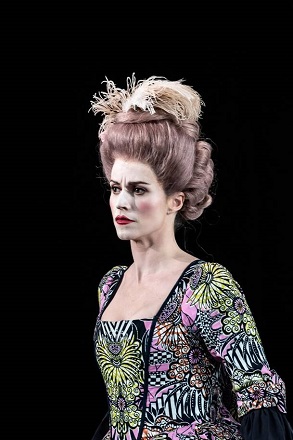 Rachel Lloyd (Selene). Photo credit: Clive Barda.
Rachel Lloyd (Selene). Photo credit: Clive Barda.
Thomas’s decision to transport the opera from Egypt 80BC to the backstage of a Georgian theatre peopled by drama queens and fawning fops is a winning one, suggestive of a political allegory of goings on at Handel’s Royal Academy of Music, whose Covent Garden productions contended with those of the rival Opera of the Nobility at the King’s Theatre. Moreover, Thomas draws upon the tradition of Georgian tragedy which, often lightened by comic contexts, frequently juxtaposed traditional and modern values within strong female figures caught between husband and father, personal desire and public duty: ‘the celebrity actresses playing these women exemplify new individual freedoms as well as their intricate negotiations of a society’s contradictory expectations.’ [1] All well and good for the #MeToo age.
First, the single gripe. Selma Dimitrijevic has provided a new English translation and judging from the few phrases readily audible - “politics is cursed” - it’s a deft text. But, in the resonant Linbury acoustic, consonants went AWOL and, in the absence of surtitles, great swathes of recitative and aria text disappeared into the hinterland. Given the unfamiliarity and complexity of the plot, this was not helpful.
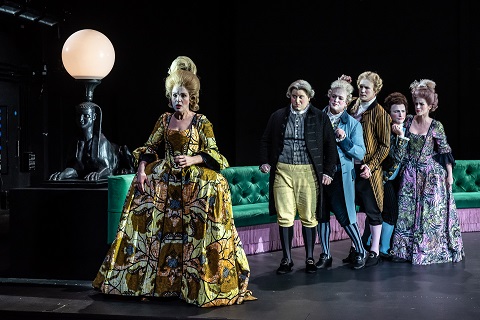 Claire Booth (Berenice), Alessandro Fisher (Fabio), William Berger (Aristobolo), James Laing (Demetrio), Patrick Terry (Arsace), Rachael Lloyd (Selene). Photo credit: Clive Barda.
Claire Booth (Berenice), Alessandro Fisher (Fabio), William Berger (Aristobolo), James Laing (Demetrio), Patrick Terry (Arsace), Rachael Lloyd (Selene). Photo credit: Clive Barda.
Hannah Clark’s very open set design, for all its focal impact, perhaps does not help. An emerald green, velvet, semi-circular sofa, adorned with a pink fringe, is the sole piece of ‘set’, seeming to extend the seating of the house itself as it stretches across the stage, set within an embracing black expanse. It houses, during the overture, a motley crew of thespians and toffs sipping Earl Grey and engaging in piquant exchanges, its peak crested with a bloomy display worthy of a psychedelic Dutch flower painting. There are a few reminders of the drama’s Egyptian roots - in the brightly hued designs adorning the regal sisters’ pannier hoops, and the two Barbary Lion gates guarding stage left and right.
The plot is a prototype cat’s cradle of romantic knots. Alessandro loves the Egyptian Queen Berenice, who is betrothed to Demetrio Prince of Macedonia - who loves the Queen’s sister Selene - but Berenice, a marital pawn at the hands of the Roman Emperor, is forced into betrothal to Arsace. Baroque amatory quadrangles are here expanded to become a pentagon of possible romantic connections between the Egyptian queen, her sister, and three potential husbands, at the heart of which two feisty and resentful sisters rage, riot and rule.
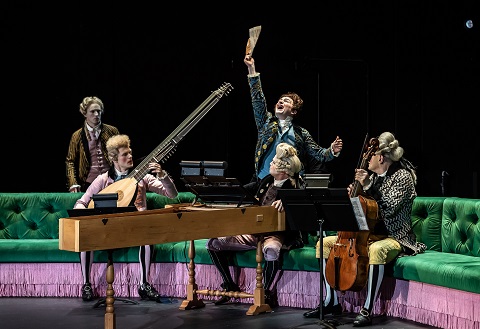 James Laing (Demetrio), Patrick Terry (Arsace) and on-stage continuo. Photo credit: Clive Barda.
James Laing (Demetrio), Patrick Terry (Arsace) and on-stage continuo. Photo credit: Clive Barda.
With the continuo trio of Mark Caudle (cello), Oliver John Ruthve (harpsichord) and Jonas Nordberg (archlute) bewigged and seated amid the action - they have their music snatched from under their noses on occasion - conductor Laurence Cummings was nestled in the Linbury pit with just strings, oboes and bassoon. This was one of Handel’s low-budget orchestrations but, in Cummings’ hands, no less vibrant and buoyant given the scant resources. Tempi seemed just right, and the lean string textures did promote the voices to the fore; that said, Cummings might have drawn greater variety of articulation and tone from the London Handel Orchestra string players.
What really made this such a terrific evening of musical drama, though, was the commitment, engagement and prowess of the superb cast. As the titular monarch, Claire Booth evinced regal righteousness and authority, and a quirky unpredictability, singing with real bite: a little brittle perhaps in her opening rejection of patriarchal command addressed to the Roman ambassador, ‘No, che servire altrui’, though topped with some fantastically acerbic cadential trills, but softened subsequently to convey the Queen’s conflicting emotions. Berenice’s Act 3 ‘Chi t’intende?’ was a tour de force of musico-psychological probing aided by James Eastaway’s delicious oboe obbligato.
Rachel Lloyd flounced furiously as the feisty Selene, dark of tone and temperament, the fioritura fiery but pristine. As Demetrio, loved by both sisters, James Laing sang with unforced strength, flexibility and expressiveness. It was really satisfying, too, to see young members of the cast finding their musico-dramatic feet: Patrick Terry’s Alsace was goofily gormless - we felt for him at the close when he was a loose end as the lovers’ tied the marital knots - though still calmly negotiating the roulades of Alsace’s rage aria, while Alessandro Fisher displayed confidence, professionalism and assurance as Fabio. William Berger was able to summon vocal intensity as Aristobolo.
Best of all, though, was Jette Parker Young Artist Jacquelyn Stucker as Alessandro. The role is less virtuosic than the others, but the pure directness of Stucker’s lyrical spinto surely conveyed the integrity of a man who puts love above self-advancement, and the elegance of the soprano’s stylish phrasing was wonderfully engaging and honest.
The singers balanced a sure sense of Handelian style - and impeccable tuning and passagework - with an individuality of expression which added warmth to what might have been a rather chilly satire. In the concluding ensemble, with the marriages of Alessandro to Berenice and Demetrio to Selene resolving the political and amatory tensions, the soon-to-be-weds sing of the joyous harmony that allows them to set aside the struggles of love and politics. Heart-warming sentiments: if only things were that ‘simple’ in real life.
Claire Seymour
Handel: Berenice
Berenice - Claire Booth, Selene - Rachael Lloyd, Alessandro - Jacquelyn Stucker, Demetrio - James Laing, Arsace - Patrick Terry, Fabio - Alessandro Fisher, Aristobolo - William Berger; Director - Adele Thomas, Conductor - Laurence Cummings, Designer - Hannah Clark, Adaptation - Selma Dimitrijevic, Lighting design - D.M. Wood, Movement director - Emma Woods, London Handel Orchestra.
Linbury Theatre, Royal Opera House, Covent Garden; Friday 29th March 2019.
[1] See The Oxford Handbook of the Georgian Theatre 1737-1832 edited by Julia Swindells and David Francis Taylor.
Photo credit: Clive Barda
March 28, 2019
Martín y Soler: Una cosa rara
First Performance: 17 November 1786, Burgtheater, Vienna.
Principal Characters:
| Queen Isabella | Soprano |
| Don Giovanni (the Prince), her son | Tenor |
| Corrado, a great squire | Tenor |
| Lilla, a shepherdess | Soprano |
| Lubino, a shepherd and beloved of Lilla | Baritone |
| Tita, brother of Lilla | Bass |
| Ghita, beloved of Tita | Soprano |
| Lisargo, chief magistrate | Bass |
Time and Place: 15th Century Spain.
Synopsis:
Act One
As Queen Isabella returns from a hunt, she is met by her son, Don Giovanni. Lilla suddenly bursts into the room, appealing for help from the Queen. She and Lubino are in love. But her brother, Tita, has promised her to Lisargo, the local chief magistrate. The Queen refers the matter to Corrado, much to the chagrin of Don Giovanni who is quite taken with the maid.
Don Giovanni attempts to woo Lilla, but she resists his charms. She confirms her love for Lubino.
As they exit, Tita enters arguing with Ghita. Lisargo follows and interrupts them. Lubino then appears looking for Lilla, whereupon Lisargo departs. Not finding her, Lubino swears vengeance if anything should have happened to Lilla. Lisargo, however, returns with his men to arrest Lubino. Alone, Ghita admonishes Tita to allow the marriage between Lilla and Lubino.
Ghita goes to the Queen's residence where she finds Lilla. They argue but are interrupted by the Queen. She sends Ghita to bring Tita and Lubino. Meanwhile, Corrado tells Lilla of Don Giovanni's love for her. The Prince arrives to renew his courting. Lilla hides when Lubino interrupts them. He asks the Prince for help. The Queen reappears and Lubino repeats his request. Tita and Ghita arrive. The Queen orders Lubino and Lilla to be released. Lilla emerges from her hiding place. To a suspicious Lubino, Corrado attests to the Lilla's loyalty. The Queen orders that there shall be a double marriage of Tita to Ghita and Lubino to Lilla. All are forgiven.
Act Two
While Lubino and Tita are purchasing presents for their betrothed, Ghita tries to convince Lilla to yield to the Prince's courtship. She enumerates the many advantages, including the acquisition of many gifts. Corrado arrives. He too urges Lilla to accept the Prince's advances. Lilla resists these attempts.
The Queen arrives with the Prince. He asks for permission to attend the wedding ceremonies. Lubino and Tita arrives with their gifts, which they present to the Queen. The Queen accepts them and gives them to Lilla and Ghita.
Don Giovanni and Corrado discuss Lilla's refusal to accept the Prince. Lilla and Ghita are looking for Lubino and Tita, who are late. In the darkness, they see two figures whom they believe are Lubino and Tita. They soon discover that they are the Prince and Corrado. Lubino and Tita arrive at that moment, their suspicions aroused.
Later that evening, they vent their suspicions, which are fiercely denounced as baseless. As all doubts are dispelled, the Prince arrives to serenade Lilla. A confrontation ensues. Lisargo comes forward so as not to compromise the Prince. In hiding, the Prince fires his pistol to prevent more of his followers from coming. Lubino and Tita attack Lisargo with the help of Lilla and Ghita. The Prince comes forth to bring peace. Tita angrily walks away, followed by Ghita.
After finding presents given by the Prince, Tita remains suspicious. Tita tries to turn Lubino against Lilla. Lubino, however, remains steadfast. Nonetheless, Tita convinces Lubino to go to the Queen to seek justice. Lubino asks who is trying to seduce his betrothed. The Prince asks Corrado not to reveal the truth. Corrado then steps forward and accepts the blame. The Queen dismisses him and orders him to be sent into exile.
Lilla and Ghita enter and thank the Queen for upholding their honor. The Queen returns to the hunt with all in celebration.
image=http://www.operatoday.com/The_young_shepherdess%2C_by_William-Adolphe_Bouguereau.jpg image_description=Adolphe-William Bouguereau: The Young Shepherdess, 1895 audio=yes first_audio_name=Vicente Martín y Soler: Una cosa rara first_audio_link=http://www.operatoday.com/Cosa_rara.m3u product=yes product_title=Vicente Martín y Soler: Una cosa rara product_by=Cinzia Forte, Luigi Petroni, Luca Dordolo, Rachele Stanisci, Yolanda Auyanet, Lorenzo Regazzo, Bruno de Simone, Pietro Vultaggio, Orchestra e Coro del Teatro La Fenice, Giancarlo Andretta (cond.).Live recording, 17 September 1999, Teatro Mancinelli, Orvieto
Boston Lyric Opera's East Coast Premiere of The Handmaid’s Tale
The Handmaid’s Tale opera was written by Danish composer Poul Ruders and librettist Paul Bentley in 2000. Like the book and the hit television adaptation, the story takes place in Gilead, a dystopian society formed by American Christian fundamentalists who assassinate the President and construct a rigid class system for women. The Handmaid’s Tale is anchored by the story of Offred, a woman who rebels against theocratic patriarchal rules through alliances and secretive friendships that she hopes will uncover the fate of her husband and child. Stories of other handmaids, the tyrannical Aunts who run the Rachel and Leah Center, the men who control Gilead, and Offred’s life in “the Time Before” complete the narrative. “Of all the projects I’ve ever done, this is the one that least needs an explanation of why we are doing it,” said Bogart. “Every once in a while, a piece of literature, a fiction, or a painting becomes so meaningful to a culture that everyone pays attention, and the culture is changed because of it. In theater and in opera we create a democratic space with an audience watching something together that speaks to what’s on the collective mind. The Handmaid’s Tale and the concerns it raises is on everyone’s minds right now.” Ruders’ score blends folkloric music, a cinematic sound world of hypnotic and ominous repetition, haunting choral singing, moments of minimalism, and duets and trios that break tenets of traditional opera. The Handmaid’s Tale boasts one of BLO’s largest principal casts in several seasons and includes nearly 40 chorus members. Jennifer Johnson Cano (BLO’s 2015 production of Don Giovanni and 2016’s Carmen) sings the pivotal role of Offred.Caroline Worra (BLO’s 2016 Greek, 2010 Agrippina and 2013 Lizzie Borden) returns as Aunt Lydia. Metropolitan Opera regular Maria Zifchak, in her BLO debut, is Serena Joy. Matthew DiBattista plays The Doctor.David Cushing is the Commander and Michelle Trainor is Ofglen. Additional performers include Chelsea Basler,Jesse Darden, Felicia Gavilanes,Dana Beth Miller, Kathryn Skemp Moran,Omar Najmi, Vera Savage and Lynn Torgrove. David Angus conducts the BLO orchestra. Set and costume design is byJames Schuette. Lighting design is by Brian Scott. Adam Thompson does projection and video design. Sound design is by J Jumbelic and movement direction is by Shura Baryshnikov (daughter of Mikhail Baryshnikov and Jessica Lange). Bogart is Co-Artistic Director of the ensemble-based SITI Company, head of the MFA Directing program at Columbia University, and author of five books. With SITI, Bogart has directed more than 30 works in venues around the world. Her recent operas include Handel’s Alcina, Dvorak’s Dimitrij, Kurt Weill’sLost in the Stars, Verdi’s Macbeth, Bellini’s Norma, and Bizet’s Carmen. Her many awards and fellowships include three honorary doctorates (Cornish School of the Arts, Bard College and Skidmore College), a Duke Artist Fellowship, a United States Artists Fellowship, a Guggenheim Fellowship, a Rockefeller/Bellagio Fellowship, and a Robert Rauschenberg Foundation Residency Fellowship. The Handmaid’s Tale performances are Sun May 5, 2019 @ 3:00pm; Wed May 8, 2019 @ 7:30pm; Fri May 10, 2019 @ 7:30pm; Sun May 12, 2019 @ 3:00pm. Tickets to The Handmaid’s Tale are $25-$182, depending on performance and seat location. Tickets are available online at www.blo.org/tickets, by phone at 617-542-6772 (Mon.-Fri, 10 am to 5 pm) or by email at boxoffice@blo.org. BLO offers a variety of discounts at each performance for students, young professionals, community members and groups of 10 or more. Contact Audience Services at 617.542.6772 or boxoffice@blo.org.
Mozart’s Mass in C minor at the Royal Festival Hall
That might seem odd, given that he proved himself very much a choral rather than an orchestral conductor, but the concerto came off best precisely because control of its direction was for the most part in the more than capable hands of pianist, Nico de Villiers. There was no doubt whatsoever that he was the real thing, offering playing both pellucid and, where required, weighty (making me keen to hear his Brahms). Insofar as he was able to lead the London Mozart Players, he did, with all the give and take of chamber music. The shaping of the first-movement cadenza offered a conspectus of that movement, even the work, as a whole. A lovely blend of ‘Classical’ and ‘Romantic’ was similarly achieved in the Intermezzo, also benefiting from fine cello playing (though a few more cellos and indeed strings more generally would have been welcome). Finely sprung rhythms characterised a finale both buoyant and directed, the LMP on noticeably better form throughout the concerto than in the choral works by Brahms and Mozart that surrounded it.
First of those was Brahms’s Schicksalslied, or ‘Song of Destiny’. Again, one would ideally have had a larger orchestra, not least given the presence of two very large choruses, the Hackney Singers and Lewisham Choral Society, but there were doubtless financial reasons for that. Ludford-Thomas certainly handled those gigantic, Gurrelieder-like choral forces well here. They offered a pleasing sound and excellent diction, clearly well trained, with convincing dynamic contrasts. The final stanza proved hard driven, though, and the orchestra was largely left to fend for itself - sometimes with more convincing results than others.
The second half of the concert was given over to Mozart’s Mass in C minor. The ‘Kyrie’ offered a largely promising start. Swift, if not unreasonably so, and well balanced - again, given the mismatch in size between choruses and orchestras - it once again offered fine choral singing, and a nice change to hear so many voices in Mozart. Alas, soprano, Elin Manahan Thomas proved parted here and elsewhere, also contributing decidedly peculiar Latin pronunciation and ornamentation. If there was nothing especially insightful to Ludford-Thomas’s conducting of the ‘Gloria’, it enabled the chorus, which was a good part of the point of such a concert. Helen Meyerhoff, in its ‘Laudamus’ section proved a more convincing soloist, a bizarrely fast tempo notwithstanding. Subsequent sections sounded more like rushes to the bus stop than moments of Rococo wonder and suffered from poor blend between soloists. By the time we reached the ‘Qui tollis’, choral intonation left a good deal to be desired. However, the teenor, Peter Davoren had some good moments.
Maybe the novelty of such large choral forces had simply worn off, or maybe they were growing tired: either way, the ‘Credo’ seemed more affected by roughness around the edges than had been the case earlier. The ‘Et incarnatus est’, which should be one of the most wondrous movements in all Mozart’s sacred music, suffered from uneven singing, plain strings, and serious disjuncture in pitch between the two; only the woodwind redeemed it. A plain ‘Sanctus’, lumbering ‘Osanna’ and perfunctory ‘Benedictus’ made for dispiriting listening.
Mark Berry
Brahms: Schicksalslied Op.54; Schumann: Piano Concerto in A minor Op.54; Mozart: Mass in C minor KV 427/417a.
Nico de Villiers (piano), Elin Manahan Thomas, Helen Meyerhoff (sopranos), Peter Davoren (tenor), Philip Tebb (bass), Hackney Singers, Lewisham Choral Society, London Mozart Players/Dan Ludford-Thomas (conductor).
Royal Festival Hall, London, Friday 22 March 2019.
image=http://www.operatoday.com/Dan-Ludford-Thomas-websize.jpg image_description= product=yes product_title=Lewisham Choral Society and the Hackney Singers at the Royal Festival Hall product_by=A review by Mark Berry product_id=Above: Dan Ludford-ThomasMarch 27, 2019
Samson et Dalila at the Met
Serbian born American theater director Darko Tresnjak envisioned a production with the look of a nickelodean (maybe you put your nickel in and out comes “Mon coeur s’ouvre à ta voix”). Or maybe he was thinking of a slot machine (bet with the odds that the tenor can’t make it to the end). He did like shiny, flowing pale blues and pinks for the intimate scenes within his arched scenic structure, intense reds and metallic blues for the big scenes trusting perhaps that these shapes and colors were enough to tell the story.
What the Met did do right was hire English conductor Mark Elder to expose the magnificence of the Metropolitan Opera orchestra, and to motivate the glories of the Met chorus whose opening scene reeked with overt Baroque-esque, old testament Romantic musical profundities that gave us enormous pleasure.
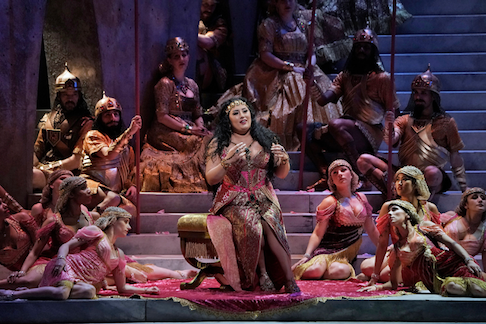 Anita Rachvelishvili as Dalila
Anita Rachvelishvili as Dalila
The stifling symmetry of Broadway designer Alexander Dodge’s scenic structure placed the singers squarely center stage for their big numbers where the artists of the evening did their best to measure up to the symphonic magnificence rising from the pit. Georgian mezzo soprano Anita Rachvelishvili well held her own in powerful voice though I missed a warmth of sensual phrasing in her two famous second act arias. A well-known Carmen Mme. Rachvelishvili did find plenty of fire in her confrontations with Samson and the High Priest.
Lithuanian tenor Kristian Benedikt, who last fall was called upon to finish the opera when tenor Roberto Alagna gave up after the second act, was the Samson at this performance (his only full performance in this 2018/19 run). Mr. Benedikt did make it all the way to the end, though he encountered some rough patches in the second act. Both his first and third act arias were beautifully rendered, his fine tenor holding strong tone to their conclusions. However in the second act and the final scene of the opera his persona and voice were swallowed into the grander trappings of the staging.
The High Priest of Dagon was sung in all thirteen performances by bass-baritone Laurent Naouri in easily distinguishable French though his delivery did not rise to the musical elegance of Saint-Saëns' score and Mo. Elder’s conducting. Note also that the back-of-seat “super” titles (very hard to see) were offered in German and Spanish. Why not French, as it is, after all, the language of the opera?
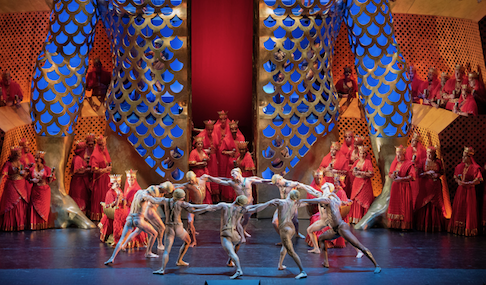 Male dancers of the corps de ballet
Male dancers of the corps de ballet
Besides the splendid second act arias the famed part of Saint-Saëns' masterwork is the third act orgy that culminates in the destruction of the pagan temple. Ten almost naked ballerinos and eight ballerinas executed a complex choreography conceived by Austin McCormick, artistic director of Brooklyn’s Company XIV. The unballetic style was Martha Graham avant gardesque, a look that flowed uneasily with the grander formal structures of the Saint-Saëns' score.
Despite the thunderous percussion climax the short circuit electric flash within Mr. Tresnjak's nickelodeon did not satisfy as Samson’s crowning moment of superhuman strength. Mr. Tresnjak’s staged oratorio setting of Saint-Saëns' score would have profited from some operatic context.
Michael Milenski
Cast and production information:
Dalila: Anita Rachvelishvili; Samson: Kristian Benedikt; Abimélech: Tomasz Konieczny; High Priest of Dagon: Laurent Naouri; First Philistine: Eduardo Valdes; Secon Philistine: Jeongcheol Cha; A Philistine Messenger: Scott Scully; An Old Hebrew: Günther Groissböck. Chorus and Orchestra of the Metropolitan Opera. Conductor: Mark Elder; Production: Darko Tresnjak; Set Designer: Alexander Dodge; Costumes Designer: Linda Cho; Lighting Designer: Donald Holder; Choreographer: Austin McCormick. Metropolitan Opera, New York, March 28, 2019.
image=http://www.operatoday.com/Samson_Met4.png
product=yes
product_title=Sanson et Dalila at the Metropolitan Opera
product_by=A review by Michael Milenski
product_id=Above: Temple to the god Dagon, with Samson [All photos copyright Ken Howard / Met Opera.
The Enchantresse and Dido and Aeneas
in Lyon
Of rich theatrical interest are the two new productions — Hungarian stage director David Marton’s Dido and Aeneas filtered though Berlin’s late, lamented Volksbühne, and Moscow-formed Ukrainian stage director and theatre theorist Andriy Zholdak’s The Enchantress filtered through the filmic lens of the 1950’s and 60’s (Fellini, Bergman). Of less interest but still of enormous pleasure was Monteverdi’s Il ritorno d’Ulisse, revived in the 1999 William Kentridge South African life-size puppet theater production, sung by members of the Opéra de Lyon young artist program.
Andriy Zholdak’s staging of Tchaikowsky’s The Enchantress is nothing less than monumental. The Enchantress is the ninth of Tchaikovsky’s eleven operas (Eugene Onegin is the fifth, Mazeppa the seventh, Pique-Dame and Iolanta the tenth and eleventh respectively). It is Tchaikovsky’s lengthiest work (just under four hours with one intermission) that only recently is finding its way into the repertory after a tepid reception back in 1887.
Mr. Zholdak makes a strong case that The Enchantress is one of opera’s great theatrical moments, or maybe it was conductor Daniele Rustioni who made the case. Working together the two artists kept their audience spellbound for the duration, the orchestra unflaggingly sustaining the unrelenting tension on the stage.
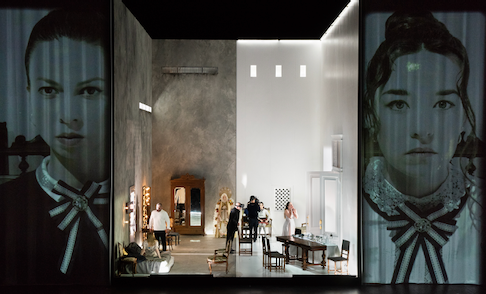 A bedroom juxtaposed to Prince's dining room, with faces of two adolescent girls seated center back watching action, video projected.
A bedroom juxtaposed to Prince's dining room, with faces of two adolescent girls seated center back watching action, video projected.
A priest, probably a surrogate Mr. Zholdak, extinguished candles in Lyon’s St. John the Baptist cathedral, climbed into a limousine to arrive at Lyon’s Opéra Nouvel (we watched this on video). Arriving onto the stage he contemplated a game of chess, a game that soon moved to the beautiful Nastasia’s humble inn where he engaged her in a game. Four hours later, a few chess boards and a card game later dressed in a green suit he batted tennis balls against the inn’s walls during the wrenching lament of the opera’s antagonist (who had just murdered his own son).
Early on the priest planted a camera in the eye of crucified Jesus then donned virtual reality goggles to watch and encourage things to go from bad to worse. The Prince’s son stopped by the inn briefly. At the mere sight of him Nastasia fell in love. The Prince stopped by a few minutes later and fell madly in love with Nastasia. Neither the Prince’s wife nor the Prince’s son could abide the Prince’s infatuation with Nastasia.
Like in a dream seemingly random images flowed hour after hour alongside, though of course they were related somehow. Location somehow shifted between Nastasia’s mean little wooden inn, the Prince’s towering, blinding white dining room, Nastasia’s boudoir, and a stone chapel with a huge, crucified Jesus. A catalogue of sexual desires were fulfilled, fantasy murders were enacted. A story was somehow told (the Prince’s wife poisons Nastasia, the son renounces his mother, the prince murders his son in a fit of jealous rage).
Tchaikovsky’s score turged on, magnificent arias, magnificent rages, ecstatic duets, huge choral climaxes (though we never actually saw the chorus). Alternative Images flowed unbound, uncontrolled by linear narrative. Zholdak’s world unfolded in an unparalleled display of theatrical craftsmanship, both artistic and technical. Tchaikovsky’s orchestral world spewed forth in unbridled emotion like no Tchaikovsky score you have heard before.
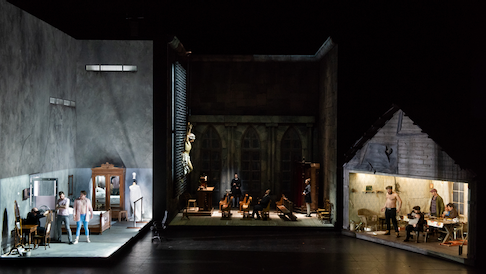 Three (of four) constantly moving scenic elements, crucified Jesus in white light.
Three (of four) constantly moving scenic elements, crucified Jesus in white light.
The Opéra de Lyon assembled an exemplary cast. Beautiful Russian soprano Elena Guseva inhabited the temptress role to perfection in beautiful, warmly Russian tone that never faltered through the punishing several hours of singing. Former Los Angeles Opera young artist, Russian tenor Migran Agadzhanyan gamely played with his teddy bear, soundly berated his mother and ardently declared his love for Nastasia in a total performance. Russian mezzo soprano Ksenia Vyaznikova was unrelentingly terrifying as the mother in music that explored the full mezzo vocal and histrionic range. Azerbaijan baritone Evez Abdulla reveled in splendidly baritonal self indulgent swagger as first the love sick prince then the tortured father.
Polish bass Piotr Micinski played the priest Mamyrov in an amazing display of body language and dramatic concentration in his constant, silent presence as the star of Zholdak’s and now Tchaikovsky’s dream. It was a performance of absolute virtuosity. Of note also was the physicality of the sorcerer Koudma sung by Siberian baritone Sergey Kaydlov. The myriad of secondary roles were sung in fearsome Russian both by Russian singers and by the French artists who appear regularly at the Opéra de Lyon.
Henry Purcell’s masterpiece Dido and Aeneas is of sufficient dramatic magnitude to command an evening in and of itself. However its brief, fifty minute duration does not fill an evening at the opera. It is an unsolvable problem.
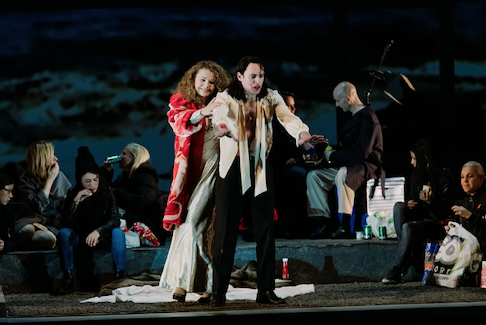 Dido and Aeneas with chorus members.
Dido and Aeneas with chorus members.
The Opéra de Lyon offered just now a novel solution — the immersion of Dido’s tragedy and Aeneas’ destiny into a larger piece of conceptual theater. Such theatrical exercise has had impressive precedent at Berlin’s Volksbühne with works like famed director Frank Castorf's dismembering of Dostoyevsky’s Insulted and Humiliated in a seven hour sitting, and Schumann’s setting of Goethe’s Faust Book II ignored in a seven hour sitting because the director decided he didn’t know what to do with it so they would simply stage something or the other on the set built for the opera, never mind that the actors had learned to sing its lines.
Volksbühne formed Hungarian stage director David Marton and his dramaturg Johanna Kobusch knew exactly what to do with Dido and Aeneas to make it into a two hour evening — they sank it into an archeological dig, building on the current scientific myth that time moves in circles. Thus you are where you have already been revealing the multiple civilizations present in Purcell's Dido and Aeneas.
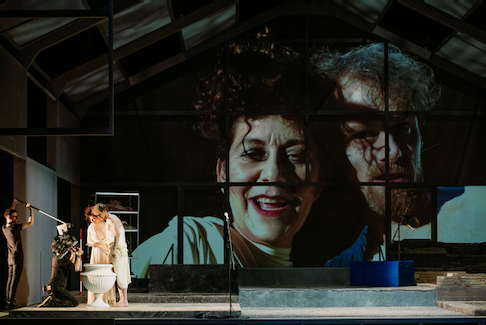 Juno and Jupiter (lower left) video projected (note presence of videographer).
Juno and Jupiter (lower left) video projected (note presence of videographer).
Cleverly Mr. Marton turned to Virgil to find lines for toga-attired Jupiter and Juno to speak while they dug in a covered dig finding artifacts of our tech age. Finnish composer Kalle Kalima created convincing noises and some fine new music from time to time to make much of the spoken episodes into a melodramma of sorts (speech with music). These spoken episodes related the adventures of Aeneas, amplifying the evening beyond the personal tragedy of the queen of Carthage to encompass a larger vision of humanity. Aeneas himself, sung by Guillaume Andrieux revealed himself not only a fine singer but also a high-style actor.
Purcell’s little tragedy did find its way into the melée from time to time, Belinda, sung by a matronly Claron McFaddon, offering sage advice over drinks to Dido, sung by soprano Alix le Saux, dressed for cocktails. A huge black period dress was provided to Mlle. le Saux for Dido’s, "When I am laid, am laid in earth," though this did not manage to support the lament which had little of the wrenching gravity that makes this aria one of opera's towering masterpieces.
There was a striking Volksbühne moment. The face of Icelandic actor, Thorbjörn Björnsson (a former Volksbühne actor), was painstakingly revealed as the dirt covering it (he was fully buried in the dirt of the excavation) was slowly brushed away by Juno (we watched this procedure on video close-up).
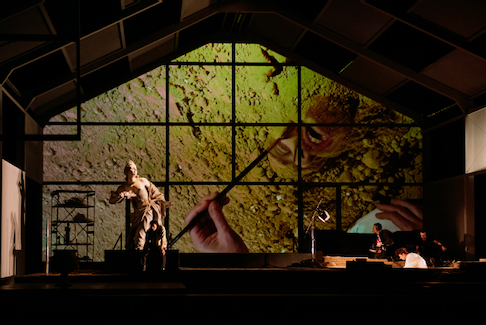 Face of buried Jupiter becoming apparent, brushed by Juno, video projected from excavation pit.
Face of buried Jupiter becoming apparent, brushed by Juno, video projected from excavation pit.
Swiss performance artist Erika Stucky (born in San Francisco) made all sorts of vocal noises pinch-hitting as Purcell’s witch plus scrunching cellophane, dragging a shovel, etc. These added bits of performance art were annoying to some of us. Many in the audience had had enough and exited the theater during her bits.
Of particular pleasure were Purcell’s madrigals, gracefully performed by members of the Opéra de Lyon chorus. These highly skilled singers articulated Purcell’s voice lines in ways that added a textural lightness through which new layers of meaning emerged. A sizable string orchestra comprised of members of the Opéra de Lyon orchestra gave a bright sound to what little Purcell we actually heard, as well as to the added intermezzos and their musical destruction by composer Kalle Kalima (dressed in a white suit, he sat with his electric guitar on a high platform in the orchestra pit). Conductor Pierre Bleuse obliged with all the necessary moods.
The production had the feel of a clique of artists who got together to do something they thought was cool. The audience at the performance I attended had little patience for it.
Michael Milenski
Cast and production information:
The Enchantresse Princesse Eupraxie Romanovna: Ksenia Vyaznikova; Mamyrov: Piotr Micinski; Prince Youri: Migran Agadzhanyan; Nenila, sa sœur: Mairam Sokolova; Ivan Jouran: Oleg Budaratskiy; Nastassia (surnommée Kouma): Elena Guseva; Loukach: Christophe Poncet de Solages; Kitchiga: Evgeny Solodovnikov; Païssi: Vasily Efimov; Koudma: Sergey Kaydalov; Foka: Simon Mechlinski; Polia: Clémence Poussin; Balakine: Daniel Kluge; Potap: Roman Hoza; Invité: Tigran Guiragosyan. Orchestre et Chœurs de l’Opéra de Lyon. Conductor: Daniele Rustioni; Mise en scène et décors: Andriy Zholdak; Lumières: Andriy Zholdak et les équipe lumières de l'Opéra de Lyon; Décors: Daniel Zholdak; Costumes: Simon Machabeli; Vidéo: Étienne Guiol. Opéra Nouvel, Lyon, France, March 24, 2019.
Dido and Aeneas Didon: Alix Le Saux; Enée: Guillaume Andrieux; Belinda: Claron McFadden; Esprit / chant / interludes: Erika Stucky; Juno / comédienne: Marie Goyette; Jupiter / comédien: Thorbjörn Björnsson. Orchestre et Chœurs de l’Opéra de Lyon. Conductor: Pierre Bleuse: Concept et mise en scène: David Marton; Composer: Kalle Kalima; Décors: Christian Friedländer; Costumes: Pola Kardum; Lumières: Henning Streck; Vidéo: Adrien Lamande; Dramaturgie: Johanna Kobusch. Opéra Nouvel, Lyon, France, March 23, 2019.
image=http://www.operatoday.com/Enchantress_Lyon1.png
product=yes
product_title=The Enchantresse and Dido and Aeneas in Lyon
product_by=A review by Michael Milenski
product_id=Above: Migran Agadzhanyan as the Prince's son, Elena Guseva as the Enchantresse [photo copyright Stolteth, all photos courtesy of the Opéra de Lyon]
March 26, 2019
The devil shares the good tunes: Chelsea Opera Group's Mefistofele
Arrigo Boito’s preface to his libretto for Mefistofele attests to the writer-composer’s own curiosity about the man who renounces a world, which nevertheless enthrals and ensnares him, as he trives to manipulate the cosmos and transcend human science and knowledge in search of a higher truth. Boito’s examples of Faustian figures include Adam, Solomon, Prometheus, Manfred and Don Quixote, and his own creations - Iago for Verdi’s Otello, Barnaba for Ponchielli’s La Gioconda, and Nerone for the opera which he laboured over for four decades but left unfinished at his death in 1918 - are evidence of his repeated revisiting of the conception of good and evil.
Opera companies in the UK have been more reluctant to revisit Boito’s own Mefistofele, however. Twenty years have passed since ROH’s 1998 semi-staged performance with Samuel Ramey taking the role of the eponymous fiend, and ENO’s production the following year in which Alastair Miles stepped into the devil’s shoes.
What accounts for this reluctance? The opera is intellectually and musically ambitious in range. Boito attempted to create an operatic embodiment of Johann Wolfgang von Goethe’s drama in its entirety, rather than, as Gounod essayed in his more famous version, just a part of the literary masterpiece. But, Boito’s first efforts met with derision: the opera in five acts framed by a prologue and epilogue which was premiered in Milan in 1868 was a failure and Boito subsequently made several revisions of the work, reducing it to four acts and excising episodes such as a scene at the Emperor’s court and an orchestral Battle Symphony. The terrain traversed is still expansive and diverse, however, encompassing a Frankfurt Square, Faust’s study, the garden of Margherita’s friend Marta, the Brocken valley in the rugged Harz mountains, a prison cell, the banks of the river Peneios - even the firmament itself. One imagines that the scene-changes required in a staged performance might result in an episodic quality.
Then, it’s probably fair to say that Boito’s creative talents were more literary than musical; indeed, some critics have accused Boito of having composed ‘a fabulously tasteless score [that] comes at you like a parody of every operatic cliché’. Moreover, a successful production requires four principal singers of considerable vocal heft and a chorus who can get negotiate tricky fugal challenges and get their tongues around some Italian patter. But, there are some glorious musical effects, terrific arias for the soloists, exciting choral writing and a strong narrative arc. As Chelsea Opera Group confirmed in this superb concert performance at the Queen Elizabeth Hall, Mefistofele does not deserve its neglect.
That this was such a compelling account was in large part due to the sustained dramatic engagement and musical commitment of the entire cast, who through their superb vocal acting turned the alleged ‘clichés’ into tours de force.
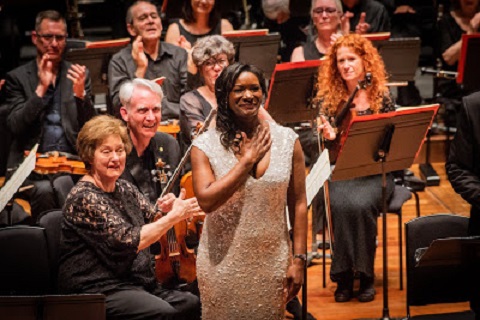 Elizabeth Llewellyn (Margherita/Elena). Photo credit: Robert Workman.
Elizabeth Llewellyn (Margherita/Elena). Photo credit: Robert Workman.
We don’t see enough of soprano Elizabeth Llewellyn on British stages. A few years ago, she was a familiar face at ENO (where she sang Mimì, Mozart’s Countess Countess , The Magic Flute’s First Lady and Micäela ), and at Opera Holland Park (Countess and Fiordiligi). But, apart from a return to OHP in 2017 to sing Puccini’s Magda de Civry , Llewellyn has found herself more frequently treading the boards of European opera houses - including at Theater Magdeburg and Royal Danish Opera - and made her US debut last year in Seattle’s Porgy and Bess . When I first heard Llewellyn sing, in ENO’s 2010 La boh ème, I admired her ‘warm, generous voice [which] easily reached the rafters of the Coliseum’, and the warmth and generosity of her lyric spinto have only blossomed more richly during the intervening years. She commanded the attention of all in the Queen Elizabeth Hall during the Act 3 prison scene, her soprano falling with a slight duskiness and rising with a rapturous sheen, the projection easy and the phrasing beguiling. If the drama of ‘L’altra notte’ was well-crafted, in the great love duet, ‘Lontano, lontano’, she spun an exquisite, gentle pianissimo; and, when she prayed to God for salvation and rejecting Faust, her dying phrases conveyed every drop of emotional intensity. The spontaneous applause that greeted ‘L’altra notte’ seemed to take Llewellyn a little by surprise, just as she had astonished those in the Hall with such powerful expressivity - an expressively which was equally captivating when she assumed the persona of Helen of Troy in the following Act.
Pablo Bemsch proved an equally impressive Faust. The Argentinian tenor has a lovely sweet sound, fresh and honest, one that is well-supported and consistent. The role is a long sing and Bemsch had the necessary stamina, if not always quite enough heft to top the COG Orchestra and Chorus in the more extravagant tutti outbursts: perhaps it was sensible not to attempt to do battle with the masses, but occasionally Bemsch’s middle- and lower-voice line seemed to slip away - particularly in Act 4 Scene 1 - into the ensemble texture. That said, this was a Faust with whom one could readily empathise. Bemsch communicated Faust’s ardour, yearning and obsessive curiosity, but also his dignity, and there was a strong sense of the passing of time and his growing distress in old age. This was a contemplative, at times introspective Faust, and Bemsch made his reveries ‘real’, particularly in ‘Giunto sul passo estremo’ when the older Faust’s dreams of universal serenity pulsed with elation.
With a dark glint in his eye, an unflinching stare, a mocking sneer twitching his lip and an authoritative physical poise, Armenian-German bass Vazgen Gazaryan was a captivating Mefistofele. He had no problem negotiating the devil’s rather faltering, repetitive melodic lines, firing the short phrases with power, pace and accuracy. Gazaryan’s firm, focused tone had a terrific ‘edge’, by turns dismissive and aggressive, and he demonstrate an assured rhythmic sense. This Mefistofele exuded unabashed conceit when challenging God in the ‘Prologue in Heaven’ but alongside brazen defiance, Gazaryan also suggested the fiend’s frustration. This was commanding dramatic singing, made more gripping by Gazaryan’s consummate knowledge of the role which he sang entirely off-score.
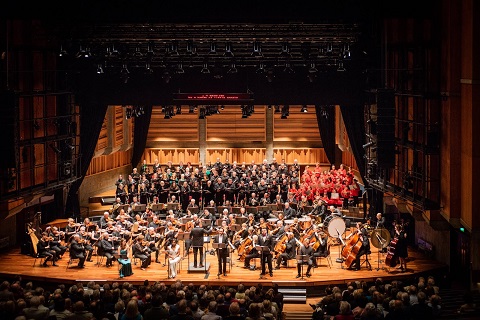 Chelsea Opera Group perform Mefistofele at the QEH. Photo credit: Robert Workman.
Chelsea Opera Group perform Mefistofele at the QEH. Photo credit: Robert Workman.
Aaron Godfrey-Mayes displayed a bright tenor as Faust’s pupil Wagner and as Nereo in Act 4; Angharad Lyddon was similarly appealing as Marta and Pantalis. The ensembles were persuasively cohesive, and there was plenty of dramatic communication between the principals.
The COG Chorus were kept busy and proved themselves up to the challenges that Boito poses. The blazing vigour of the full choral sound was impressive, though the women were less confident than the men and occasionally less secure in intonation. There was assured and consistent playing, too, from the COG Orchestra. The brass and percussion relished the explosive writing in the Prelude and Epilogue, and woodwind solos and pairings sang with shapeliness. If the fiddles didn’t quite summon a luxuriant sheen, then the string tone was well-blended and the ensemble good, with the inner voices coming through strongly.
Matthew Scott Rogers displayed a good sense of the dramatic shape of the opera. Tempi were bracing but persuasive: only in the Sabbath episode did he seem to leave a few of the chorus and orchestra trailing in his wake! He whipped up musical storms with economical gesture and means. Perhaps a little more gradation of volume would have been welcome - when it was loud, it was loud - but overall the performance had a compelling sweep.
Chelsea Opera Group should be congratulated and thanked for showing us that Boito’s devil has some of the good tunes, but not all of them: there are copious melodic and dramatic riches in Mefistofele and it would be good to hear them again in the opera house soon.
Claire Seymour
Boito: Mefistofele
Mefistofele - Vazgen Gazaryan, Faust - Pablo Bemsch, Margherita/Elena - Elizabeth Llewellyn, Wagner/Nereo - Aaron Godfrey-Mayes, Marta/Pantalis - Angharad Lyddon; Conductor - Matthew Scott Rogers, Chelsea Opera Group Orchestra and Chorus.
Queen Elizabeth Hall, Southbank Centre, London; Sunday 24th March 2019.
image=http://www.operatoday.com/Vazgen%20Gazaryan%20as%20Mefistofele.jpg image_description= product=yes product_title=Boito’s Mefistofele: Chelsea Opera Group at the Queen Elizabeth Hall product_by=A review by Claire Seymour product_id=Above: Vazgen Gazaryan (Mefistofele)Photo credit: Robert Workman
March 24, 2019
La forza del destino at Covent Garden
The Royal Opera House’s new production of La forza del destino, directed by Christof Loy and first seen at Dutch National Opera in 2017, had been hyped to the heights since the first moment it was announced that it would reunite Anna Netrebko and Jonas Kaufmann for the first time at Covent Garden since the soprano and tenor formed a triumphant threesome with the late Dmitri Hvorostovsky in La traviata in 2008. The anticipatory buzz was amplified by gossip about tickets changing hand for crazy figures on re-sale sites, speculation about which star would cancel first, and rumours that Kaufmann had been a rare figure at rehearsals, with Azerbaijani tenor Yusif Eyvazov - Netrebko’s husband, who shares the role of Don Alvaro - filling in at the dress rehearsal.
For once, though, a hyperbolic build-up did not culminate with bathos but with brilliance: consummately expressive singing which quite simply entranced and exhilarated. There is never any doubting the luxurious beauty and intense communicativeness of Anna Netrebko’s soprano but on occasion, as in last year’s Macbeth , I have longed for a little more precision to accompany the vocal glamour and shimmer. Here, however, making her role debut as Leonora, Netrebko had me transfixed with a performance in which drama was balanced by discipline, and interpretation was fired by intellect and intuitive insight in equal measure, casting a compelling vocal spell.
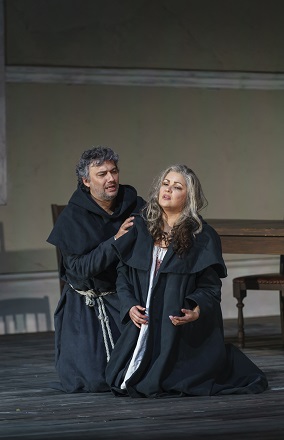 Anna Netrebko (Leonora), Jonas Kaufmann (Don Alvaro). Photo credit: Bill Cooper.
Anna Netrebko (Leonora), Jonas Kaufmann (Don Alvaro). Photo credit: Bill Cooper.
From the first gestures of the dumb-show presented during the overture, Loy places Leonora at the centre of the drama and Netrebko’s vocal and physical definition of character was riveting. Though this Leonora was painfully wracked by conflicting desires and duties in ‘Me pellegrina ed orfana’, her Act 1 duet with Alvaro had an almost fierce directness. ‘Madre, pietosa Vergine’ began with a deep darkness, blossomed sweetly, then floated bewitchingly - an exquisitely elegant mezza voce - in ‘Vergine degli angeli’. Nebtrenko rose effortlessly above the orchestra’s throbbing climaxes, while the agonising intensity of ‘Pace, pace, mio Dio’ conveyed both Leonora’s fervour and her frailty with spellbinding magnetism.
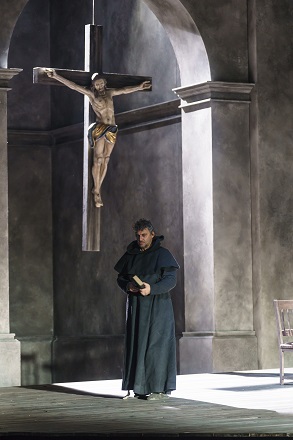 Jonas Kaufmann (Don Alvaro). Photo credit: Bill Cooper.
Jonas Kaufmann (Don Alvaro). Photo credit: Bill Cooper.
Sweeping in through a window stage-right, as if to counter any doubts about his participation with a bold physical statement of his presence, Kaufmann was a heroic Alvaro, a little restrained at the start but expanding to encompass a magnificent range, vocally and dramatically. The tenor spins a heart-meltingly lovely line, by turns ardent and tender, the lyricism charged with tragic suffering, and, as demonstrated in Act 3’s ‘La vita e inferno’, has absolute control of his voice from the most impassioned fortissimo to the softest whisper, magically grading the diminuendo at the close. Ludovic Tézier’s Carlo was no less impressive, his glowing baritone equally commanding and absorbing as he unleashed a vengeful fury which was countered by smooth lyricism in ‘Urna fatale’; the extended duets of Act 3 - in which Kaufmann and Tézier reprised a partnership first formed in Munich in 2014 - were finely wrought dramatically and musically, and utterly compelling.
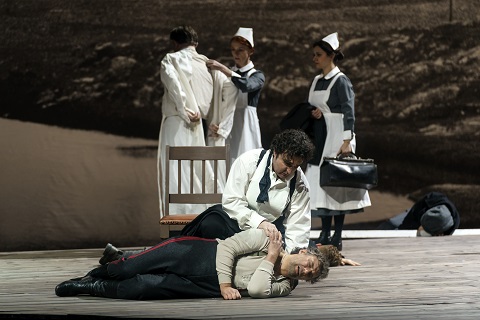 Jonas Kaufmann (Don Alvaro), Ludovic Tézier (Don Carlo). Photo credit: Bill Cooper.
Jonas Kaufmann (Don Alvaro), Ludovic Tézier (Don Carlo). Photo credit: Bill Cooper.
And, the casting luxuries did not stop there, with several singers reprising roles that they sang in Holland including American soprano Roberta Alexander who was a splendid Curra, strongly defined and impactful, and Italian tenor Carlo Bosi as the pedlar Trabuco who arrived to sell his wares with a chutzpah worthy of a Dulcamare. Ferruccio Furlanetto’s Padre Guardiano was a growling dark foil to Leonora’s sweetness, while Alessandro Corbelli was excellent as Melitone, fun but never flippant, the text clearly enunciated and gracefully phrased. It’s a shame that the Marquis of Calatrava’s death, which triggers the fateful tragedy, prevented us hearing more of Robert Lloyd’s bass which conveyed a father’s love and his demand for submission with equal conviction. And, it was good to hear Jette Parker Young Artists, Michael Mofidian, as Alcalde. Veronica Simeoni, making her ROH debut, seemed not entirely comfortable in the role of Preziosilla: though she did her best to make ‘Al suon del tamburo’ a rousing romp and danced gamely in the Rataplan chorus, sporting emerald belly-dancer pantaloons and surrounded by somersaulting acrobats in spangly top hats, she struggled to project and to reach the upper echelons of the role securely and confidently.
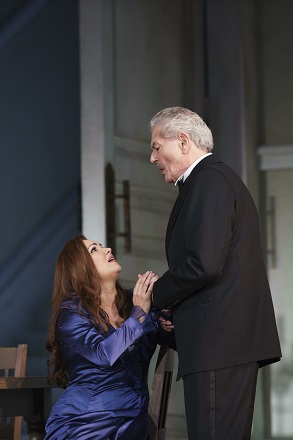 Anna Netrebko (Leonora), Robert Lloyd (Marquis de Calatrava). Photo credit: Bill Cooper.
Anna Netrebko (Leonora), Robert Lloyd (Marquis de Calatrava). Photo credit: Bill Cooper.
From the pit, Sir Antonio Pappano immediately ratcheted up the tragic intensity in a surging, heated overture, and crafted the ebbs and flows of the tragedy with consummate command. Whether carousing, warring or in devotional mood, the ROH Chorus were in fine voice and entered into the spirit of the lively, sometimes rather inconsequential, tableaux and crowd scenes.
Verdi abandoned the classical unity of time, place and action in La forza, thereby creating a headache for directors who must make varied locations spanning vast geographical distances, and visited over a period of many years, cohere. Then, there’s the problem of how to assimilate the broad humour within the prevailing tragic narrative. Rather than imposing a binding ‘concept’, Christof Loy and designer Christian Schmidt seem to embrace the disunity. The white marble walls of the Calatrava home that we visit in Act 1, subsequently fall though remnants of the mansion remain in the ensuing locales as the stage becomes a palimpsest of places and periods. Costumes allude to diverse epochs and sometimes seem designed to add to the ambiguity and inconsistency.
There are just two assertive directorial gestures, the first being an extended dumbshow during the overture. Here, atop and around the long table which slices across the floor of the Calatrava palazzo, the three main characters are seen as children. As the screen rises and falls three times, destiny plants the dart which will find its target many decades later; Leonora sits, head bowed, beside a small stature of the Virgin Mary which, enlarged and aloft, will cast a deep shadow over her life. Then, as the drama unfolds, Loy offers us recurring projections which zoom in on Leonora at the moment of her father’s accidental death; the moment which thus seals her fate. But, these ‘psychological close-ups’ are distracting and unnecessary: Verdi’s music tells us all we need to know - especially as here, when it is sung and played with such power and impact.
These directorial diversions don’t really matter, though, as the singing is so absorbing. Verdi may keep his hero and heroine apart for much of the opera, as we traverse through taverns, monasteries and war zones, but when Netrebko and Kaufmann are finally united in Act 4 it certainly feels like - if not ‘fate’ exactly - then very good fortune indeed.
Claire Seymour
Verdi: La forza del destino
Leonora - Anna Netrebko, Don Alvaro - Jonas Kaufmann, Don Carlo di Vargas - Ludovic Tézier, Padre Guardiano - Ferruccio Furlanetto, Fra Melitone - Alessandro Corbelli, Preziosilla - Veronica Simeoni, Marquis of Calatrava - Robert Lloyd, Curra - Roberta Alexander, Alcalde - Michael Mofidian, Maestro Trabuco - Carlo Bosi; Original director - Christof Loy, Associate director - Georg Zlabinger, Conductor - Antonio Pappano, Designer - Christian Schmidt, Associate set designer - Federico Pacher, Lighting designer - Olaf Winter, Choreographer - Otto Pichler, Associate choreographer - Johannes Stepanek, Dramaturg - Klaus Bertisch, Royal Opera Chorus (Chorus Master - William Spaulding), Orchestra of the Royal Opera House.
Royal Opera House Covent Garden, London; Thursday 21st March 2019.
image=http://www.operatoday.com/La%20forza%20ROH%20title%20image.jpg image_description= product=yes product_title=La forza del destino, Royal Opera House, Covent Garden product_by=A review by Claire Seymour product_id=Above: Jonas Kaufmann (Don Alvaro) and Anna Netrebko (Leonora)Photo credit: Bill Cooper
March 21, 2019
Barbara Hannigan sings Berg and Gershwin at the Barbican Hall
She was singing songs by Berg and Webern with Pierre Boulez and immediately made a great impression. Since then, she has been one of those artists I should make an extra effort to hear; not once have I been even slightly disappointed. Hannigan is, of course, most widely known as a singer, but she has been building a parallel, or rather complementary, career as a conductor in the meantime too. I heard her conduct the Britten Sinfonia in 2013, in works by Mozart, Stravinsky, and Haydn , for some of which she sang too - and once again proved enthusiastic. This concert, her LSO debut, offered a worthy successor in that line, now performing works by Ligeti, Haydn again, Berg, and Gershwin.
Ligeti’s Concert Românesc is one of those pieces we hear more than we probably ought: not in the sense that there is anything wrong with them, but rather that they seem to offer an early, unrepresentative piece by a composer who might otherwise be ignored. Webern’s Passacaglia or even Im Sommerwind would be obvious examples, even Schoenberg’s Verklärte Nacht. Hannigan is certainly not one to neglect Ligeti; one of her most celebrated performances, not least on YouTube, is of his Mysteries of the Macabre (also with the LSO). I could not help, however, but feel that this was a performance-in-progress - although it may simply have been a matter of nerves, of having come first in the programme. Even when it lacked ‘traditional’ incisiveness, as in the first section, there were gains, though, not least a sense of how close the music might sound to early Bartók, even to Strauss. Bartókian ‘night music’ of a later vintage certainly sang forth in the third section, even if the final ‘Presto’ came off somewhat hard-driven. In any case, there was much to relish from the solo work of LSO principals.
Haydn’s Symphony no.86 furthered Hanningan’s growing reputation in Haydn’s music: always a fine indicator of other strengths. The first movement’s introduction offered a grandeur and expectation that Colin Davis (thinking of the LSO) would surely have appreciated, with none of the irritations that, alas, often accompany Simon Rattle’s way with this composer. If its principal tempo were on the fast side, it was not unreasonably so. The music largely spoke here ‘for itself’, however much of an illusion that may be, the development especially well handled, the final coda a joy. Constructivism and lyricism were kept in a fruitful, generative relationship throughout in the second movement, founded, as it must be, in harmony and harmonic movement. This is music to rival Schoenberg in complexity - something most ‘period’ voices, alas, seem entirely to ignore. So too is the minuet - as soon as one listens, which Hannigan ensured that we did. Its trio relaxed harmonically and offered in tandem a winning sense of relative metrical freedom. Delightful, then, as was the finale, one of my very favourites: heard as if Leonard Bernstein had returned, albeit with greater dynamic variegation. It was as witty as it was thrilling, as convincing vertically as horizontally. More please!
Hannigan’s way with Berg’s Lulu-Suite was surprising. It took me a while to get used to, and there were unquestionably aspects of the music that went a little uncared for. That said, to hear it performed with such attention to the multifarious melodic strands - heard, I suspect, very much from a singer’s standpoint - was fascinating. So too was the relative lightness, almost Mendelssohnian, with which the first movement ‘Rondo’ was despatched. The big moments certainly told, but they were not everything. I am not sure I should always want to hear the music like this - indeed, I am sure that I should not - but to hear the classic Romantic/modernist dichotomy not so much evaded as avoided brought plenty of its own interest. Transparency is necessary no matter what the interpretative standpoint, of course; here, Hannigan and the LSO excelled. One might have taken dictation, vocal and verbal, from Hannigan’s sung contribution to the ‘Lied der Lulu’, which was ‘concert-acted’ too. Coloratura held no fear for her, but crucially, it was employed dramatically, just as in Mozart. If there were a few rough orchestral edges to the fourth movement, it is difficult to imagine them having bothered anyone but pedants. The final ‘Adagio’ emerged properly de profundis, as eloquent as if its lines were being sung. Hannigan’s melisma on ‘Engel’ truly told. Quite a performance, then, in so many ways.
The Gershwin suite with which the concert concluded proved equally fascinating - and perhaps still more thrilling. Conceived by Hannigan with the express purpose of accompanying the Lulu-Suite, its ingenious orchestration for identical forces was commissioned from Bill Elliott. As a Bergian, at times Mahlerian, soundworld unfolded, it did not jar. Quite the contrary: t drew one in, not only harmonically but also motivically, to the material of the three songs, ‘But not for me’, ‘Embraceable you’, and ‘I got rhythm’. Then, of course, there was Hannigan’s own star quality as a singer: different, perhaps, from the stars one often associates with this music, but in no sense less bright. It was sung as carefully as Berg had been, without ever sounding ‘careful’. The orchestra joined in with some vocal harmony too, but this was in every sense Hannigan’s show, ‘I got rhythm’ straightforwardly sensational.
Mark Berry
Ligeti: Concert Românesc; Haydn: Symphony no.86 in D major; Berg:Lulu Suite; Gershwin, arr. Barbara Hannigan and Bill Elliott: Girl Crazy: Suite. London Symphony Orchestra/Barbara Hannigan (soprano, conductor).
Barbican Hall, London, Sunday 17 March 2019.
image=http://www.operatoday.com/barbara%20hannigan.jpg image_description= product=yes product_title=Barbara Hannigan and the LSO at the Barbican Hall product_by=A review by Mark BerryChristina Scheppelmann appointed General Director of Seattle Opera
SEATTLE—Christina Scheppelmann will become Seattle Opera’s fourth General Director in the company’s 56-year history. Beginning in August 2019, she replaces Aidan Lang, who will become General Director of Welsh National Opera following the end of the 2018/19 season.
“When we reached out to luminaries in the opera world, Christina Scheppelmann’s name kept coming up from all angles as being someone we needed to talk to,” said John Nesholm, Chairman of the Seattle Opera Board and Co-Chair of the Search Committee. “She brings incredible experience and knowledge of singers, directors, and productions from three continents.”
Born in Germany and fluent in five languages, Scheppelmann is currently the artistic leader of the Gran Teatre del Liceu, a 172-year-old company with an annual budget of €43 million, the equivalent of roughly $50 million. The historic theater produces more than 130 performances in opera, classical music concerts, dance, and more per season.
“For many years, I have admired Seattle Opera and attended performances here regularly when I was working at San Francisco Opera,” Scheppelmann said. “In my experience, there’s a unique enthusiasm, an engaged and dedicated audience that’s always felt special at Seattle Opera.”
Scheppelmann’s accomplishments in Barcelona include an Elektra produced in collaboration with the Metropolitan Opera, Teatro alla Scala, the Festival d'Aix-en-Provence, the Finnish National Opera, and the Staatsoper Unter den Linden. She has also brought important artists to Gran Teatre del Liceu including tenor Jonas Kaufmann, director Terry Gilliam (Monty Python) for Berloiz’s Benvenuto Cellini, and composer Luca Francesconi for the Spainish premiere of Quartett.
Previously, Scheppelmann was the first Director General of the Royal Opera House Muscat (Oman), the first theater of its kind in the Persian Gulf Region. Under her guidance, ROHM established an excellent reputation as a cultural destination in Oman and opened doors for international musical and cultural relations. As Director of Artistic Operations at Washington National Opera, Scheppelmann oversaw the artistic planning for 11 years in collaboration with General Director Plácido Domingo. She was instrumental in fundraising efforts that led to grants for individual productions, ongoing projects, and specific renovations. Some of her proudest accomplishments include an acclaimed concert performance of Götterdämmerung at the Kennedy Center Opera House in 2009. She also created WNO’s American Opera Initiative. Now going on its eighth season, the program offers young composers and librettists a developmental forum in which to bridge the gap between conservatory training and full-length commissions.
In 1994, Scheppelmann was recruited by Lotfi Mansouri at San Francisco Opera, and became one of the youngest artistic administrators at the time. In addition to season planning, hiring artists and creative teams, and building collaborative relationships within the industry, she contributed to the presentation of two major world premieres: Jake Heggie’s Dead Man Walking (2000) and André Previn’s A Streetcar Named Desire (1995), which quickly became one of the most widely played contemporary operas at the time.
“Scheppelmann is the leader Seattle Opera needs to move the company into a new era,” said Adam Fountain, a Seattle Opera Board Vice President and Search Committee Co-Chair. “She’s committed to new work, to helping the art form evolve, and to telling contemporary stories. She unites both where Seattle Opera has been, and where it’s going.”
Fountain, along with John Nesholm, led a search committee made up of eight board members total. The group included the current board president and two past presidents, plus four members representing the next generation of Seattle Opera Board leadership. During the six-month process to find Aidan Lang’s replacement, the committee met with multiple staff groups, including the company’s racial equity taskforce, made up of administrative staff members from a variety of departments and levels of the organization. An artistic advisory committee, made up of musicians, artists, and backstage crew, also met with the committee and each of the final candidates.
In the Seattle area, Scheppelmann becomes the only woman to hold the top artistic leadership position at a large theater or performing arts organization (with an annual budget of more than $10 million). In the opera world, she becomes one of only two women to lead a top-tier opera company in the United States.
Francesca Zambello, Artistic Director of Washington National Opera, said it’s especially meaningful to have another woman as a leader of a major U.S. opera company:
“I think of Ruth Bader Ginsberg’s famous comment when she was asked, ‘When will there be enough women on the Supreme Court?’ Her response was, ‘When there are nine.’ Women are such an important part of the stories we tell onstage, and they are key members of our staffs, our boards, our audiences. It is high time for more women to be represented in top leadership. Christina is greatly respected across the field, and is an ideal choice to lead Seattle Opera.”
A long-time champion of young artists, Scheppelmann has led masterclasses, lectured at artist training programs, and judged vocal competitions around the world. She began her career in the arts early on performing in the children’s choir of the Hamburg State Opera. After completing a degree in banking, she left her home country of Germany in 1988 to work in an Artist Management agency in Milan.
As a first order of business at the company’s civic home on the Seattle Center campus, Scheppelmann has made listening and learning about the community a priority in order to create a vision that not only propels opera into the 21st century, but is representative of the region and its people. On a personal note, she’s looking forward to enjoying the lush beauty of her new surroundings, kayaking, and playing golf on her days off.
“Seattle Opera has already established itself as one of the great American opera companies, and it can grow even further,” Scheppelmann said. “It has a fantastic history, from more recent work, to historic Wagner productions (some of which I have seen). Seattle Opera also has a world-class opera house with great acoustics, and now, a civic home which will add fantastic value to the community. Singers love coming to Seattle Opera, because they like the company and they like the city.”
About Seattle Opera
Established in 1963, Seattle Opera is committed to serving the people of the Pacific Northwest with performances of the highest caliber and through innovative educational and engagement programs for all. Each year, more than 95,000 people attend Seattle Opera performances, and more than 400,000 people of all ages are served through school performances, radio broadcasts, and more. By drawing our communities together, and by offering opera’s unique fusion of music and drama, we create life-enhancing experiences that speak deeply to people’s hearts and minds. Connect with Seattle Opera on Facebook, Twitter, SoundCloud, and on Classical King FM. 98.1.
image=http://www.operatoday.com/ChristinaScheppelmann_Miralls_05.jpg image_description=Christina Scheppelmann product=yes product_title= product_by=Press release by Seattle Opera product_id=Above: Christina Scheppelmann [Photo courtesy of Seattle Opera]New perceptions: a Royal Academy Opera double bill
Indeed, a tale of a secluded, blind princess kept ‘in the dark’ about her affliction by an overprotective (oppressive?) father, and thus denied the life and love that might cure her, has more than a touch of Angela Carter about it. Tchaikovsky’s tale of Princess Iolanta’s physical and spiritual awakening was fashioned by Tchaikovsky’s brother, Modest, from Danish playwright Henrik Hertz’s drama ‘King René’s Daughter’, and while the libretto is hampered by some mawkish medieval allusions, any sentimentality is outweighed by the moving portrait of Iolanta’s sadness, suffering and sensuality.
Director Oliver Platt and designer Alyson Cummins suggest the young girl’s latent passion with minimal but effective means. A glasshouse bursting with verdant life intimates heated emotions and senses - colours, scents, tactility - which are the stuff of a life denied to Iolanta by the Provençal King René, who has threatened anyone who mentions sight or light with death, betrothed his daughter to Robert Duke of Burgundy (who wants out of the contract, so that he can marry his beloved Mathilde), and forbidden access to Iolanta’s garden. The ladies-in-waiting wear simple frocks that resemble nurses’ gowns, but their blue surgical gloves suggest a clinical coldness.
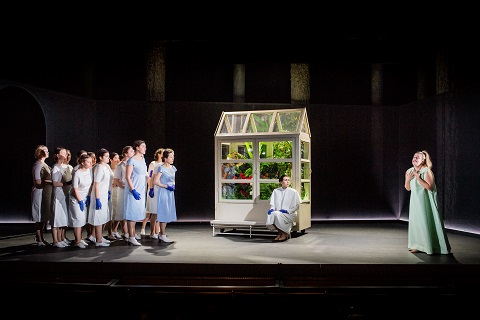 Leila Zanette (Marta, centre), Samantha Quillish (Iolanta, right). Photo credit: Robert Workman.
Leila Zanette (Marta, centre), Samantha Quillish (Iolanta, right). Photo credit: Robert Workman.
Samantha Quillish sang Iolanta’s arioso lines with delicacy in the opening garden scene, conveying the princess’s gentleness and purity, but her soprano has both depth and darkness and grew in fervency as Iolanta’s sensuality was awoken, passivity giving way to nascent but intense passion. As her father, Thomas Bennett made a good effort to strike a balance between the King’s patriarchal domination and paternal devotion, and demonstrated a pleasing bass, but one which still needs to develop a little more firmness and focus.
The two interlopers who bring light and life into Iolanta’s world brought energy and colour to the drama too. As Vaudémont - who ‘opens’ Iolanta’s eyes and to save whose life she agrees to undergo a cure for her blindness - Shengzhi Ren sang with power and ardency, and generally good intonation - just occasionally when rising to the heights he was a little under the note, but this was more than compensated for by vibrancy of tone and dramatic commitment. His extended duet with Quillish was rapturously redolent with hope and promise. Sung Kyu Choi brought vocal agility and colour to Robert’s single aria. Best of the chaps, though, was Darwin Leonard Prakash as Ibn-Hakia; the doctor’s monologue was notable for its expressive directness and strength of line.
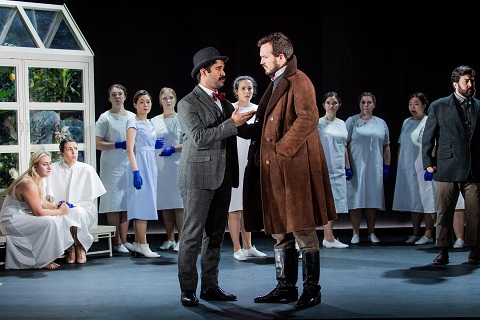 Darwin Leonard Prakash (Ibn-Hakia) and Thomas Bennett (King René). Photo credit: Robert Workman.
Darwin Leonard Prakash (Ibn-Hakia) and Thomas Bennett (King René). Photo credit: Robert Workman.
The smaller parts were well-sung. Leila Zanette had presence as Marta, and the light, fresh voices of Emilie Cavallo and Yuki Akimoto, as Iolanta’s friends Brigitta and Laura respectively, blended sweetly. The roles of Alméric, armour-bearer to King René, and Bertrand, door-keeper to the castle were competently assumed by Joseph Buckmaster and Niall Anderson.
There were some directorial mysteries and mis-hits, though. While thereis an otherworldly stillness, reminiscent of Pelléas et Mélisande, about Tchaikovsky’s final opera, the immobility of the RA chorus members - who seemed pretty much left to their own devices - was a weakness. More seriously, Platt seemed determined to make a ‘point’ at the close, but it wasn’t one that was in accord with the opera’s most obvious ‘meaning’. In the aforementioned climactic duet for Iolanta and Vaudémont, as the latter tries to explain the meaning of ‘light’ Iolanta insists that she does not need light in order to worship her God - and Tchaikovsky’s score goes into orchestral-illumination overdrive. In a ‘conclusive’ choric statement, the ensemble shares in the transfiguration of Iolanta’s vision. So, she, and they, and we, see the light in all senses of the phrase. Here, the princess’s enlightenment was accompanied not by a blaze of illumination but by a night sky, sparkling with celestial bodies. Well, it suggested spiritual fulfilment and rapture. But, Platt’s parting comment was to have Iolanta collapse in whimpering distress as the dawn sun rose. Surely, her new perception comes from love, not from literal vision. Is Platt suggesting that the former was false or illusory? If the production had been braver, it might have essayed a ‘dark’ ending by suggesting that Iolanta - like Pannochka in May Night (which Royal Academy Opera performed in 2016 ) - is really ‘of this world’, and cannot form a true relationship with Vaudémont; in which case an ambiguously bleak ending might have been more convincing.
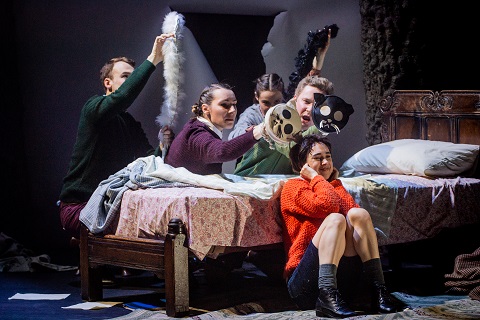 Olivia Warburton (L’enfant). Photo credit: Robert Workman.
Olivia Warburton (L’enfant). Photo credit: Robert Workman.
By contrast, the illusions and disillusionments of childhood were depicted with unflinching honesty, in a beguiling production of Ravel’s L’enfant et les sortilèges, in which Olivia Warburton’s superb embodiment of the méchant’s journey from adolescent solipsism to a more mature empathy winningly balanced humour and pathos. Warburton - whom I have recently admired as Ino in the RAO’s Semele and in the title role of the London Handel Festival’s 2018 production of Teseo - sang with a pure tone - and lovely limpid French diction - that conveyed, initially, self-conviction and indignation, and latterly, vulnerability and awakening. She stomped, rioted, flinched and cowered with gamine gall and gullibility as l’enfant’s dreams of freedom morphed into a fearful dread, and the garden of promise became a gothic prison.
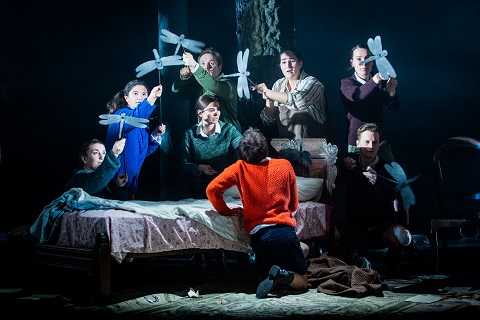 Photo credit: Robert Workman.
Photo credit: Robert Workman.
Ravel’s opera is a perfect choice for a student production, offering as it does a range of divergent characters who must be swiftly embodied in voice, movement and costume; and, on this occasion singing, design and choreography came together with a directness and simplicity - and ‘dark undertone’ - which was compelling. Not so much whimsey as witchery. This was not a picture-book, cutesy childhood milieu: bookshelves and central bed were messy; matching tents on opposite sides of the stage spilled fire, frogs and other fantastic fare to taunt the petulant youngster; there was an underlying grittiness, as when the child angrily ripped down his paper-thin walls to ‘escape’ into the garden.
 Lina Dambrauskaitė (Le feu). Photo credit: Robert Workman.
Lina Dambrauskaitė (Le feu). Photo credit: Robert Workman.
Conductor Gareth Hancock whirled us through the rapidly succeeding episodes creating a dream-like disorientation and spontaneity. The vocal roles are ‘small’ in the sense of ‘brief’, but they really need to make their mark with succinct directness, and so they did. La bergère (Aimée Fisk) and Le fauteuil (Will Pate) combined vocal clarity and strength of purpose in escaping the mischievous imp with Louis quatorze dignity; James Geidt’s L’horloge comtoise was aptly piqued having had his pendulum pinched. The piquant dance between La théière (Ryan Williams) and La tasse chinoise (Hannah Poulsom) suggested that they shared a bitter brew rather than a jazzy syrup. Hand-puppets and dragon-fly wands conducted a surreal bombardment as the tormented animal kingdom bit back, the crudeness of the design perfectly capturing the unsophistication of the child’s world. Especial mention should go to Lina Dambrauskaitė whose Fire shone with the sort of gleaming vocal intensity and brightness that we heard last year when she sang the title role in Semele, and Alexandra Oomens who was a radiant and dramatically commanding Princess.
Having evoked Tchaikovsky’s strange sound world with security and expressiveness, the Royal Academy Sinfonia were occasionally challenged by some of the many demands that Ravel makes of the instrumentalists, but they conjured the varied musical styles with flair and colour.
Claire Seymour
Tchaikovsky: Iolanta
Iolanta - Samantha Quillish, Brigitta - Emilie Cavallo, Laura - Yuki
Akimoto, Marta - Leila Zanette, Vaudémont - Shengzhi Ren, Alméric - Joseph Buckmaster, Robert - Sung Kyu Choi, Ibn-Hakia - Darwin Leonard Prakash, Bertrand - Niall Anderson, King René - Thomas Bennett.
Ravel:
L’enfant et les sortilèges
L’enfant - Olivia Warburton, La princesse/La chauve-souris - Alexandra
Oomens, Le feu/Le rossignol - Lina Dambrauskaitė, La théière/La rainette/Le
petit vieilliard - Ryan Williams, Maman - Tabitha Reynolds, La tasse
chinoise/La llibellule - Hannah Poulsom, La bergère/Une pastourelle/La
chouette - Aimée Fisk, La chatte/L’écureuil - Gabrielė Kupšytė, L’horloge
comtoise/Le chat - James Geidt, Le fauteuil/L’arbre - Will Pate.
Director - Oliver Platt, Conductor - Gareth Hancock, Designer - Alyson Cummins, Lighting Designer - Jake Wiltshire, Movement and Puppetry - Emma Brunton, Royal Academy Opera Chorus, Royal Academy Sinfonia.
Susie Sainsbury Theatre, Royal Academy of Music, London; Monday 18th March 2019.
image=http://www.operatoday.com/Iolante%20and%20Vaudemont.jpg image_description= product=yes product_title=Iolanta and L’enfant et les sortilèges product_by=A review by Claire Seymour product_id= Above: Samantha Quillish (Iolanta) and Shengzhi Ren (Vaudémont)Photo credit: Robert Workman
March 17, 2019
Desert Island Delights at the RCM: Offenbach's Robinson Crusoe
Even a desert island might look more appealing than an island that seems to be heading for its just deserts. As one band of shipwrecked adventurers ruefully reflect - in Don White’s English translation of Jacques Offenbach’s Robinson Crusoe - nineteenth-century Britannia may rule the waves but it’s a land where cheats and charlatans - financial and political - prosper: sometimes it’s sweeter to be “homesick” than “sick of home”.
As far as French musical anniversaries go, Berlioz’s 150th has had more prominence so far this year than Offenbach’s 200th, but the Royal College of Music Opera Studio has re-balanced the scales with this sparkling performance of Offenbach’s 1867 opéra comique in which romantic idealism replaces the racist imperialism of Daniel Defoe’s novel, a text that celebrates its own three hundredth birthday this year.
Robinson Crusoe was Offenbach’s second attempt to get a foot in the door of the Opéra Comique, but though reports suggest that the premiere at Paris’ Salle Favart was well-received, after a 32-performance run it faded from view, making intermittent appearances (in New York in 1875 and - in an altered version, Robinsonade - in Leipzig in 1930) before arriving on British shores in 1973 in a Camden Festival production by Opera Rara. Performed by the latter at the Proms and recorded in 1980, Robinson Crusoe was taken on a tour of the Isles by Kent Opera in 1983 and has popped up every ten years or so: Jeff Clarke’s translation was performed by Opera della Luna in 1994; the Iford Festival presented it in 2004.
The blame for the operetta’s neglect is usually laid at the feet of the librettists, Hector Crémieux and Eugène Cormon. Defoe’s novel - which has little ‘plot’ or character development - certainly needs an overhaul if it is to have dramatic potential, but the bourgeois audience who went to the Opéra Comique to find respectable husbands for their daughters probably found Offenbach’s ridiculing of English mores and manners in Act 1 of the opera no more appealing or appropriate than the more scandalous events of the following two acts where, on a distant utopia, whites and blacks share dreams of love and lust, missionaries are meat for the natives’ hot-pot, and a beautiful blonde is sacrificed at the stake to satisfy the carnal needs of the God Saranah. One imagines that the demi-monde crowd down at the Les Bouffes Parisiens might have found the cancan-ing cannibals and camp pirates more to their taste.
Even Don White’s witty couplets and some splendid vocalising and comic timing from a uniformly terrific cast couldn’t quite lift the laconic lampooning of Act 1 in which Offenbach pokes fun at bourgeois British life. We begin by spying through the key-hole at the Crusoe family’s tea-time rituals - pseudo-sincere sermonising laced with gin and port - as they await the arrival of the perennially tardy Robinson - a romantic dreamer who has heard the voice of the sea, spotted a three-master schooner in Bristol harbour and been bewitched by the lure of life on the high seas.
Designer Sarah Booth’s brown-wallpapered dining-room - a small recess stage-centre, crowded with heavy furniture and framed by projected cameos of the Crusoe clan - is a far cry from the colour, froth and fury whipped up by conductor Michael Rosewell during the overture in which wildly swirling winds alternate with the gentler lapping of a barcarolle. However, as Sir William Crusoe precedes the victuals with a virtue-inspiring re-telling of the parable of the Prodigal Son, Bill Bankes-Jones’ directorial neatness soon makes it clear that the dour manner is spiced with more than a dash of mischief. Artificiality is emphasised: several ensembles end with a freeze-frame pose. Characters climb through the fourth wall to address us from the fore-stage and though this sometimes means that they sing to us rather than to each other, it kindles our affection and gets us on their side - in the best panto tradition.
The fine singing does its work too. Timothy Edlin is a dignified Sir William, but his sonorous bass-baritone, ringing with paternal authority and Presbyterian righteousness, has an underlying warmth that intimates a kind heart and a belly laugh, while his wife, sung vibrantly by Anna Cooper, is clearly wearing the trousers beneath her high-necked black crinoline. Katy Thomson’s Suzanne, the Crusoes’ maid, sports rather more racy under-garments, as butler Toby (sung with beautiful tone and beguiling comic characterisation by Michael Bell) finds to his surprise when Suzanne whips off her apron to reveal a spangly corset and suspenders, and warns Toby that her experiences with Tom, Dick and Harry have equipped her to take the lead in love. Toby’s wide-eyed innocence and mummy’s boy guilelessness belie a spirit true and sure, so it’s no wonder that he promptly tells Robinson that he won’t be joining him on his ocean-going venture. As White so drolly puts it, ‘”My tummy’s got the rummy notion/ Ocean motion’s not for me/ I’m not the sort who gets pedantic/ It’s just the thought of the Atlantic”). Offenbach’s long ensembles are relished, and characterised by secure intonation, an assured vocal blend, choreographic neatness and strongly delineated characterisation.
Despite his cousin Edwige’s attempt to prevent Robinson’s departure with a declaration of love sealed with a kiss - the first of several lovely duets for Catriona Hewitson (whose vocal purity conveys Edwige’s selfless heart) and Joel Williams’ ardent Robinson - the would-be Columbus cannot give up his quest for far-away lands and fortune. And, in Acts 2 and 3, when the trio of rescuers, Suzanne, Toby and Edwige, set out to search for the shipwrecked Robinson and encounter cannibal tribes and bands of inebriate buccaneers, we leave the shores of comique for burlesque, even pantomime (the first such based on Defoe’s novel was written by Sheridan in 1781).
During the quasi-Wagnerian ‘sea-symphony’ which precedes Act 2 (well-shaped by Rosewell) the image of a tiny boat ‘floating’ across a vast sea/skyscape expanse, reminds us of the maritime adventurers’ vulnerability. Then, the day dawns on the sleeping Robinson’s hammock, slung between a four-poster of palm trunks, a few items salvaged from his shipwreck - a chair, wine jug, parrot in a cage, Union Jack - strewn around to remind him of home.
Evidently, this is a temperate zone for despite the sun-drenched vista Robinson is dressed in fur pyjamas, aroused by the dawn chorus from his dreams of home and love. Williams shows how he can temper Robinson’s bright-eyed optimism and self-belief which a judicious hint of a heart made heavy with nostalgia and loneliness, but with the arrival of Fleuranne Brockway’s Man Friday, the twinkle returns to his eye, and master and minion share memories and dreams. Friday’s entrance song makes it immediately clear that Australian Brockway is a wonderfully natural singing-actor: her mezzo is lustrous and pleasing at the top - the sustained high notes ring thrillingly - and, as was clear in the touching fall of the closing phrase of Friday’s discovery of newfound love in the Act 2 Finale - a secure and malleable bottom range. One turns a blind eye to the fact that it is the captured Edwige’s white skin after which Friday lusts: “The whitest flower growing in the forest, the whitest cloud above, the whitest plumage of the whitest dove, in shame would hide so dark beside, beside the beauty of this goddess of love. To love her from afar would be enough for me.” Friday’s smile, sweet nature and chutzpah are winning: “Hit it, Mike!” he cries at the start of the aria in which the tale of how he got his name becomes a revue star-turn.
Brockway is rivalled for stage presence by Theodore Platt who, as Jim Cocks - the Bristol lad turned cannibal chef - is both fun and fearsome. Ghoulishly made-up and dressed in a skeleton body-suit and towering toque, Platt stirs the steaming stew, perched atop a tribal shrine, straddling a huge sculptured head-cum-cauldron, and, with a wicked glint in his eye, faux-laments the fate of his old friends: “'You take a gallon of water and an onion or two/ And though it’s sad, I'm afraid I'll have to add both of you”. As he salt-and-peppers the unseasoned Suzanne and Toby, Jim salaciously explains that the native Tamoyas were vegetarian until they met a missionary: “But a man can’t live by bread, said a passing Presbyterian, so they ate him instead!” “What a horrid thing to do! And to a missionary too! To end up on a barbeque! We’re really in a pretty stew!”
Hewitson shines in her flamboyant waltz song, leaping to the high C# trills with ease, her voice as brilliant as the diamonds with which she imagines being strewn. And, the love duet in which Robinson and Edwige discover that dream has become reality, ‘Oui, c’est un reve’, is exquisitely tender while never losing sight of Offenbach’s tongue-in-cheekiness. But, the sublime is superseded by the downright silly: the cannibals don their Moulin Rouge bustier corsets and tutus for a good old knees-up, before a hook-handed Will Atkins (Edward Jowle) arrives with his boozy bunch of brigands and it’s time for some lusty-voiced audience participation.
Superficially Defoe’s novel was a characteristic travel adventure but its apparent proselytising for a Puritan work ethic masks more sinister undercurrents. Rousseau may have rejoiced, 35 years after its publication, that Robinson Crusoe ‘furnished the finest of treatises on education according to nature’, and Walter Raleigh (in The English Novel, 1894) might have crowed with Victorian confidence that ‘Robinson Crusoe typifies the spirit of the Anglo-Saxon race, and illustrates in epitome the part it has played in India and America’, but Dickens was less enamoured of Defoe’s tale: when Scrooge re-visits his childhood, the book he sees himself reading is Robinson Crusoe - the Cratchets, we see, are his Man Friday. Robinson Crusoe is essentially a capitalist entrepreneur who grasps land and takes its treasures for himself.
One might feel that it’s not a tale that can be made palatable to a 21 st-century audience. But, Offenbach’s arrows are barbed and pointed squarely at the Brits, and Bankes-Jones, his team, and a terrific young cast ensure they hit the target. In dark days, we all need some dalliance and diversion, and this splendid RCM production is just what the doctor ordered.
Claire Seymour
Offenbach: Robinson Crusoe
Robinson Crusoe - Joel Williams, Edwige - Catriona Hewitson, Sir William Crusoe - Timothy Edlin, Lady Deborah Crusoe - Anna Cooper, Suzanne - Katy Thomson, Toby - Michael Bell, Man Friday - Fleuranne Brockway, Jim Cocks - Theodore Platt, Will Atkins - Edward Jowle; director - Bill Bankes-Jones, conductor - Michael Rosewell, designer - Sarah Booth, lighting designer - Ralph Stokheld, choreographer - Bim Malcomson, Royal College of Music Opera Studio Chorus and Orchestra.
Britten Theatre, Royal College of Music, London; Saturday 16th March 2019.
image=http://www.operatoday.com/Robinson%20Crusoe%20title.jpg image_description= product=yes product_title=Robinson Crusoe: RCM Opera Studio, Britten Theatre product_by=A review by Claire SeymourMarch 14, 2019
Akira Nishimura’s Asters: A Major New Japanese Opera
Their new Artistic Director for Opera, conductor Kazushi Ono, has pledged a new native work every two years and seems keen that these works be hard beyond Japan. The first of these, Akira Nishimura’s Asters (Shion Monogatari), was premiered on February 17 this year, followed by an ambitious run of three further performances.
The opera house is one of three theatres in the complex, along with a Playhouse and “The Pit,, a flexible space. The NNTT has its own ballet company and chorus, but uses outside orchestras (usually the Tokyo Symphony Orchestra or the Tokyo Philharmonic, though for Asters they used Ono’s own Tokyo Metropolitan Symphony Orchestra, who played wonderfully in-touch with the onstage action). Before 1997, Tokyo had no dedicated opera house, though plans to create one had been under consideration since the 1960s.
Most westerners, if they have an impression of Japanese opera at all, may think of Ikuma Dan’s one-act Yuzuru (1952, produced in Zurich in 1957) or even Toshiro Mayuzumi’s The Golden Pavilion (1976, written in German and produced in Berlin), based on Mishima’s novel of the same name. Dan was even commissioned to write the opera Takeru to open the opera house in 1997. But for this latest project, Ono commissioned a new opera from prominent composer Akira Nishimura (b. 1953) and librettist Mikiro Sasaki and the theatre has worked closely with them on this project. Ono clearly knew the sort of work he wanted to move forward the reputation of the theatre and of Japanese opera.
Asters is a large work in two acts, running to almost two hours, scored for a huge orchestra and chorus and eight principals. At times there are over a hundred people on the stage, though at other times there are intimate moments with just two singers.
The story is based on a 1956 novella by the symbolist writer Jun Ishikawa (1899-1987) which broke a literary silence of over a decade after the war years (in Japanese, it is called Shion Monogatari; translated into English, it became Asters). In its description of the destructiveness of various kinds of evil, and especially the frustrations of youth, it offers a profound critique of both war and of the sham democracy that post-war consumerism brought to Japan.
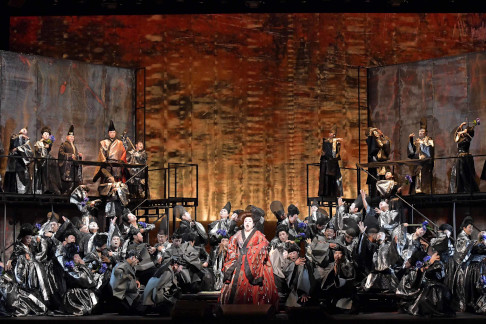
The main protagonist, the young prince Muneyori, is from a family of distinguished poets and he is married to the lustful and faithless Princess Utsuro. Rejecting both his wife and his poetry, encouraged by his mysterious uncle Yumimaro and sinister retainer Tonai, Muneyori sets out to pursue archery, coldly fascinated with killing first a white fox, then his retainers and finally his wife’s lovers. He pursues the goal of firing at first one arrow, then two and finally three at once, the first symbolizing knowledge, the second killing and the third the “devil’s arrow.”
His quest brings him to a mysterious mountain, the other side of which everything is different from his current life. On this mountain he meets first a girl called Chigusa, actually the fox he killed, who gives up her desire to kill Muneyori as the two fall deeply in love. Chigusa offers to accompany him to the summit of the mountain and transforms herself into a bow for him. At the summit, Muneyori meets a man called Heita, a reflection of himself, yet a man of peace, with no desire for meaning, who simply fills his days carving the face of the Buddha into the mountain. Muneyori declares his wish to fire his three arrows into the face, and despite Heita’s protestations manages to do so, bringing the work to a fiery and destructive conclusion.
So how far is Asters a Japanese opera, and what does this even mean? Composer, librettist, novella and commissioning director of the theatre are all Japanese, to be sure. But as a work of art how Japanese is it, and what might it contribute to a Japanese operatic “school”?
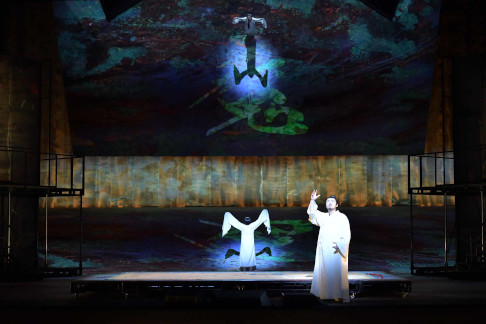
Although at first sight the setting of the story is medieval, feudal Japan, there are not really any specific indicators of this beyond the names of the characters. The Buddha in Act II indicates an Asian setting, but the story is essentially a fictitious one. The score is a mix of Japanese, Asian and western influences: Nishmura uses pentatonic scales at times, but he also uses atonality. Indeed, in the duet between Muneyori and his father, the disagreement of the two is underscored by the tradition-loving father singing in pentatonic, while Munetori is atonal. And while Nishimura is well-known for composing for Japanese traditional instruments such as the shakuhachi or koto, in Asters the orchestra is essentially a large western orchestra, though he does use the mokusho (wooden disk knocked with a stick) and hyoshigi (pair of wooden sticks like claves). Non-Japanese Asian elements also include the kecak dance and Mongolian overtone singing.
There is of course no reason why non-Japanese influences should “dilute” the work’s essential Japaneseness. Vaughan Williams could write quintessentially English music with strong Bach and Ravel influences, and likewise Nishimura uses what he pleases to create an essentially homogenous style. The impression is of a work made in Japan, as a part of Asia, with a message for the world. This seems to be the message that the NNTT is hoping to get across; that Japanese-composed and Japanese-produced opera has something universal to say to the world. So how successful was the attempt?
Asters isn’t an easy work: the symbolist nature of the story and of the characters require a fair amount of concentration. But the work never becomes dull: the story moves and the music expresses the inner drama. There are big moments, such as the opening banquet scene, the threnody after the first killings and the wonderful quartet in Act II between Muneyori, Chigusa, Utsuro and Tonai, but there are also plenty of quieter, more thoughtful moments. Three leitmotifs, the “asters theme,” “Muneyori theme” and the “Devil’s arrow theme” are used as a unifying and illustrative thread.
The production was overall magnificent: expressive and reflective sets by Tom Schenk (who worked long with Peter Brook, an influence that shows clearly) and imaginative costumes from Richard Hudson. Orchestra, chorus and principals all performed with energy and commitment. Tomohiro Takada as Muneyori projected the determination and emotional opaqueness of his character well; Kasumi Shimizu was a suitably sexually deranged Princess Utsuro; her lover Tonai was played with great humour and sinister overtones by Toshiaki Murakami. Ai Usuki’s Chigusa had a sublime presence as the only fully sympathetic character of the opera. The smaller roles of Heita, Yumimaro and Muneyori’s father were all in good voice too.
This is a production that could surely work well in a European or North American house before long, and let us hope that can come to pass. Let us also hope that Ono’s wish to put out more Japanese operas is fulfilled and we can see the start of a new era for the genre.
Jamie Findlay
image=http://www.operatoday.com/2019Asters_2067_DS7_0525.jpg image_description=Scene from Asters [Photo courtesy of New National Theatre, Tokyo] product=yes product_title=Akira Nishimura’s Asters: A Major New Japanese Opera product_by=A review by Jamie Findlay product_id=Above: Scene from AstersPhotos courtesy of New National Theatre, Tokyo
March 12, 2019
The Outcast in Hamburg
Austrian composer Olga Neuwirth’s muse is injustice fuelled by discrimination and the abuse of power, themes that she welcomes in this retake on Herman Melville’s Moby Dick. The more sensational content of “the great American novel” is extracted and elaborated to make a sort of dramatic action supported by a musical score of great interest and indeed considerable appeal.
With the proliferation of our current “news and commentary” hungry culture Mme. Neuwirth’s expositions of contemporary evils are already the evils we well know. Thus at first glance the dramatic action of The Outcast is redundant elaboration of current sensibilities, overworked, everyday material that has lost edge through constant exposure. Our interest in Mme. Neuwirth’s installation is therefore focused on how she manipulates Melville and his great work.
To appreciate and to feel her music to its probable depths we needed to understand the text it embodies. I am not the first critic to say that an appreciation of The Outcast depends on an advance examination and consideration of its libretto. Without such warning we were left with only an approximate idea of its glories. Mme. Neuwirth’s The Outcast verges on hermeticism (art with difficulties that exclude a larger public).
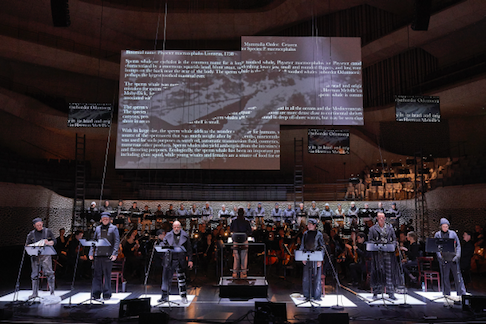 Left to right: Starbuck, Stubb, Ahab, Pip, Queequeg, Ishmaela. Photo copyright Claudia Höhne
Left to right: Starbuck, Stubb, Ahab, Pip, Queequeg, Ishmaela. Photo copyright Claudia Höhne
Essentially the ship Pequod and its captain Ahab plunder the sea [reeking profits from their exploitation of the world’s resources], the Pequod’s crew at first idealistic whalers then give themselves to Ahab’s purposes [democracies that succumb to a strong, destructive leader]. Meanwhile in the libretto Ismael become Ismaela [self realization] among other strident themes. Neuwirth adds a spoken text (by Boston based Austrian author Anna Mitgutsch) for an “old” Melville. This text, read by an actor, questions power and helplessness, God, the act of writing, fate, cruelty and the beauty of nature.
Olga Neuwirth’s musical palette in The Outcast is a full symphony orchestra (double winds), plus a synthesizer, accordion and an electric guitar. There is no such thing as harmony (vertical structures of accord or discord), there are no scales (successive tones of internal attractions that have repetitive structure), and there is never any discernible beat or repetitive rhythm. Thus Mme. Neuwirth creates successive masses of symphonic sounds that are thrusts and plaines of complex colors (infinite shades) enhanced by amplification.
Vocal lines while linear and text friendly are not melodic. They certainly are not easy to sing. The concert format of the installation allows the presence of scores — a necessity given the arbitrary linear movement.
In her Outcast storytelling Mme. Neuwirth does use a sort of “concrete” music — the guitar for a folksong episode, the synthesizer fabricates a pipe organ for a New England church, the accordion a ship song, the traditional, recognizable (or maybe what we call real) musical structures soon dissolve into Mme. Neuwirth’s symphonic messes.
The Neuwirth musical poetic is fully developed and extremely effective. May it achieve its potential in her upcoming commission for the Vienna Staatsoper (this coming fall), an opera based on Virginia Woolf’s Orlando. Perhaps she will have the help of a dramaturg.
British designer/video artist Netia Jones created this installation. There were five screens of various sizes with sometimes bits of projected English language text that you were not meant to read, rather to accept as Moby Dick the book, other times there were still images of the open sea, and sometimes there were static, abstract vertical lines. The total look of the production was nothing less than spectacular, the eight costumed soloists (seven singers, one actor) in a line across the front of the orchestra platform, the male chorus single lined across the back behind the orchestra, the screens suspended above the chorus loft and the boys chorus eerily placed up there as well, and spookily lighted.
The cast was quite able and did indeed bring Mme. Neuwirth’s The Outcast to vibrant life. The star of the show was the Munich Boys Chorus (Müncher Knabenchor) who stood without the slightest movement for the one and one half hour duration, singing the very difficult music that expressed the innocence of young boys who became sailors.
Israeli conductor Ilan Volkov, held all this together with no evidence of stress, adding to the overall impression of a beautifully produced evening.
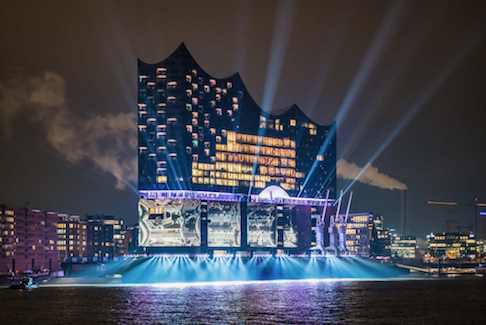 Lighted area are the public areas of the Elbphilharmonie. Photo copyright Ralph Larmann
Lighted area are the public areas of the Elbphilharmonie. Photo copyright Ralph Larmann
Hamburg is the epitome of a rich city. Rich enough to have a recent new opera house and rich enough to build this magnificent new concert hall designed by the star Swiss architecture firm Herzog & de Meuron. The structure, built over an old waterfront warehouse is a veritable Mount Parnussus of music — once inside the theater itself (it starts on the eighth elevator level of the building) you climb and climb through pure whiteness to the level (there are five) of your seats, spectacular, black-night city views are revealed from time to time. Note that the building holds also a hotel and 45 apartments.
The acoustical engineer was the famed Yasuhisa Toyota, responsible for the excellent acoustic of Los Angeles’ Disney Hall as well as other recent theaters throughout the world. Given the amplification of The Outcast forces it was not possible for me to assess the hall’s real sound.
That The Outcast is outrage directed at the capitalistic forces that could finance this $1,000,000,000 structure was the glaring irony that defined the evening.
Michael Milenski
Cast and production information:
Emily Hindrichs: Ishmaela; Omar Ebrahim: Ahab; Daniel Gloger: Queequeg; Georgette Dee: Bartleby, der Schreiber; Johan Leysen: Old Melville; Steve Karier: Father Mapple; Jan Petryka: Starbuck; Matthias Helm: Stubb; Joel Beer: Pip. ORF Radio-Symphonieorchester Wien, Company of Music Vokalensemble, Münchner Knabenchor Chor. Conductr: Ilan Volkov; Design and Video: Netia Jones; Sound Design: Gilbert Nouno Klangregie. Elbphilharmonie, Hamburg, Germany, March 4, 2019).
image=http://www.operatoday.com/Outcast_Hamburg1.png
product=yes
product_title=The Outcast in Hamburg
product_by=A review by Michael Milenski
product_id=Above: The Elbphilharmonie in Hamburg, Herzog & De Meuron architects [photo copyright Thies Rätzke, all photos courtesy of the Hamburg Philharmonie]
March 11, 2019
Leonard Bernstein: Tristan und Isolde in Munich on Blu-ray
For two of the last century’s greatest artists that they shouldn’t have collaborated more often is perhaps unusual – though Bernstein didn’t conduct opera as often as he might have. Bernstein’s own ambivalence towards Wagner – “I hate Wagner, but I hate him on my knees” – meant he would never conduct at Bayreuth either, even though he had suggested that he would indeed lead a new production of Tristan und Isolde there in 1972 (that never materialised, and Carlos Kleiber conducted the next Bayreuth Tristan in 1974).
Bernstein would conduct Tristan und Isolde, of course, in Munich. That performance, recorded live an act at a time over several months, would unlikely have been to Nilsson’s tastes. Indeed, in the over three decades since it was made this is a recording of Tristan that has sharply divided critical opinion – and continues to do so. For some, the extremely slow tempi, especially for the first two acts, which are among the longest on record, make this performance dramatically weak, even incoherent; for others, that very slowness reveals power and sumptuousness in equal measure. It begins with a Prelude of astonishing breadth – but Bernstein’s is by no means as unique as one might think. Fritz Reiner, in a live performance with the Chicago Symphony Orchestra from the 1957/58 season of concerts, is as breathtakingly expansive as Bernstein is. What both Bernstein and Reiner amply demonstrate – where a conductor like Carlos Kleiber sometimes doesn’t – is that this music is organic; the pauses and bar rests are part of the music, not distinctly separate from it. When Karl Böhm commented that Bernstein dared to conduct Tristan as Wagner wrote it he wasn’t being altogether facetious, nor uncomplimentary – though Böhm rarely took his own advice. The one compelling reason to listen to Bernstein’s performance is almost symmetrically similar to the reason why one should listen to Toscanini’s 1930’s Wagner: What might be excessive control of the music to some ears, is revelatory to others.
This is not to say that Bernstein’s Tristan is not beset by problems because it obviously is. The major disadvantage is that this is not a single performance of the opera. It doesn’t lack drama – far from it – but it’s drama that’s not consistent with our assumptions about opera in the theatre. An audio recording by itself can rarely give us a picture of a live event; film, on the other hand, is entirely impressionistic. If some find Bernstein’s Tristan antithetical to this opera’s drama and intensity there’s more than enough ammunition here to help justify those claims. Compare it to, for example, the great Böhm/Nilsson/Vickers Tristan from Orange in 1973 and Bernstein’s Tristan can be seen as an exercise in stasis: The singers rarely move, there is no staging to speak of; the music and the voices build everything into an evolving drama. And the orchestra is the fulcrum from which almost everything is built up. In one sense, this is a Tristan - semi-staged, though even that is a generous description – that alludes to the theatricality of some Pinter or Beckett; it’s microscopic, even absurdly, interventionist in an opera that ideally requires the opposite.
The film of this Tristan is revealing in one sense in that it lets us see the conductor – and Bernstein looks on the verge of a nervous breakdown after Act I – but in no sense does this at all seem obvious from the Philips audio recording. The physical exhaustion is so palpable it now perhaps seems inevitable the opera was performed this way. But when you listen to Act I Bernstein’s symphonic way with the score, with swelling and wildly vivid chords, with waves of sound almost breaching the limits of Wagner’s scoring, the scale seems more imposing than usual, too. Bernstein’s Tristan is rather similar to standing in front of Gericault’s Raft of Medusa at The Louvre: A shipwreck of a performance almost certainly, but you’re drawn into its psychological and disturbing complexities in the way that great visual art often engulfs you. It’s little more than an exercise in power, however: This is the art of control, deliberately indulgent as no other performance of Tristan is.
One of the glories of these concerts was the translucent, and languid, playing of the Bavarian Radio Symphony Orchestra. I think it’s always seemed unlikely that such disciplined, detailed and unfailingly beautiful playing could have ever been achieved from either an orchestra pit, or over the period of a single performance. Bernstein’s attention to detail is microscopic – the phrasing is often so precise, the bar rests so eternal, the emphasis on sound so important that this Tristan is often pulled in two distinct, and opposing, directions. The passion that Bernstein gets is so symphonic that he’s forgotten about the voices.
And those voices are not at all even. Hildegard Behrens’s Isolde is on the light side, more fragrant and fragile than one would ideally like. The voice rather lacks backbone, notably in the bottom register, but it’s a good match for her Tristan, sung by Peter Hofmann. Behrens would, in a few years or so, become a fine Isolde – but here she is rather constrained by the slowness of the music to give us an Isolde that is dreamy rather than dramatic, reflective rather than vituperative. Hofmann’s Tristan was never comparable to the best on record, or in the opera house – and he doesn’t really, unlike his Isolde, seem to benefit from the single-act concept; indeed, one might argue he’s actually hindered by it, especially in Act III. Hofmann never really feels a convincing Tristan because the scope of Tristan’s full tragedy is rarely allowed to develop. True, there are no wiry moments, no rough edges to Hofmann’s Tristan – though his tone, rather than feeling refreshed between each act struggles to achieve any depth. His long monologues in Act III are often uneven, and there is little in the sense of molten intensity. Bernstein picks up speed in Act III – a notably faceless prelude beginning it – but even so when Behrens and Hofmann sing together, such as in the Liebesnacht, the effect really isn’t as intended.
There are some advantages from a sound perspective to this Blu-ray version of Tristan und Isolde. The Philips CDs emphasise the orchestral balance in the BRSO’s favour even more starkly than is the case here. If the audio of the performances suggest that Bernstein had immersed his singers under great waves of sound, the film somewhat corrects that impression. It’s entirely possible what Philips were doing with their sound editing was inserting dramatic effect to counter-balance the neutrality of Bernstein’s dreamier approach to the score. But this filtering was often unevenly done. The Act III prelude, for example, is extremely lightweight, as is Isolde’s Liebestod which just sounds thin and strained - but, on the other hand, the endings to Act I and Act II are thundered out with such force they sound like sledgehammers by comparison. The sound on film is much more natural – though, of course, it does nothing to improve the deficiencies of the performance itself.
This is unquestionably an important document of Bernstein’s legacy as an opera conductor, though it’s inevitably a deeply flawed one. If there is one reason to buy the Blu-ray of this performance it’s that the shift in sound perspective gives us a quite different view of these concerts. Visually, it’s not especially interesting to look at – it’s as static as the performance is through its long stretches. I’ve always loved this Tristan for the playing of the Bavarian Radio Symphony Orchestra and that will never change – this is a near flawless orchestral performance, one of depth and sumptuousness that is unrivalled elsewhere, even by Karajan’s Berlin Philharmonic or Kleiber’s Dresden Staatskapelle. The impact they have on film is remarkable – and this is probably as close as Bernstein intended it to sound. It’s magnificent but frustrating in equal measure.
Marc Bridle
image=http://www.operatoday.com/BernsteinTristan%20%281%29.jpg image_description=C Major 746034 [Blu-Ray] product=yes product_title= Tristan - Peter Hofmann, Isolde - Hildegard Behrens, Brangäne - Yvonne Minton, Kurwenal - Bernd Weikl, König Marke - Hans Sotin, Chor und Sinfonieorchester des Bayerischen Rundfunks conducted by Leonard Bernstein.NTSC, PCM Stereo - region Code A,B and C. Running time: 291 minutes.
Recorded live at Herkulessaal, Munich - 13th January, 27th April, 10th November 1981. product_by=A review by Marc Bridle product_id=C Major 746034 [Blu-Ray] price=£30.61 product_url=https://amzn.to/2EXvVvl
March 10, 2019
Monarchs corrupted and tormented: ETO’s Idomeneo and Macbeth at the Hackney Empire
Returning from the Trojan Wars, his ships and crew threatened by a tempest, the Cretan King Idomeneo bargains with the sea-god Neptune in order to save his own skin, and in so doing risks losing his son, by his own hand. Having vowed to sacrifice the first person he meets upon his safe arrival on his home shore, Idomeneo is greeted by his son, Idamante, and finds himself conflicted by the demands of love and duty. Mozart’s opera seria dramatizes the King’s attempt to unravel the mess of his own making, as rivalries, jealousies and intrigues fester and flourish at his Cretan court. As so often with the Greeks’ tragic tussles, the modern-day parallels are painfully apparent.
However, in contrast to Austrian director Martin Kušej’s approach at Covent Garden in 2014 , director James Conway has eschewed the idea of turning the opera into, in his words, a ‘specific history lesson’, and the untrammelled simplicity of his conception and its execution in this ETO production of Idomeneo begets rich results. This is a production characterised by musical insight, dramatic composure and technical excellence, on the part of the creative team and cast equally. In a programme article, Conway confesses that he has previously hesitated to direct Idomeneo, fearing its ‘relentless earnestness’, but here he makes such sincerity a virtue: this Idomeneo is notable for its clarity, candour and communicativeness.
Katie Mitchell’s modern-day for production for English National Opera (2010) had assorted pen-pushers, waiters and flunkies dashing about the stage in what I described at the time as an ‘unexplained and unfathomable flurry of activity’. Conway’s approach could scarcely be more different. Here, music and mise en scène work their magic, aided by Frankie Bradshaw’s clear-cut designs and Rory Beaton’s bold lighting - how apt for an opera whose hero is the epitome of Enlightenment values.
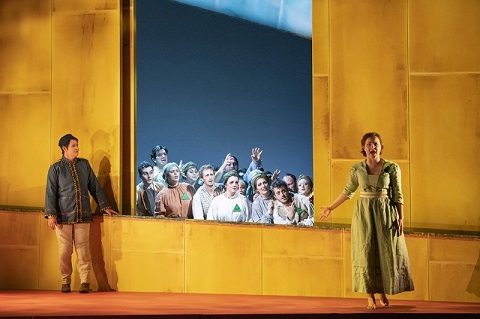 Catherine Carby (Idamante), ETO Chorus, Galina Averina (Ilia). Photo credit: Richard Hubert Smith.
Catherine Carby (Idamante), ETO Chorus, Galina Averina (Ilia). Photo credit: Richard Hubert Smith.
Beaton’s lighting schemes pit strong primary and complementary hues against each other. Colours transmute - aquamarine and orange, purple and red - sometimes with a swiftness matching the briskness with which many of Mozart’s arias follow the recitative, elsewhere more organically. The palette and brightness, by turns intensified and muted, evoke locale - the infinite ocean, a waterfront, the stormy sky - and mirror inner passions.
The stage is quite foreshortened by an imposing edifice which stretches its length, but a mosaic-bordered exit stage-right suggests a depth beyond - what Conway describes as ‘a doorway leading to something suggesting culture’ - and sliding panels concertina to open up vistas, revealing the Cretan populace, who suffer as a result of their ruler’s failings, and the captured Trojans who are confined in a prison evoked by a slanting panel which tilts menacingly. The ETO Chorus, though distanced for much of the production - placed ‘beyond’ the struggles within the court, but no less affected by them - were in strong voice.
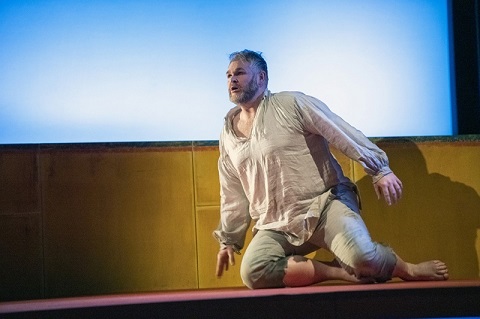 Christopher Turner (Idomeneo). Photo credit: Richard Hubert Smith.
Christopher Turner (Idomeneo). Photo credit: Richard Hubert Smith.
The cast, too, offered consistently fine Mozartian singing. As Idamante, mezzo-soprano Catherine Carby made us feel each and every of the young Prince’s emotional twists and turns. This Idamante wore his heart on his tunic-ed sleeve and Carby acted and sang with candour, the richness of her voice particularly expressive in the recitatives. On the last few occasions that I’ve heard Christopher Turner perform (at SJSS in La Nuova Musica’s Alcina early this year, and as Pollione in Chelsea Opera Group’s Norma in 2018) I’ve been more and more impressed by the combination of focus, power and beauty that his tenor commands. He displayed plenty of ringing heroism as Idomeneo, compelling our attention: the bravura of his Act 2 aria, ‘Fuor del mar’, conveyed both the King’s regal stature and his self-inflicted anguish and fear. Turner has a strong lower range which brought out the darkness within this morally questionable monarch; but there was lyrical shapeliness too in Act 3’s beautifully shaped ‘Accogli, o re del mar’.
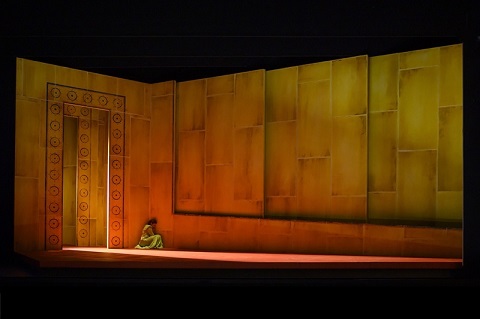 Galina Averina (Ilia). Photo credit: Richard Hubert Smith.
Galina Averina (Ilia). Photo credit: Richard Hubert Smith.
As Ilia - the daughter of the defeated King Priam of Troy who, rescued at sea by Idamante, has fallen in love with the son of her enemy - Galina Averina had the difficult task of establishing the mood at the start of both halves of the performance, but she did so with consummate poise. Alone on stage, she opened Act 1 as a figure of loneliness and loss, curled against the wall as if trying to protect herself or escape from the conflicts within the palace and within her own heart. Averina has a lovely soft gleam to her sound, which was complemented by the woodwind quartet in Act 2’s ‘Se il padre perdei’; and, while ‘Zeffiretti lusinghieri’ was similarly moving, Averina was able to bring urgency to her tone when required.
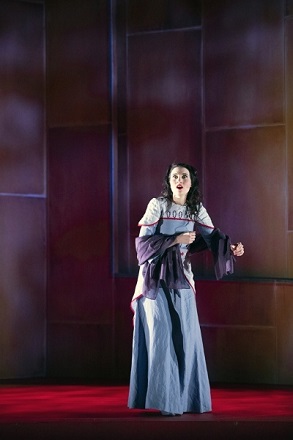 Paula Sides (Elettra). Photo credit: Richard Hubert Smith.
Paula Sides (Elettra). Photo credit: Richard Hubert Smith.
Paula Sides seemed a little hesitant initially as Elettra - the daughter of Agamemnon and Clytemnestra who has taken refuge among the Cretans after her brother Orestes has committed matricide, and who is Ilia’s rival for Idamante’s love - but her Act 2 aria ‘Idol mio’ was rich with emotions which exploded further in her final aria, ‘D’Oreste, d’Ajace ho in seno i tormenti’. In the latter, the torments of Elettra’s own unrequited passion and of her brother’s crime fused in a glittering fiery outburst. Sides captured Elettra’s vengeful vindictiveness and her pathos; as she yearned to follow Orestes to the abyss, the shapes carved by her soprano were as sharply defined as the edge of the knife she wielded.
The roles of Arbace, the King’s counsellor, and the High Priest were amalgamated and sung with vigour and urgency by John-Colyn Geantey, though perhaps a bit less dashing about would have brought more gravity to the High Priest’s persona. As the Voice of Neptune, Ed Hawkins was fittingly resonant and imposing. The ETO Orchestra played with brio for conductor Jonathan Peter Kenny who created fluency between the recitatives and arias, which are often conjoined in the score.
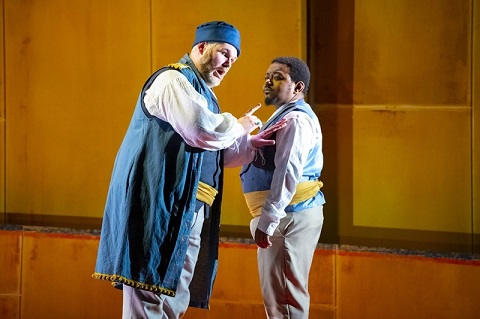 Christopher Turner (Idomeneo) and John-Colyn Geantey (Arbace). Photo credit: Richard Hubert Smith.
Christopher Turner (Idomeneo) and John-Colyn Geantey (Arbace). Photo credit: Richard Hubert Smith.
Heading towards disaster, Idomeneo can only hope for divine intervention and mercy. He and subjects are fortunate: it proves easier for the Cretan King to do a deal with the deities than it evidently is for some modern-day leaders to negotiate with their counterparts abroad and their ‘allies’ at home. And so, Idomeneo’s reckless promise is revoked and order restored. Idamante slays the sea monster and buries past conflicts, and while Idomeneo has to relinquish power to the next generation, the continuity of the family line is ensured, as a new world begins. If only we could be so lucky.
The regicidal Macbeth, too, might wish for similar good fortune, for in Shakespeare’s Scottish play supernatural interventions bring not reconciliation and renewal but deceit and destruction. Not that the witches in James Dacre’s production are particularly menacing, although the female Chorus sang with vigour and precision. At the start, cloaked in green habits and white aprons, this gaggle of nuns-cum-nurses tend to the wounded and lay out the dead, all the while singing of the vicious torments which they have inflicted upon the unfortunates who have crossed them. These are not Shakespeare’s ‘withered and so wild’ hags with ‘choppy fingers’, ‘skinny lips’ and ‘beards’ who emerge from mist and dissolve into darkness; nor the ‘compound’ figures in Verdi’s opera who - as shaped by the composer’s interest in the writings of Shakespeare’s German translator August Schlegel - are both emblems of the superstitious lower classes and Delphic agents of fate. Instead, this ministering brood, medicinal rather than murderous, might have looked more at home in a G&S operetta - or, when Verdi’s rum-te-tum choruses are given a cheery boost by conductor Gerry Cornelius, on the set of The Sound of Music. Thus, when Macbeth and Banquo, fresh from their trouncing of the merciless Macdonald and with the traitorous Thane of Cawdor’s limp body swinging from a noose at the rear of Frankie Bradshaw’s twilight-zone set - meet the witches for the first time, their query, ‘What are these foul beasts?’, falls rather flat.
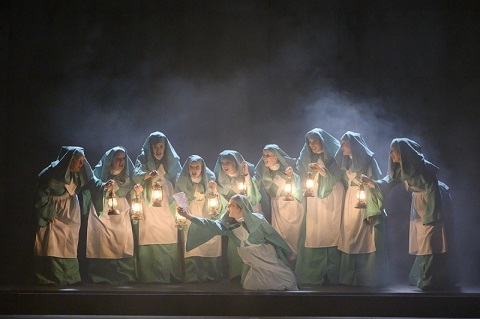 Photo credit: Richard Hubert Smith.
Photo credit: Richard Hubert Smith.
The representation of the witches seems to me to be central to the impact that the opera makes, especially because of the identification with the witches that Lady Macbeth’s music intimates. Christoph Clausen (in Macbeth Multiplied: Negotiating Historical and Medial Difference Between Shakespeare and Verdi) has argued that although a comic treatment of witches was the norm in late-eighteenth and early-nineteenth century theatre, by the mid-nineteenth century witches were depicted on stage as more sinister figures. But, even if Clausen is correct, we have Verdi’s directives to his librettist Francesco Maria Piave, in letters written during September 1846, that he should ‘adopt a sublime diction, except in the witches’ choruses, which must be vulgar, yet bizarre and original [triviali, ma stravaganti ed originali]’. What did Verdi mean by ‘trivial’? Verdi scholar Julian Budden has claimed that the first witches’ chorus merely captures the ‘childish malice’ of the witches in Shakespeare’s play, while the second ‘has all the deliberate vulgarity of its predecessor without any of the fantasy. It is just any chorus of gipsies or peasants.’ Whatever, representing the witches as sisters of Christ doesn’t seem to me to make much sense: the witches inflict pain rather than assuage it.
The opera is presented in English and this, too, seemed to me to be misguided. Of course, exigencies of dramatic form and pace necessitated excisions which alter relationships and motivations in the opera: thus, Verdi’s Lady Macbeth becomes unequivocally a dominating demon rather than just an instigator, encourager and accomplice, and she is the mastermind of the plot to murder Banquo, rather than a caring wife pushed aside by her increasingly isolated and sick husband. Also, Verdi was himself more influenced by the various Italian translations of Shakespeare than directly by the Bard’s text itself, although, in the face of criticisms of his libretto, Verdi wrote to Léon Escudier, his French publisher (April 1865), complaining that although he was accused of not ‘knowing his Shakespeare’, ‘in this they are very wrong. It may be said that I have not rendered Macbeth well, but that I don’t know, don’t understand, and don’t feel Shakespeare-no, by God, no. He is a favourite poet of mine, whom I have had in my hands from earliest youth, and whom I read and reread constantly.’
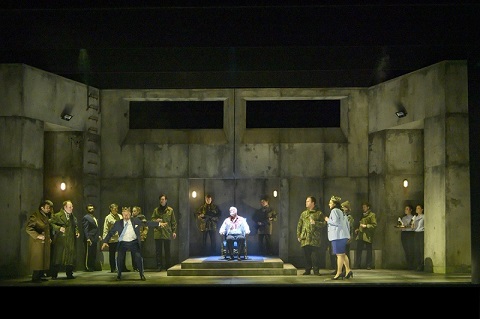 Photo credit: Richard Hubert Smith.
Photo credit: Richard Hubert Smith.
The point here, though, is that Andrew Porter’s translation is a prosaic paraphrase of Shakespeare’s poetry which reduces the emotive impact of the words. For example, Macbeth sees ‘gouts of blood’ upon the blade and dudgeon of the hallucinated dagger: why change this to ‘drops of blood’? End-of-scene summaries are also offered; but surely there can be few in the audience who are unfamiliar with the basic plot. An Italian text would have retained the lyricism and rendered an emotional heightening of the tragedy.
What Dacre’s production does do successfully is to bring the political rather than the personal to the fore: after all, premiered in Florence in 1847, at the height of unrest about Italian reunification, Macbeth surely articulates Verdi’s devotion to Italian independence and his abhorrence of the tyrannical abuse of power. Bradshaw’s set is a concrete bunker, which harbours secret niches and nooks, permitting intrigue and, in the Grand scena and duet in Act 1, intimacy. Infernal intrusion, too, when the ghost of Banquo - bloodstained but not quite shaking ‘gory locks’ at the hysterical Macbeth - imposes himself behind the throne positioned and raised in the central recess. CCTV cameras capture the corruption, and attest to Macbeth’s paranoia; until, that is, a black-clad assassin disables them prior to Banquo’s murder.
Dacre updates the drama to the modern age: Macbeth and Banquo swap their officers’ regalia for sharp suits, while Lady Macbeth sports attire suggesting executive power. As rag-bag mercenaries in combat fatigues, beanies and balaclavas dash about the stage, the effect is pacy and punchy - though I winced when Ruger MK I’s were waved menacing at the mention of swords and daggers.
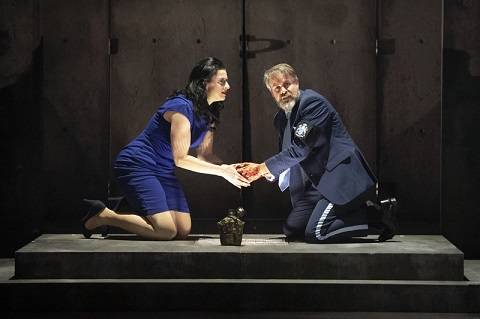 Madeleine Pierard (Lady Macbeth) and Grant Doyle (Macbeth). Photo credit: Richard Hubert Smith.
Madeleine Pierard (Lady Macbeth) and Grant Doyle (Macbeth). Photo credit: Richard Hubert Smith.
The singing, too, provides much enjoyment. As Lady Macbeth, Madeleine Pierard may not comply with Verdi’s request for ugly, declamatory sounds and hollow whispers, but she does make a good effort to use vocal colour to portray complexity of character and the dangerous energies of Lady Macbeth’s inner life. There’s a false note in the sleep-walking scene, though, when Lady Macbeth puts out her own light, for the taper that she carries - ‘she has light by her continually; ‘tis her command’, so her Gentlewoman tells us - is her only defence against the darkness which she has summoned and delighted in and which now consumes and terrorises her.
Macduff is reduced to a minor role by Piave and Verdi, but Amar Muchhala makes his aria count, singing expressively and with dramatic impact. Andrew Slater is vocally woolly-edged as Banquo but he establishes a nice rapport with Dara Gibo’s Fleance, the latter’s suitably guileless and vulnerable demeanour evoking a pathos which is rare in this production.
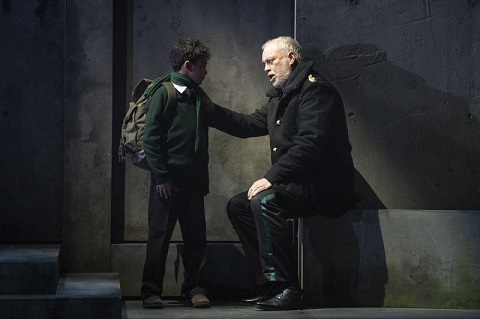 Andrew Slater (Banquo) and Dara Gibo (Fleance). Photo credit: Richard Hubert Smith.
Andrew Slater (Banquo) and Dara Gibo (Fleance). Photo credit: Richard Hubert Smith.
ETO regular Grant Doyle rages and rampages as Macbeth but achieves volume at the expense of subtlety of characterisation and nuance of vocal line. This is a broad-stroke interpretation, and while Doyle has an appealing baritone it feels pushed to the limit at times here; there is little sense of the interior life - the conscience and guilt which make Macbeth a ‘man’ rather than just a murderous tyrant. Even his final aria, ‘Mal per me che m’affidai’, though sung with intensity and focus, did not quite capture the sense that this is a turning-point, a moment when Macbeth truly regrets his actions recognising that they have brought him a ‘power’ which is transient and false, and that he has denied himself the honour, love, obedience and friendship which should accompany old age.
Cornelius keeps the action surging forward and, attentive of the details of orchestration, conjures the dark tinta of the score.
English Touring Opera’s 2019 Spring Tour continues until June 1st.
Claire Seymour
Mozart: Idomeneo
Ilia - Galina Averina, Idamante - Catherine Carby, Idomeneo - Christopher Turner, Arbace - John-Colyn Gyeantey, Elettra - Paula Sides, The Voice of Neptune - Ed Hawkins; Director - James Conway, Conductor - Jonathan Peter Kenny, Designer - Frankie Bradshaw, Lighting Designer - Rory Beaton, ETO Chorus and Orchestra.
Hackney Empire, London; Friday 8th March 2019.
Verdi: Macbeth
Macbeth - Grant Doyle, Lady Macbeth - Madeleine Pierard, Banquo - Andrew Slater, Macduff - Amar Muchhala, Malcolm - David Lynn, Lady-in-Waiting - Tanya Hurst, Doctor - Ed Hawkins; Director - James Dacre, Conductor - Gerry Cornelius, Designer - Frankie Bradshaw, Lighting Designer - Rory Beaton, ETO Chorus and Orchestra.
Hackney Empire, London; Saturday 9th March 2019.
image=http://www.operatoday.com/ETO%20Idomeneo%20chorus%20Richard%20Hubert%20Smith.jpg image_description= product=yes product_title=Mozart’s Idomeneo and Verdi’s Macbeth: ETO at the Hackney Empire product_by=A review by Claire Seymour product_id= Above: The cast and Chorus of IdomeneoPhoto credit: Richard Hubert Smith
March 9, 2019
Der Fliegende Holländer and
Tannhäuser in Dresden
The Altes Hoftheater, designed by Danish architect Gottfried Semper, had opened in 1841 but burned to the ground in 1869. It was rebuilt by Semper and his son only to be bombed in 1945. Painstakingly restored by the then East Germans it again opened in 1985. Somewhere along the line it became the Semperoper — as well as an homage to its architect the name has become a clever play on words.
The 1300 seat Italian style theater offers rare insight into what might have been the long ago sounds of these first two operas of Bayreuth’s “Wagner canon.” The Semperoper has a very present pit, and not a very large pit.
The colors of the winds that emerged from the Tannhäuser pit were quite pure and very distinct, volumes and intensities of sound were measurably calibrated resulting in specific musical atmospheres for Wagner’s leitmotifs. The strings found bite when needed, and most of all emitted a truly stringy tone that molded a sharply etched harmony. Brass was brilliant, tympani were thunderous, and, cherry atop the cake, the Tannhäuser pit harp sounded loudly, as if it were just by the Wartburg minnesingers on stage. The Semperoper sound is distinctly not the Bayreuth sound.
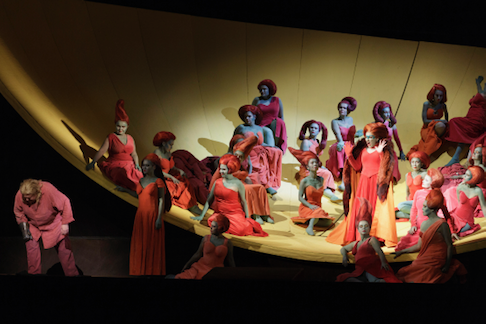 Stephan Gould as Hermann (far left), Ekaterina Gubanova (standing) as Venus
Stephan Gould as Hermann (far left), Ekaterina Gubanova (standing) as Venus
The Dresden Stadtskapell principal conductor, Israeli born, thirty-seven year old Omer Meir Wellber was in the pit for this seventy-first performance of the 1997 production by the famed German director Peter Konwitschny who was fifty-two years old at its premiere. The nineteenth century painting that was the show curtain disappeared during Mo. Wellber’s splendid account of Wagner’s famous overture to reveal a huge stage wide, tilted golden bowl into which a bevy of mythological Bacchantes joyously slid. We knew we were in for a good time.
When once again we were among the mortals of Wartburg director Konwitschny replaced the bowl with a huge, stage wide, acutely curved crescent shaped platform wittily reminding us that there were some slippery slopes ahead (Tannhäuser’s salvation). It can be mentioned that the high step up onto this soaring platform and ascending its slopes was challenging for some of the performers.
Of extraordinary pleasure were the male choruses, the theater’s immediate acoustic supporting the clarity of its uniquely beautiful tone, this acoustic as well permitting the voices of the protagonists to project clearly through even the most intense orchestral fortes. Though the actual words of Wagner’s poem were very present in our ears, and supertitles may have been superfluous, the Semperoper provides supertitles in German and in English (there are no supertitles at Bayreuth).
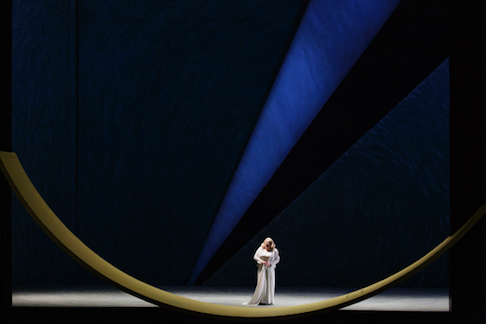 Ricarda Merbeth as Elisabeth
Ricarda Merbeth as Elisabeth
If the initial vocal and physical movements of American Heldon tenor Stephen Gould were clumsy, by the third act when we had arrived at his extended narration of his pilgrimage to Rome he redeemed himself, if unfortunately not spiritually certainly artistically, and we were genuinely moved by his torment and later by his death. German soprano Dorothea Röschmann delivered a solidly sung Elizabeth throughout, though she did not plumb the emotional depths of Wagner’s sublime prayer to the Virgin Mary. American baritone Christoph Pohl sang Wolfram in requisite beautiful voice and depth of feeling as Elizabeth’s rejected suitor.
Stage director Konwitschny pursuing his Berliner Ensemble roots made his few scenic elements into abstracted symbols of Wagnerian philosophical aspirations. Of special prominence were the outsized swords wielded first by Tannhäuser and the Baccantes, then by the knights of Wartburg and finally by Elisabeth as she crouched before Wolfram while he delivered his exquisitely sung hymn to the evening star. The sword became the Calvary cross born by Jesus in his sacrifice to save sinners, now borne by Elisabeth to save Tannhäuser’s soul — this a quite striking image.
The musical edition for this production seems to be a combination of Wagner’s 1860 Dresden version, his 1861 Paris version and his 1875 Vienna version. Though there was no Act I ballet, Venus did appear at the end of the opera tempting Tannhauser to return to her. And in this Konwitschny staging the rejected Venus does not disappear, but overcome, she caresses the dead Elisabeth while Tannhäuser whispers his final plea for salvation to Elisabeth, the offstage chorus of pilgrims extolling the infinite mercy of God.
Venus was sung by Russian mezzo Ekaterina Gubanova, a role that is perhaps wasted on this gifted artist of wide emotional range (cfr. her Paris Eboli). The Konwitschny production works in bold conceptual strokes, any subtleties in Mme. Gubanova’s discrete performance were invisible and superfluous.
If the Tannhäuser pit revelled in the acoustical glories of the Semperoper, the Holländer pit underscored the stylistic limbo of this first mature Wagnerian music drama. American conductor John Fiore favored a bright, Italianate sound, making no effort to explore the darker atmospheres that can make Wagner’s Dutchman a magical experience.
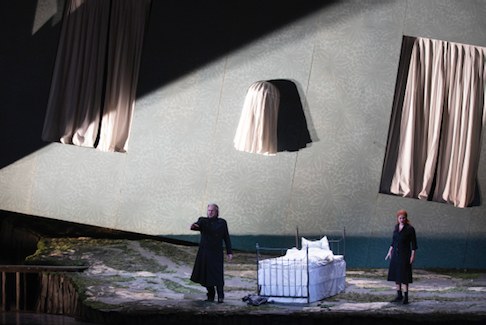 Act II: Senta's bedroom
Act II: Senta's bedroom
This was the thirtieth performance of this 2013 production by German opera and theater director Florentine Klepper. Most striking was the doubling of Senta with a pre-adolescent girl who rescued a wounded vulture during the overture and caressed it during much of the first act. She is also cruelly ensnared in fishing net by raucous sailors in the joyous music the closes the first act.
The spinning chorus of the second act brings thirty or so, identically dressed, pregnant women onto the stage who proceed to give live births on the stage (my third experience with scenic live births this year), Senta’s friend Mary is the midwife. The third act opens as a sort of marriage festival, with Senta’s father Daland lying Freudianly dead on a bed downstage left.
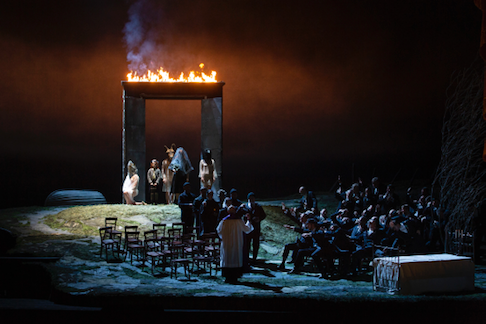 Act III marriage
Act III marriage
Said and done, the Dutchman exits stage left to board his ship, sacrificed forever to the sea, video projected vultures obsessively circling. Senta puts on a coat, picks up a suitcase and exits stage right.
As you can imagine we were on the edge of our seats struggling to make all this somehow make sense, and of course we heard Wagner’s music as never before. The Semperoper fielded a plausible cast and Mme. Klepper was vindicated. If not the masculine redemption Wagner intended, it was still high music drama indeed, Mme. Klepper making the case that the Wagner muse had set its sights well beyond the mid-nineteenth century to the moment when the feminine spirit was as redeemable as the masculine.
Senta was convincingly sung by German soprano Ricarda Merbeth, a role she performed last summer at Bayreuth. Korean born, Italian finished baritone Antonio Yang was the rich, youthfully voiced Holländer who projected a threateningly confident and finally a sympathetically complex character. Senta’s first love, Erik was sung by Croatian tenor Tomislav Mužek, also an alumnus of last summer’s Bayreuth Dutchman. Bass Georg Zeppenfeld of the original 2013 cast again sang Daland, Simeon Esper also from the 2013 cast sang the Steersman.
Michael Milenski
Cast and production information:
Tannhauser
Landgraf Hermann: Georg Zeppenfeld; Tannhäuser: Stephen Gould; Wolfram von Eschenbach: Christoph Pohl; Walther von der Vogelweide: Patrick Vogel; Biterolf: Jukka Rasilainen; Heinrich der Schreiber: Tom Martinsen; Reinmar von Zweter: Alexandros Stavrakakis; Elisabeth: Dorothea Röschmann; Venus: Ekaterina Gubanova; Ein junger Hirt: Tania Lorenzo. Sächsischer Staatsopernchor Dresden, Sinfoniechor Dresden, Staatskapelle Dresden. Conductor: Omer Meir Wellber; Staging: Peter Konwitschny; Set Design: Hartmut Meyer; Costume Design: Ines Hertel; Choir Jörn Hinnerk Andresen. Semperoper, Dresden, Germany, March 2, 2019.
Der Fliegender Holländer Holländer: Antonio Yang; Senta: Ricarda Merbeth; Daland: Georg Zeppenfeld; Mary: Michal Doron; Erik: Tomislav Mužek. Steersman: Simeon Esper. Sächsischer Staatsopernchor Dresden, Staatskapelle Dresden.
Conductor: John Fiore; Staging: Florentine Klepper; Set Design: Martina Segna; Costume Design: Anna Sofie Tuma; Lighting Design: Bernd Purkrabek; Video: Bastian Trieb. Semperoper, Dresden, Germany, March 1, 2019.
image=http://www.operatoday.com/Dutchman_Dresden1.png
product=yes
product_title=Der Fliegender Holländer and Tannhäuser in Dresden
product_by=A review by Michael Milenski
product_id=Above: Georg Zeppenfeld (standing) as Daland, Senta child double (kneeling) and Dutchman (foreground) [All photos courtesy of Semperoper Dresden]
March 8, 2019
WNO's The Magic Flute at the Birmingham Hippodrome
When I last saw Dominic Cooke’s 2005 WNO production of The Magic Flute, in 2015, it was part of a spring tour entitled Spellbound. Now, revived by Caroline Chaney, it’s back under the umbrella of ‘Monarchy’ - and it’s a very Magrittian umbrella, decorated with a dash of Dalí.
Julian Crouch’s box-like set comprises three cloud-strewn walls each punctuated by three tall wooden doors. The rear wall - on the doors of which an eerie hand hangs three placards: Nature, Wisdom, Reason - lifts to provide depth and to sharpen the perspective. It’s visually enchanting but on this occasion, I found the design quite confining.
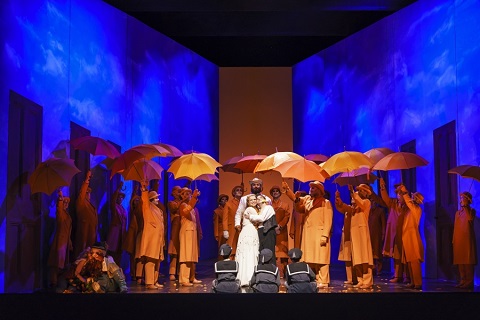 Photo credit: Bill Cooper.
Photo credit: Bill Cooper.
The Queen of the Night struggles to compel us from the darkness of the rear from which, swathed in smoke, she sings ‘O zittre nicht’. The Three Boys (who in this instance include one girl, Ruby Llewelyn) make their first appearance through the doors stage-left, though two of the sailor-suited lads didn’t quite come fully onto the set, remaining half-obscured by the half-opened doors; and, later, when they sailed on floating penny-farthings, the Boys cycled vigorously but went nowhere fast. Sarastro’s band of brothers rise up through trapdoors from nether regions, but only as far as their necks, and the effect was - at least for those seated quite close to the Hippodrome stage - a sea of disembodied singing bowler hats waggling orange umbrellas to signal their accord with Sarastro’s proposal that Tamino should join their brotherhood. There is a lot door-opening and -closing, and entering and exiting, but the overall impression was a general lack of movement. There was little sense of travels or trials; even the ferocious animals are lulled to stillness, rather than enchanted dancing, by Tamino’s magical flute.
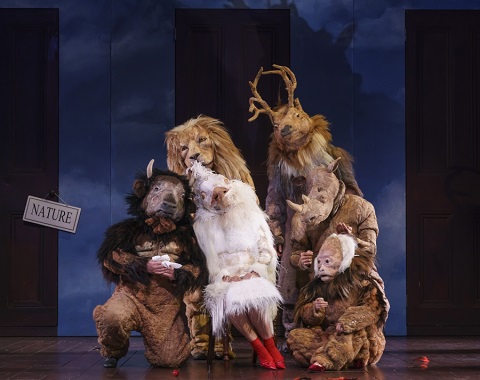 Photo credit: Bill Cooper.
Photo credit: Bill Cooper.
This puts a lot of responsibility on the cast and chorus, and instrumentalists, to create animation and convey the characters’ emotional journeys. Fortunately, WNO have gathered together some fine singers, several of whom are reprising their roles from previous runs. Mark Stone was a relaxed and worldly Papageno. His diction was unfailingly clear, his projection easy and there was a cheeky but beguiling touch of softly serenading sentimentality to his baritone. Stone’s humour was delivered with a mild urbanity which was slightly at odds with Papageno’s ruffled appearance. But, it was impossible not to warm to this genial and honest bird-catcher. Who would not delight when he netted himself his longed-for mate - a female ‘entirely like him’ (mir ganz gleich)? And as Stone and his Papagena (a bright and chirpy Claire Hampton) excitedly gathered up their rapidly multiplying progeny that were thrust through the trap-doors, who would not smile, perhaps a little wryly, at such a ‘happy ending’?
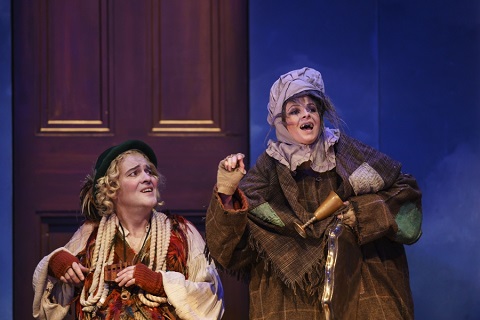 Mark Stone (Papageno) and Claire Hampton (Papagena). Photo credit: Bill Cooper.
Mark Stone (Papageno) and Claire Hampton (Papagena). Photo credit: Bill Cooper.
It’s hard, too, to imagine a more ideal Pamina than Anita Watson. Her rich, silky soprano wrapped itself lovingly around Mozart’s delicious melodies, and Watson’s well-shaped phrasing created strong character and spirit. ‘Ach, ich fühl’s’ managed to be heart-wrenching without Watson lingering overly long on the aching phrases, and she and Stone blended well in ‘Bei Männern welche Liebe fühlen’. Ben Johnson took a little longer to make his mark as Tamino, but his vocal characterisation grew in strength and Johnson’s pleasing tone captured the freshness of youth and newly discovered love.
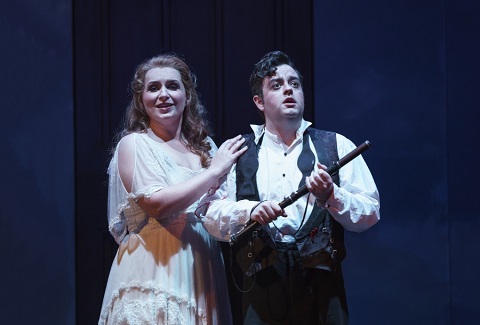 Anita Watson (Pamina), Ben Johnson (Tamino). Photo credit: Bill Cooper.
Anita Watson (Pamina), Ben Johnson (Tamino). Photo credit: Bill Cooper.
Anna Siminska reliably punched out the top notes - sparkling like the stars that we don’t actually see in this production - in ‘Der Hölle Rache kocht in meinem Herzen’, but I found her tone a little cold and her phrasing inflexible in the lower regions of her voice. Her Three Ladies were spirited: flirtatious and competitive rivals in displaying their ‘care and compassion’ for Tamino. along with a flash of suspender belt under their lady’s-maid aprons. Emma Carrington once again impressed as the Third Lady and she was very competently joined by Jennifer Davis and Kezia Bienek, vivacious First and Second Ladies respectively.
Jihoon Kim, replacing James Platt here in Birmingham, doesn’t really have the full lower notes to excel as Sarastro, and his effort to reach them sometimes resulted in a slight fuzziness, but Kim did his best to convey Sarastro’s gravity and compassion, even if the authority of his spoken text was marred by some distorted vowels. Howard Kirk’s Monostatos was no cartoon buffoon, and all the better delineated for the relative understatement; Kirk sang his aria cleanly and persuasively. I was impressed by Philip Rhodes’ Speaker, and Joe Roche and Laurence Cole put in fine performances as the First and Second Armed Man.
The Chorus sang with vigour and warmth, and conductor Thomas Blunt (standing in for Damion Iorio for these Birmingham performances) drew crisp playing from the WNO Orchestra.
I hope that Opera Today readers will indulge a digression to conclude, for Cooke’s visual surrealism got me thinking. The moral ambiguities of The Magic Flute - the implied racism and, even stated, misogyny - can be hard to reconcile today. Similarly, the opera’s apparent Enlightenment discourse sits oddly alongside its disturbing currents of irrationality. Such discrepancies have given scholars plentiful food for thought and speculation: Mozart’s opera has been explored from the perspective of 18th-century Freemasonry, and through the lens of Freud and Jung. Interpreting its esoteric symbolism in an article entitled ‘Layers of Meaning in The Magic Flute’, Joscelyn Godwin (Musical Quarterly 1999) proposed that we should see Pamina as Tamino’s anima - the feminine side of his spiritual nature - and Monostatos as Sarastro’s shadow, the dark side of his apparent benevolence.
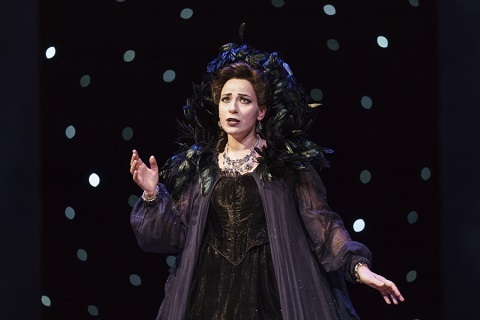 Anna Siminska (Queen of the Night). Photo credit: Bill Cooper.
Anna Siminska (Queen of the Night). Photo credit: Bill Cooper.
The principle of patriarchy has certainly proved one of the opera’s more problematic elements, leading Catherine Clément to argue, ‘If there is an opera that clearly shows, with all its verbal and musical power, the crushing symbolics of men over women, it is The Magic Flute.’ Citing the initiation of Pamina, others have rejected such accusations of anti-feminism.
So, what does this WNO production have to say in this regard, and might Cooke’s surrealism prove instructive? David Pountney suggests, in his programme note, that Mozart and Schikaneder’s Singspiel looks forward to a time when ‘man and woman, as represented by Tamino and Pamina, will rule together as equals’, seeming to agree with the late Rodney Milnes’ view that, ‘The synthesis of all the warring elements will herald a new, golden age of peace and wisdom’. Perhaps. But #MeToo suggests that such a future is still a utopian dream - as Pountney himself allows, ‘After over 200 years, we are still waiting for this future’.
Perhaps one day, a director will be brave enough to place the Queen of the Night on the side of moral righteousness and to make Sarastro the ‘bad guy’. Ingmar Bergman, in his film of the opera, made some gestures in this direction, as his unpublished film script (discussed by Rose Laub Coser in ‘The Principle of Patriarchy: The Making of The Magic Flute, inSigns, Winter 1978), reveals: ‘There is a disdain for women in The Magic Flute which is difficult to cope with’ and to get around this ‘we have changed the text a bit …’.
One can’t get away from the fact that whereas the male sphere in the opera is associated with clarity, truth and reason, and Sarastro’s music is composed and balanced, the female domain is characterised by darkness, deception and disorder. The threat of feminine irrationality is perfectly embodied by the Queen of the Night’s opera seria excess and contortions. But, perhaps the surrealism that Cooke employs as engaging visual decoration, could be used to probe deeper and more critically: to undermine connections between words, image and reality, and to subvert Sarastro’s professed ‘reason’ and ‘wisdom’. After all, Tamino and Pamina inhabit a frightening half-reality - dream or nightmare? - journeying through a Jungian wonderland of the subconscious and unconscious. And, like a fairy tale The Magic Flute plunders archetypal symbolism which is ripe for surrealist re-invention.
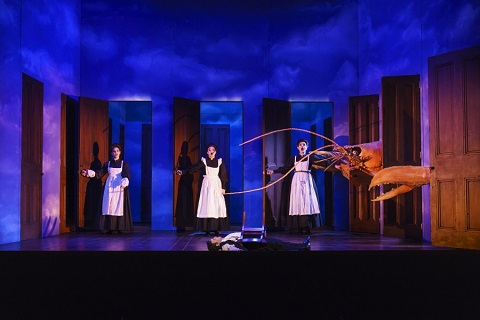 Three Ladies: Jennifer Davis, Kezia Bienek, Emma Carrington. Photo credit: Bill Cooper.
Three Ladies: Jennifer Davis, Kezia Bienek, Emma Carrington. Photo credit: Bill Cooper.
Umbrellas, bowler hats and umbrellas, depicted in a plain and conventional surface style, may intimate darker depths of the psyche. As Magritte explained, the bowler hat was the generic symbol of the bourgeois man, ‘The bowler…poses no surprise … It is a headdress that is not original. The man with the bowler is just middle-class man in his anonymity.’ But, surrealism makes the familiar strange. We think we know who the man in the bowler hat is, but do we really? The WNO programme reproduces Matisse’s Le Faux Miroir, which intimates wonder and fear: the eye both sees and reflects the world calling into question identity and the limitations of human vision. Moreover, in ‘Salvador Dalí’s Lobsters: Feast, Phobia, and Freudian Slip’ Nancy Frazier discusses Dalí’s use of lobsters as a symbol of danger and castration. In 1939, one of the exhibits in Dalí and George Platt Lynes’ photographic collaboration during the New York World’s Fair was entitled The Dream of Venus. One photograph depicted a nude female body across whose pelvic area was placed a lobster, the claws of which can lacerate other objects which, Frazier suggests, lends itself to become the perfect surrealistic symbol for castration. Moreover, the lobster only becomes vibrant orange-red when it is dead and powerless. Such reflections add a whole new dimension to Cooke’s rampaging crustaceans.
Claire Seymour
Mozart: The Magic Flute
Tamino - Ben Johnson, First Lady - Jennifer Davis, Second Lady - Kezia Bienek, Third Lady - Emma Carrington, Papageno - Mark Stone, Queen of the Night - Anna Siminska, Monostatos - Howard Kirk, Pamina - Anita Watson, Priest - Simon Crosby Buttle, Sarastro - Jihoon Kim, Speaker - Phillip Rhodes, First Armed Man - Joe Roche, Second Armed Man - Laurence Cole, Papagena - Claire Hampton, Three Boys - Cameron Lewis, Luke Samra and Ruby Llewelyn; Director - Dominic Cooke, Conductor - Thomas Blunt, Revival Director - Caroline Chaney, Staff Director - Sarah Crisp, Set Designer - Julian Crouch, Original Movement Director - Sue Lefton, Costume Designer - Kevin Pollard, Orchestra and Chorus of Welsh National Opera.
Birmingham Hippodrome; Thursday 7th May 2019.
image=http://www.operatoday.com/Title%20WNO%20Flute%202019.jpg image_description= product=yes product_title=The Magic Flute: WNO at Birmingham Hippodrome product_by=A review by Claire Seymour product_id=Above: Ben Johnson (Tamino)Photo credit: Bill Cooper
March 7, 2019
Puccini’s Messa di Gloria: Antonio Pappano and the London Symphony Orchestra
I found Antonio Pappano’s layout of the orchestra quite revealing; even obsessively gripping to listen to - and it was something he didn’t deviate from through all three works. Violins were antiphonally divided, double-basses placed to the extreme left, along with timpani behind them, and violas and cellos placed evenly across the centre of the orchestra. This may, in design, have been entirely organised this way for the second work on the programme - Verdi’s orchestration of his String Quartet in the version for full strings (in this LSO performance by a version that had been sanctioned by Verdi in 1877). Somewhat appropriately, this is a work which André Previn, who died last week, and who had a more than forty-year association with the London Symphony Orchestra, also conducted - and recorded with the Wiener Philharmoniker - though most often in the Toscanini arrangement.
The quartet is not really Verdi at his best. At times, you might even struggle to identify the work as by Verdi at all - something, for example, that you could never do with the string quartets composed by Beethoven, Bartók or Shostakovich - or even the few that Tchaikovsky wrote, all quartets which sound unmistakably by those composers. At times, this is a work that doesn’t seem very far away from Mendelssohn - but then it can also have the loftiness and gravity of German music. Rarely does it touch on being overly Italian, however - and it doesn’t have the inner-voices in the instrumentation or scoring that characterise so many of his operas. But Pappano and the LSO were something of a revelation in a performance that, if a little heavily phrased at times, brought considerable clarity to their playing. Those divided strings sometimes felt as if they were in a tennis match - the playing was just gorgeous, and very articulate. There was something balletic - recalling this composer’s Macbeth - to the Prestissimo and the fugue that dominates the final movement was ideal for the weight that Pappano drew from the LSO strings - a hallmark of their playing the entire evening. It’s quite uncanny how Germanic this orchestra is sounding these days.
Ponchielli’s Elegia - an undated work - but published only forty years ago - doesn’t really challenge the assumption that this is a composer who is going to suddenly become better known for a piece other than La Gioconda. It is very much what the title suggests it is and doesn’t delve much deeper. If it explores grief, it doesn’t come close to doing so in a cathartic way; there are no moments of epiphany, and the anguish never seems to be of the kind that mirrors loss or devastation. It wasn’t for a lack of trying from the orchestra - just that the music never quite allowed them to do much except play through it.
The main work on the programme was Puccini’s Messa di Gloria, a work begun when the composer was 20 and finished two years later. Granted this is a graduation piece by the young Puccini, but it remains an oddly unsatisfying work and I’m not convinced that even Pappano’s advocacy of it would persuade me otherwise. It’s been argued that’s it not really a messa in the conventional sense at all - more a mass. It remained largely unperformed in Puccini’s lifetime, indeed he ended up taking pieces from this early work (such as the Agnes Dei) which was to find a place in Act II of Manon Lescaut. The solo voices, too - written just for a tenor and a bass-baritone - also give the work a somewhat darker colour, especially compared to Rossini’s Messa di Gloria which uses a wider vocal range. But Puccini is clearly of the view that this should be a sacred work - in its entirety - and there is no question we are getting into the territory with a piece like the Verdi Requiem of debating whether religious works should breach the barriers between the sacred and the operatic.
It’s the twenty-minute Gloria which forms the backbone of this piece - and if you can sometimes detect militaristic writing from Verdi in it (such as Aida) that’s because Puccini, like a magpie, seems to consciously or otherwise, draw on this. The LSO brass, if anything, were a touch understated - something one couldn’t say of the gloriously full-throated chorus. The first entry of the tenor at ‘Gratias agimas tibi’ - here sung by Benjamin Bernheim - sounded a little nervously done but he quickly found his stride and by the time he sang his second solo, ‘Et incarnatus’, he was a powerful and resonant presence. His voice can sound extraordinarily lyrical, even beautiful - in short, it’s an ideal Puccini voice. But the composer doesn’t make it easy for his two soloists (especially the bass-baritone) who are sat around for a considerable period of time before having to sing a note. Bernheim looked the more nervous of the two; Gerald Finley seemed the more confident, head buried deep in his score - but appearances proved deceptive. Finley is a singer I have found troubling in the past - his Scarpia at Covent Garden in January 2018 I had found very underpowered - and I didn’t find either his ‘Crucifixus’ or his ‘Benedictus’ sung here to be an improvement on that. His ‘Crucifixus’ almost disappeared under the basses of the chorus, though Puccini’s adagio tempo is hardly helpful. Only in the Agnes Dei do we the get the bass-baritone and tenor singing in unison - the only real moment in the Messa where Puccini really strives towards the operatic in a work which is entirely devoid of it. It’s an oddly muted ending, tailing off and making the Messa almost sound an incomplete work.
The combined forces of the LSO Chorus had been extraordinarily accomplished throughout this performance - some of the cappella singing had been of a very high quality, for example. Pappano drew exquisite playing from the orchestra - they clearly have considerable rapport with each other. An unusual programme of late Italian Romanticism certainly, and an uneven one as well from composers better known for their operas, despite the unquestionably high artistic standards which it often reached. This was also filmed live by Medici TV and can be watched until June 3rd 2019.
Marc Bridle
Benjamin Bernheim (tenor), Gerald Finley (bass-baritone), Sir Antonio Pappano (conductor), London Symphony Orchestra and Chorus.
Barbican Centre; London 3rd March 2019. image=http://www.operatoday.com/Gerald%20Finley.jpg image_description= product=yes product_title=LSO conducted by Sir Antonio Pappano product_by=A review by Marc Bridle product_id= Above: Gerald Finley
WNO's Un ballo in maschera at Birmingham's Hippodrome
The conflict between private passions and public obligations is currently also exercising English Touring Opera . Here, though, Pountney seems less interested in his monarch’s regal responsibilities than in his thespian inclinations with the result that both the love triangle which spawns vengeful jealousy and the political conspiracy with which the former becomes entwined, with tragic consequences, are overshadowed by theatrical conceits, with Riccardo more stage director than sovereign potentate. In Un ballo Verdi balances private intimacy with public spectacle, but Pountney, Bauer and Lecca give us not so much grandeur as gothic Grand Guignol grotesquery.
I should start, though, by saying that musical values and achievements are very high indeed in this production, and that however diverting (and, admittedly, at times entertaining) the games and japes in which Pountney indulges, the director makes space for Verdi’s beautiful score to breathe. Carlo Rizzi presides in the pit and masterfully overseas a performance characterised by strongly defined and delineated musical moods and strokes. A whispered pianissimo at the start of the overture immediately established a conspiratorial air, and the tautness of the gruff fugato which conjures the schemers’ intriguing tightened the screw further. Spine-twitching gun-shot chords initiated Act 1 Scene 2, but such hyperbolic gestures were complemented by melodic shaping of touching beauty; the aching cello obbligato which accompanies Amelia’s melancholy aria ‘Morrò, ma prima in grazia’ in Act 3 typified the prevailing expressive eloquence, and was matched by the cor anglais’ haunting commentary during Amelia’s grand scena in Act 2. This was some of the best orchestral playing - stirring colours, pinpoint details, confident ensemble and spot-on tuning - that I have heard from the WNO Orchestra.
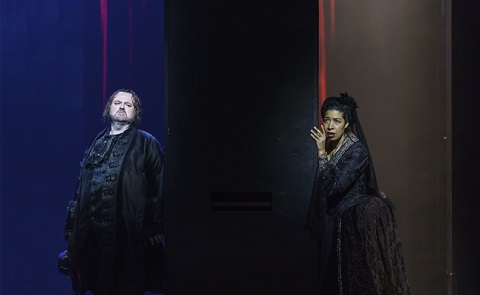 Gwyn Hughes Jones (Riccardo), Mary Elizabeth Williams (Amelia). Photo credit: Bill Cooper.
Gwyn Hughes Jones (Riccardo), Mary Elizabeth Williams (Amelia). Photo credit: Bill Cooper.
Pountney has reunited the central pair of star-crossed lovers from last year’s production of La forza del destino and tenor Gwyn Hughes Jones and soprano Mary Elizabeth Williams once again exhibit power, stamina and subtlety as Riccardo and Amelia. Though there was some occasional roughness as his voice swelled in its lower regions in Act 1, Hughes Jones relished the more expansive moments of heroic lyricism. He really acted with his voice during the scene at Ulrica’s ‘urban coven’, and ‘Di’ tu se fedele’ sparkled with insouciant recklessness. Hughes Jones’ Italian diction was consistently excellent, and he captured all of the monarch’s presumption, paranoia and impetuousness, though Pountney’s conception deprived the King of true nobility.
This Amelia is a little one-dimensional - not really Williams’ fault as she too is rather pushed to the hinterland by Pountney’s conception - but she can float a phrase glorious and use the gentle edge of her soprano to garner our sympathy and convey emotional realism. Ronald Wood was returning to a role in which he so impressed at Grange Park Opera last summer, and if Wood seemed a little less central to the dramatic thrust of the opera this time round, when able to let Renato’s vengeful energies off the leash in Act 3’s ‘Eri tu che macchiavi quell’anima’, Wood was compelling.
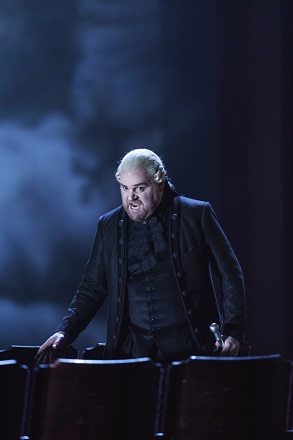 Roland Wood (Renato). Photo credit: Bill Cooper.
Roland Wood (Renato). Photo credit: Bill Cooper.
Despite such musical luxuries, at times I found Pountney’s concept - or multitude of concepts - somewhat taxing. First, the location. After the Revolutions of 1848, the crowned personages of Europe were understandably twitchy about ensuring that their own heads stayed attached to their shoulders, and when Verdi and his librettist Antonio Somma presented the subject of Gustav III of Sweden’s assassination as the subject for the composer’s next opera the censors were rattled, forcing the duo to relocate the action to colonial Boston. And that’s ‘where’ the opera premiered when seen for the first time in Rome in 1859; it took another seventy-six years for it to find its way home to its Swedish origins, in a production staged in Copenhagen.
Pountney plumps for a Swedish setting - though he retains the characters’ Italian names: why not go the whole hog? - at the time of the assassination of Gustav III, a man he describes as “enthralled by theatre and disguise”. Indeed, this ‘enlightened despot’ who ruled from 1771 to 1792 - when, at a masquerade ball, he was surrounded by five black-cloaked assassins, one of whom cried, “Bon soir, beau masque”, before shooting the King in the back - was a devotee of the arts, and especially the theatre. He established the Music Academy in 1771, the Academy of Painting and Sculptury in 1773, the Academy of Belles Lettres, History and Antiquities in 1786 and the Swedish Academy that same year. A writer of plays himself, Gustave found The Royal Great Theatre/The Royal Opera in 1782.
So, Pountney makes his Gustav a sort of Prospero, directing his own life story - not exactly from the wings, but rather from centre-stage. Throughout, ‘Riccardo’ consults a little leather-bound red book - presumably directorial notes - and the ‘walls’ which form the set are revolved by pronouncedly visible stage-hands. Rows of theatre seats, not unlike those we are nestled in, are placed far stage-right so that the characters can spectate unfolding events. When we reach the gallows scene, these walls are robed in velvet red curtains.
Indeed, our first ‘sighting’ of Riccardo is not seated on his throne, but ‘hiding’ in a black sarcophagus, with a leather-suited Oscar prone in mourning across the state coffin. We might be in Gustav Adolfs Torg Square which houses the Opera House and Jacobs church; or, we might be beside an Italian tomb. The shadow of death is cast across proceedings and there’s no doubting Riccardo’s fate: but, actually, its all a jolly jape - the lid of the ebony casket opens and out climbs Riccardo, alive and kicking, to the playful Oscar’s joy! Sung at this performance by Harriet Eyley (replacing Julie Martin du Theil), this Oscar is Ariel to Riccardo’s Prospero, relishing his master’s machinations and whipping off the wig of the Judge (Gareth Dafydd Morris) who wants to banish Ulrica before racing up to the uppermost window above the square, poking his head through the curtain, and defending the fortune-teller while derisively waggling a grinning, carnivalesque head on a stick. Perhaps Pountney is invoking Mikhail Bakhtin’s theory of carnival, and the relationship between laughter, sex and death? And, perhaps this isn’t so far-fetched given the opera’s premiere during the Carnival season in Rome, the custom of crowning and then uncrowning a Carnival King, the opera’s tropes of masking and disguise, and the fact that Oscar is a travesti role?
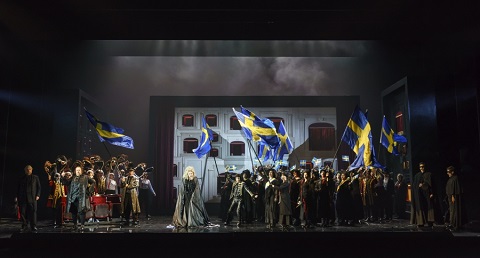 Sara Fulgoni (Ulcrica) with WNO Chorus. Photo credit: Bill Cooper.
Sara Fulgoni (Ulcrica) with WNO Chorus. Photo credit: Bill Cooper.
Whatever, Ulrica (Sara Fulgoni) herself makes the first of her many - often unscripted - appearances in this opening scene, for Pountney makes the soothsayer a prominent presence, much in the same way that Justina Gringytė’s Preziosilla haunted last year’s La forza. We also meet the conspirators, squashed under the coffin, revealed by the lifting of the black drape; cloaked and masked, they seem to have stepped from the pages of a comic strip and it’s hard to believe that they present a credible threat to Riccardo. The ‘seriousness’ of the drama is further quashed at the end of the opening scene when the Chorus whip off their top hats and tails, and trade them for naval and pirate costumes complete with tricorns and eye-patches. When they essay a conga around the stage we’ve crossed into Gilbert & Sullivan territory.
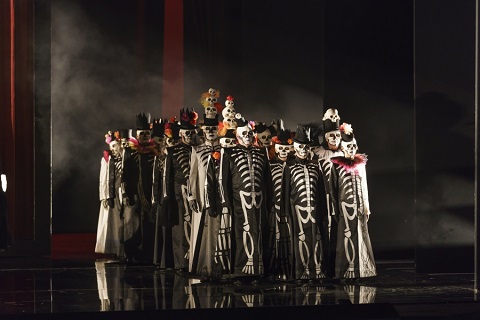 Photo credit: Bill Cooper.
Photo credit: Bill Cooper.
The gothic excess is pushed to extremes in Act 1 Scene 2. Ulrica is a sort of Madame Blavatsky surrounded by billowing smoke and grim acolytes thrusting fateful fingers-on-sticks and dollar-sloganed tin-cans at gullible punters. Fulgoni doesn’t always surmount the orchestral fabric but she sings with blazing intensity. Later both she and the dark-toned conspirators, Samuel (Jihoon Kim) and Tom (Tristan Hambleton) are whizzed about on a high chair on wheels - is this an allusion to the Throne of State of Milton’s Satan in Paradise Lost? By the time the top hats have sprouted lycanthropic adornments with flashing red eyes, the acolytes begin stabbing needles into red poppets, and the orange-lit wall niches are filled with skulls, we’ve truly wandered onto a Rocky Horror Show set. In a crowning gesture, in the final scene the Chorus’s elegant evening dress is shed to reveal enough skeletons to seriously rattle the censors; it’s the Day of the Dead, clearly, but the destined corpse doesn’t die. Instead, Riccardo watches as a cipher takes the knife.
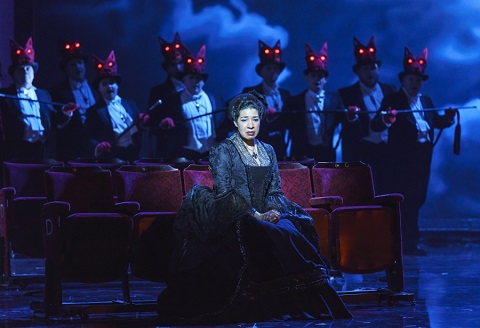 Mary Elizabeth Williams (Amelia) and WNO Chorus. Photo credit: Bill Cooper.
Mary Elizabeth Williams (Amelia) and WNO Chorus. Photo credit: Bill Cooper.
It’s almost as if Pountney has presented Verdi’s opera at one remove, allowing the director - or the Swedish King himself - to present his own ballo in maschera of Verdi’s Un ballo in maschera. Clever stuff, and often intriguing, but occasionally baffling.
Claire Seymour
Verdi: Un ballo in maschera
Riccardo - Gwyn Hughes Jones, Amelia - Mary Elizabeth Williams, Renato - Roland Wood, Oscar - Harriet Eyley, Ulrica - Sara Fulgoni, Judge - Gareth Dafydd Morris, Silvano - Jason Howard, Amelia's Servant - Andrew Irwin, Samuel - Jihoon Kim, Tom - Tristan Hambleton; Director - David Pountney, Conductor - Carlo Rizzi, Set Designer - Raimund Bauer, Costume Designer - Marie-Jeanne Lecca, Lighting Designer - Fabrice Kebour, Choreographer - Michael Spenceley, Associate Director - Robin Tebbutt, Orchestra and Chorus of Welsh National Opera.
Birmingham Hippodrome; Wednesday 6th March 2019.
image=http://www.operatoday.com/Gwyn%20Hughes%20Jones%20Riccardo.jpg image_description= product=yes product_title=Un ballo in Maschera: Welsh National Opera at the Birmingham Hippodrome product_by=A review by Claire Seymour product_id= Above: Gwyn Hughes Jones (Riccardo), Roland Wood (Renato) Mary Elizabeth Williams (Amelia)Photo credit: Bill Cooper
March 6, 2019
Super #Superflute in North Hollywood
And as ingenious Executive and Artistic Director Josh Shaw has reimagined the piece (marketed as #Superflute), the staging is also just about as relentlessly and adorably rambunctious, all the while proving to be commendably musically refined.
In tandem with E. Scott Levin (also the evening’s Papageno), the duo have created libretto and lyrics that set this evergreen Mozartian musical fantasy in the milieu of 1990’s video games and have peopled its cast with a fascinating interaction of disparate heroes, royalty, and nemeses plucked from varied sources.
Truth up front: this writer never played any of those games, and aside from a couple of personages that became pretty unavoidable pop icons, I wasn’t much aware of the sources. Will it surprise you to know that it didn’t matter? Not a bit. To their immense credit, Mssrs. Levin and Shaw have honored the original character relationships with amazing fidelity, and they have actually enhanced the clarity of what is after all a Singspiel whose storylines, style, unities, symbolism, subtext, and parallel plots are all over the map.
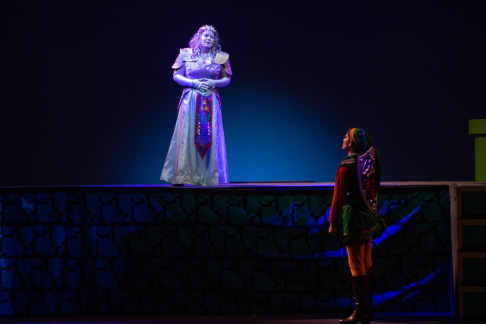
Indeed, a pantomime during the overture set it all up, as couch potato gaming geeks fought over which program they would upload and participate in. As a long-suffering parent “pulls” the plug on the equipment, the projections take on a “magic” life of their own and further clarify the characters by listing the players with their video game alter egos. Holy Wolfgang, that’s pretty clever stuff. Those of us “in the dark” were enlightened, while those “in the know” were spun into a minor frenzy of recognition and camaraderie.
All this would mean little were it not for the high standard of the singing and playing, and here POP really excelled. The afore-mentioned E. Scott Levin was a wholly winning Papageno (Mario Brothers Plumber). His clichéd Italian accent, charismatic engagement with the audience, and larger than life, obfuscating underdog demeanor endeared him to one and all. If Mr. Levin’s incisive baritone sometimes threatened to verge on a hectoring delivery, and if his intonation veered a bit in the duet with Pamina, his was nonetheless an assured, appealing traversal of a role that can and does walk away with the show.
Pride of place for radiant singing has to go to the assured, ringing Tamino (Link) from Arnold Livingston Geis. His polished performance was quite simply as good as it gets. Mr. Geis has a sizable lyric instrument that lavishes honeyed tone on all registers and at all volumes. His secure technique and stylish phrasing enrich the production immensely, and moreover, Arnold is handsome, winsome, and every other sort of “some.” And wittily funny to boot. It will be a pleasure to watch his star rise as it surely will.
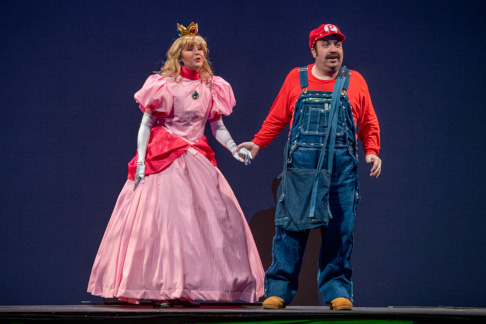
Alexandra Schoeny deployed an uncommonly alluring, bronzed soprano as Pamina (Princess Peach), and she brought admirable dramatic spunk and sentiment to the mix. Her gleaming sound above the staff was complemented by a rich middle register, with her well-schooled tone evenly knit throughout the range.
In the notoriously difficult role of the Queen of the Night, Michelle Drever was quite an assured exponent. She dispatched both of her arias with aplomb, imbuing the slow sections with well calculated pathos, and the rapid-fire coloratura with crackling ferocity. If the lowest parts of the role lacked the same presence as the ringing top, well, no one comes to hear the Queen’s low “f”, do they?
Andrew Potter’s Sarastro was everything one could wish, his darkly sonorous, rolling bass the exact fit for his imposing music. The fact that his physical presence towers above the rest of the cast, and that he manages to somehow find the role’s dignity even in a Donkey Kong ape suit, is a testament to his mature, persuasive interpretive gifts. He also embraces the script’s humor with good-natured gusto.
Robert Norman was a wiry, characterful Monastotos (Mario Brothers Luigi), his secure, nimble tenor emanated from a fleet-footed, loose-limbed physicality that was benignly menacing. Laura Broscow proved a wholly enchanting Papagena, first as a frisky old woman high on a Geritol overdose, then as a perky princess with gold in her heart and silver in her voice. She mined every bit of humor in her duet, all the while singing it with accuracy, verve, and lilting tone.
The Three Ladies were very well-matched. Soprano Tara Whecker led the trio commandingly as First Lady; Ariel Pisturino’s plush mezzo served the Second Lady well; and Third Lady Megan Potter grounded the ensemble with her plummy alto phrases. The Spirits, often cast with boys, were on this occasion very well performed by a second trio of talented ladies. The lighter voice qualities of the assured vocalists Emily Rosenberg, Amanda Bernjamin, and Christine Maris Li entwined to beautiful effect and proved a highly effective aural balance to the weightier tones of the Ladies.
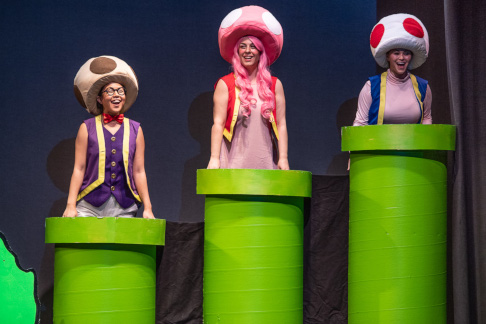
As the two Priests and the Armored Men, Jonathan Mathews and Joshua Alarcon dispatched their brief but important moments with accomplished vocalizing. Mr. Matthews sported a solid tenor that soared in the arching Priest duet, then proved to have the correct stentorian leanings in the chorale. Mr. Alarcon’s pleasing, slightly grainy baritone fell easily on the ear, and he ably complemented his partner, providing a solid foundation for the ensuing trio and quartet.
Edward Benyas indeed worked some “magic” in the pit with his assured baton eliciting stylish results from a sizable orchestra. The accomplished playing was all the more laudable since the band seemed to include a number of very young players. I have heard many an established house orchestra struggle with this varied score. It is to Maestro Benyas’ great credit that the musical execution was of a very high order throughout.
Mr. Shaw’s colorful, cheeky set design constantly strives for variety and visual interest. However, perhaps it is busier than it needs to be. Cumbersome staircases get moved fairly often simply to create a new look, different levels, or a structural element that sometimes seemed superfluous. Even though the moves were accomplished with precision and haste, they still slowed down the action and prompted the addition of orchestral music (from The Impresario) to fill the silence. And the continually changing painted cloths, fronting the wall-to-wall elevated central platform were too frequently peeled away to the riiiiiiiiiiiiiiiiiiiiiip of Velcro.
However, it has to be said there were a surprising number of special effects that tickled the eye: the revelation of cartoonish “rolling waves” under the platform, the three green stovepipe like structures that allowed characters to appear from behind and mount them, and the obstacles that appeared in the trials that had Tamino and Pamina comically hopping over them a la a video game skill challenge. In fact, the presentation of the trials was arguably the most effective I have ever seen, especially as they were presented as prerequisite to get to the next “level” of video play.
Maggie Green’s costumes ably captured the look of each iconic character’s attire and provided a riot of color and imagination. For future outings of this edition, a couple of the women’s dresses might be adjusted in certain details to better flatter the actual singers’ physical attributes rather than just recreating the original cartoon costume. However, that does not diminish Ms. Green’s over the top accomplishment in devising a wackily diverse assemblage of eye-popping dress and wigs.
Bo Tindell illuminated the proceedings with a good eye for color washes, effective area isolation, and well-judged specials. The design also managed to keep the video show backdrop and overall lighting in good balance the entire evening.
The ubiquitous Josh Shaw has directed the enterprise with a knowing sense of pace, well choreographed set changes, overall commendable traffic management, effective use of the playing space, and inspired comic business. I will not soon forget the invasion of a profusion of inflatable bananas in a Sarastro (Donkey Kong) dominated scene, with the entire animated cast brandishing them, batting them around, and cavorting about in inspired lunacy.
I would encourage the director to consider adding a movement specialist to the team. Stage pictures sometimes got repetitious or cramped, dance steps were unnecessarily limited by sameness, and character relationships might have been more meaningfully developed with better spatial interplay. And I do wish that some self-conscious jokey dishing of operatic conventions could be redirected into the character-based humor of the vast bulk of the piece.
If any purists were left standing in the face of this indisputable audience pleaser, they might wish for some cut material, like the Speaker-Tamino exchange to be reinstated. But these are minor quibbles in what was for me, a minor triumph of reimagining and retelling a jumble of a masterpiece, thereby making it more comprehensible and enjoyable to a contemporary audience.
I loved it. I think Mozart would have loved it. If not, to hell with him! POP’s The Magic Flute lives up to its #Superflute marketing handle in most every aspect imaginable.
James Sohre
The Magic Flute
Tamino: Arnold Livingston Geis; Pamina: Alexandra Schoeny; Papageno: E. Scott Levin; Queen of the Night: Michelle Drever; Sarastro: Andrew Potter; Monostatos: Robert Norman; Papagena: Laura Broscow; First Lady: Tara Whecker; Second Lady: Ariel Pisturino; Third Lady: Megan Potter; Priest/Armored Man: Jonathan Matthews, Joshua Alarcon; First Spirit: Emily Rosenburg; Second Spirit: Amanda Benjamin; Third Spirit: Christine Marie Li; Conductor: Edward Benyas; Director and Set Design: Josh Shaw; Costume Design: Maggie Green; Lighting Design: Bo Tindell
image=http://www.operatoday.com/flute-1112.jpg
image_description=Scene from The Magic Flute [Photo by Martha Benedict]
product=yes
product_title=Super #Superflute in North Hollywood
product_by=A review by James Sohre
product_id=Above: Scene from The Magic Flute
Photos by Martha Benedict
Leading Ladies: Barbara Strozzi and Amiche
I am ashamed of my doubt. Every program by Stephen Stubbs’ ensemble Pacific MusicWorks is thoroughly researched, meticulously rehearsed, and refreshing to the ear. This one surpassed any reasonable expectations.
To begin with the soloists: Danielle Sampson and Tess Altiveros are both formidable singers technically, with an astonishing command of 17 th century vocal technique; but how could one anticipate that they would also have the vivid presence of a Ziegfeld sister-act?
Sampson’s instrument is pure, virginal, but capable of conveying innuendo lusty as a wink with an infinitesimal bluesy bend of a note; Altiveros’ sound is darker, creamy, sensuous, but she can fill it with so much drama that the stereotyped tropes of a Baroque lament offers a fully rounded portrait of a woman’s pain. Together, they are sprezzatura personified.
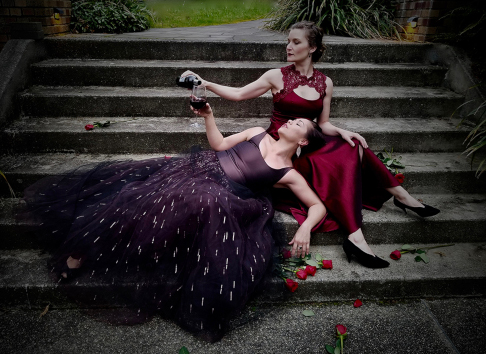 (left to right) Tess Altiveros and Danielle Sampson
(left to right) Tess Altiveros and Danielle Sampson
Barbara Strozzi (1619-1641) is by now a known quantity, at least in “early music” circles, but I wasn’t ready for the expressive range of her gifts: eight numbers spanning subjects from a lover’s lamenting how his love has harmed the beloved to a song demanding that Cupid get up and active that reminds me of Cole Porter at his most outrageously risqué.
Less individual but still powerfully crafted were two arias and a sensuous hymn to the Virgin by the operatic pioneer Francesca Caccini. Antonia Bembo’s fulsome encomium of Louis XIV Chiaro esempio is effective if embarrassing, a perfect illustration of the icky side of patronage.
Most surprising were three instrumental “sonatas” (she composed 12 in the course of her 60-year career) of the Ursuline nun Isabella Leonarda of Novara. Such instrumental “breaks” are common in early-music vocal concerts. They are never merely breaks in PMW evenings. The group’s wonderful “house band” brought out the highly individual character of each brief suite, and the audience responded to each with growing enthusiasm, ending in a genuine and deeply deserved ovation.
Roger Downey
Leading Ladies: Barbara Strozzi and Female Virtuosi in 17th Century Italy
Danielle Sampson and Tess Altiveros, sopranos; Pacific MusicWorks (Tekla Cunningham and Adam LaMotte, baroque violin; Caroline Nicolas, violoncello and viola da gamba; Henry Lebedinsky, harpsichord and organ; Maxine Eilander, baroque harp; Stephen Stubbs, musical director, baroque guitar and lute) at St. Stephen’s Episcopal Church, Seattle, Washington
image=http://www.operatoday.com/Leadingladies%202%20ifor%20OToday%20.jpg image_description=Left to right: Caroline Nicolas, Adam LaMotte, Tekla Cunningham, Danielle Sampson, Tess Altiveros, Maxine Eilander, Stephen Stubbs [Photo by Elizabeth Ellis] product=yes product_title=Leading Ladies: Barbara Strozzi and Female Virtuosi in 17th Century Italy product_by=A review by Roger Downey product_id=Above (left to right): Caroline Nicolas, Adam LaMotte, Tekla Cunningham, Danielle Sampson, Tess Altiveros, Maxine Eilander, Stephen StubbsPhotos by Elizabeth Ellis
George Benjamin’s Into the Little Hill at Wigmore Hall
An Ensemble Modern commission, here receiving its United Kingdom premiere, Milliken’s Bright Ring spoke, to quote the composer, of ‘fields of energy that I perceived whilst performing with the Ensemble Modern,’ an energy ‘of collaboration and interaction, whether pulsing or still (or both)’. I initially read such lines with a degree of scepticism, but having heard the piece, they made a good deal of sense, the idea furthered by the title reference to the line, ‘Bright is the ring of words’, from a Robert Louis Stevenson poem, and the rings of Saturn. Two violins vied with each other at the opening, joined by viola and intermittently others, in music that seemed to depict and/or express both pent-up rhythmic violence and something (ring-like?) more numinous, often led by flute or tuned percussion. There was, I think, a sense of something akin to an extra-terrestrial landscape and narrative, not in a filmic way, but perhaps more akin to the tone poems of the past. The close, in which a flickering cello line initiated a final explosion, thereafter subsiding, seemed once again to encapsulate that tension between ensemble and solo instrument, planet and ring, pulse and its withdrawal.
Christian Mason’s 2015 Layers of Love, written for and recorded by Klangforum Wien, announced itself with slithering, mysterious microtones. Movement in various ways, rhythmic and harmonic, was initially slow and hard won, yet undeniable. There was a strangeness that seemed more of this world than Milliken’s other, but I am not sure I could explain what, practically, I mean by that. Certainly there was drama, albeit less pictorial than in the previous work. More than once, Bernd Alois Zimmermann came to my mind: again, I am not entirely sure why, but think it may have had something to do with the ultimately achieved rhythms and their relationship to sound, not least from the double bass.
Dallapiccola’s Piccola musica notturna spoke with the distilled mastery of a true classic, as perfectly formed in work and performance as a piece by Mozart, Schoenberg, or Debussy. Indeed, rather to my surprise, I found something naggingly Debussyan, if only in correspondence, to the turns of several phrases, however different the serial method one could hear and feel as clearly as if chez Schoenberg or his pupils. It was not difficult to understand what might have attracted Benjamin to so exquisitely logical, warmly expressive a miniature. If ever there were a composer whose music we should hear far more often…
I had last heard Into the Little Hill only in September, in Berlin , also conducted by the composer, albeit with the Mahler Chamber Orchestra. Its small performing forces (two vocal soloists and ensemble), formal perfection, and dramatic power render it a highly attractive work for regular performance, whether on stage or in concert; yet possession of such qualities does not always translate into such (relative) popularity. In this case, as with Benjamin’s two subsequent, larger-scale operas, Written on Skin and Lessons of Love and Violence , it is heartening to report that widespread enthusiasm continues. Stravinskian incision, violence, and economy, marked the opening - not just for itself, but as the opening to this complete (compleat) drama of modern political life, more bitingly relevant, so it seems, with every hearing. Whether it were the cool hieratic (Symphonies of Wind Instruments ?) quality to the Minister’s addressing the crowd; the latter’s controlled yet increasing hysteria; the deathly tension of electric woodwind lines as the Minister meets the Stranger; or the latter’s wheedling, seductive way (heightened no end by Anu Komsi in particular, likewise her bloodcurdling cries ‘Swear by your sleeping child’): one could have cut the air with a knife - and that only in the first scenes to Part One.
As so often, operatic mastery shows itself particularly in the interludes between scenes. What a composer says and does not, unconstrained by words and indeed voices, will often - not always - penetrate to the heart of his or her musical dramaturgy. Such was certainly the case here, both in work and performance; so too in orchestral writing and playing elsewhere, as for instance in the terror of the intricately inviting processional that underlies the scene between Mother and Child. ‘The rats will stream like hot metal to the rim of the world.’ Indeed, they would - and did. A similar observation might be made of the division into two parts, the latter’s opening sounding and feeling strongly as if a new act, as if marking the return from an interval for the opera’s final, fatal events to unfold. ‘And music?’ ‘All music - smiles the minister - is incidental.’ Not at all. For the true rodent ghosts were now in the machine; so too, led by far-from-incidental music, was the child whose grasping, mendacious politician of a father had stolen its future. The will of the people had been enacted: The Little Hill meant The Little Hill.
Mark Berry
Cathy Milliken: Bright Ring (UK premiere); Christian Mason: Layers of Love; Dallapiccola: Piccola musica notturna; Benjamin: Into the Little Hill. Anu Komsi (soprano); Helena Rasker (contralto); Ensemble Modern/George Benjamin (conductor).
Wigmore Hall, London, Tuesday 5 March 2019.
image=http://www.operatoday.com/Anu%20Komsi.jpg image_description= product=yes product_title=George Benjamin and Frankfurt’s Ensemble Modern at Wigmore Hall product_by=A review by Mark Berry product_id= Above: Anu KomsiPhoto credit: Maarit Kytöharju
Marianne Crebassa sings Berio and Ravel: Philharmonia Orchestra with Salonen
What cannot be denied is that she brought an extraordinary, and riveting, ability to communicate through her voice - to project drama in a very compelling way; audiences were fascinated by her artistry and virtuosity. It was this which the mezzo-soprano, Marianne Crebassa brought in spades to her performances of the Berio - and, later, Ravel - in this magnificent concert.
Crebassa does lack the range - and certainly the roughness - of Berberian but they share a commonality of expression for Berio’s Folk Songs and it would be hard to imagine a more theatrical outing of them than the one we got here. Berio originally composed the songs in 1964 for voice, flute, clarinet, harp, viola, cello and percussion - but orchestrated them nine years later, though the scale of the instrumentation (although for a large orchestra) remains unconventionally intimate. They can sound a little conservative, even harmonically unchallenging for Berio - but vocally they are complex and difficult, even though idiomatically the folk genre is a fairly narrow one for the singer. That challenge is magnified by the multiple languages in which the songs are written, often in native dialects from Armenia, Azerbaijan, Sicily, Northern Italy and Sardinia. Berio’s sources - from sheet music, records and oral recollections, or, in the case of the final song, a transcription by Berberian herself done not knowing the language at all (and marked as “untranslatable” on the surtitles) simply convey and reinforce the typical traits of the cultural frame from which the songs originate - traits which are very often disguised or sublimated.
Crebassa was completely absorbing throughout the twenty or so minutes these eleven songs played for. Whether it was from the two opening American songs - by John Jacob Niles - in which Crebassa brought a kind of Kentucky, whisky- soaked swell to her voice or ‘Rossignolet du bois’ where a nightingale serenades a lover (the sound of the nightingale was later to feature in the closing work on this programme, Pines of Rome, though no one was entirely sure if it did) the voice was inflected with colour and drama throughout. Humour abounded too; the allusion to apples and testicles was wittily done, and clearly not something which passed over the heads of this audience. Songs about fishermen’s wives waiting at the dockside, men and marriage - Crebassa sung them with laughs in mind (and they were duly given in response). These songs rarely seem to be characterized by a depth of expression - but the aphorisms they express seem somewhat timeless, nevertheless. “Ballo” may start each of its two stanzas with frivolity, but Crebassa brought the wisdom of Cassandra to her prophetic announcement that the wisest of men lose their heads over love, and still more love resists the sun and ice and everything else. Likewise, in Canteloube’s Songs of the Auvergne there is the paradox that men who have no wives wish they had one, and those who have one wish they didn’t. It was delivered magnificently. That final song, which Berberian had transcribed, in some ways seems the most difficult - the language almost a little nonsensical. It barely seems to be sung with punctuation marks at all - but Crebassa’s breath control was extraordinary. Lines like ‘syora die limtchésti snova, papalm’ came across as poetic but, yes, entirely meaningless.
From Berio, Crebassa took us back sixty years after the interval to Ravel’s Shéhérazade - a leap in both orchestral style, and vocal excellence for this mezzo. It has been a very long time since I have heard such an evocative, beautifully sung performance of this cycle - but also one which came so close to the evocative, sweeping contours of Rimsky-Korsakov’s Scheherazade. I think she benefitted from having the Philharmonia Orchestra - an ensemble so steeped in playing French music - something that dates back to their history of playing this music with conductors like Karajan, Cantelli and Giulini - and, most recently, Sinopoli. That gorgeous warmth of string tone, the languorous - almost exotically - phrased woodwind, the expressive, but beautifully crafted tonal blend of brass like a golden shimmer, are hallmarks of this orchestra’s French playing - and it was amply on display here under Salonen.
This wasn’t just a faultless performance by Crebassa - it was one which drew you in from the first note of the opening ‘Asie’ to the very closing bars of ‘L’indifférent’. The voice could be bittersweet, beguiling, swept up by an hypnotic charm. ‘Asie’ was never over-voluptuous - just expressive and sung with a lyricism that felt as sensual as it did erotic. Crebassa’s gift in ‘Asie’ was to follow the Philharmonia’s intensity and warmth - and not to try and define her own level of it. This was a performance that felt entirely symbiotic, almost as if she was an instrument coming from within the orchestra.
The two shorter songs, which close the cycle, each bring their own difficulties for a mezzo - but Crebassa was beyond reproach here. The balance she achieved between sorrow and joy in ‘La flûte enchantée’ was made distinctly different, but it was her slight androgyny in the final song which seemed most brilliantly characterized of all. Deftly done, it’s either rarely attempted at all - or the ambiguity seems misplaced. Perhaps there is more of Berberian in Crebassa than one might have assumed after all.
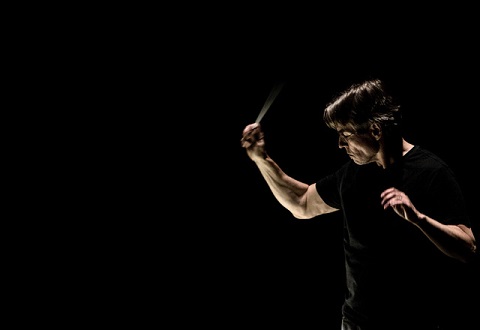 Esa-Pekka Salonen. Photo credit: Minna Hatinen.
Esa-Pekka Salonen. Photo credit: Minna Hatinen.
The Philharmonia’s concert had opened with Debussy’s Ibéria from Images. Again, this is repertoire that the orchestra has long played very well - and this performance was extraordinarily evocative. Although the work sounds undeniably Spanish in character - in its use of castanets and violins strumming pizzicato as if they’re guitars, for example - it’s almost written ‘blind’ in the sense that Debussy never actually visited Spain having derived much of his inspiration for the piece from Parisian street life. Nevertheless, it absorbs a Spanish soundscape, a harmonic foreground in its structure and distinctive melodies that sounds distinctively persuasive. Salonen ensured the dances felt fleet, and the phrasing was bristling with energy.
Donatoni’s ESA (In cauda V), a work which Salonen had commissioned for the Los Angeles Philharmonic, is a piece that almost never happened. Donatoni died very soon after Salonen commissioned the piece - and he assumed he would never receive work, but he did, the composer having dictated from his death-bed the score to some of his students. Salonen in part compares the genesis of the work to Mozart’s Requiem - though Salonen describes ESA as being completely different in mood to Mozart’s piece. In fact, as Salonen mentioned during a brief introduction before the performance how ESA owes more to Bach, including in its use of fugues, and how the music just dies away at the end into a descent into complete silence. This is music that can sometimes sound undeniably brittle, almost constantly in a state of collapse; but it is also vividly orchestrated, even a touch witty at times. I’m not sure in the end I agree with Salonen’s assessment that the work isn’t valedictory - I found it to inhabit a somewhat dark, almost tenebrous world with large opaque chords - albeit ones that are sometimes contrasted with moments that scale back from this. But that sense of the work descending into nothingness, an almost chilling bone-shredding chordal theme dying out on a harpsichord felt like a very final, incomplete moment to me. Either way, the performance given by Salonen and the Philharmonia Orchestra was highly virtuosic, often jaw-droppingly precise and ultimately highly persuasive.
This concert ended with Respighi’s Pines of Rome - and it was quite the way to end it. In a sense this was clever programming, because it kind of tied together some of the themes and ideas which had been heard in some of the music elsewhere in the concert. The fugal, tenebrous sound world of Donatoni gets a look in in the starkly, chant-like world of the ‘Pines near the Catacomb’, whilst the nightingales of the Berio songs are replicated above the astonishing power of Respighi’s Roman army marching into the city through ‘The Pines of the Appian Way’ (though, as I mentioned earlier, they were either inaudible - or missed out completely). There are, it should be said, few things so thrilling in a live concert as the final movement of this work - and the Philharmonia and Salonen were stunning. It wasn’t just the stereophonic placing of brass to the sides of the hall, and high up in the royal box, nor the tremendous timpani, nor even the fact you could actually hear the triangle, it was the pacing that Salonen brought to this. There’s something to be said for the sheer excitement of a faster, more dramatic way to play this music (which Salonen did) - though I have also heard Svetlanov take a much longer amount of time to get through this music when the effect sounded so tense it was almost unbearable. Either way works. The standing ovation, hardly a surprise, was entirely justified.
This concert was recorded by BBC Radio 3 and can be heard on iPlayer until 27th March 2019. I thoroughly recommend it!
Marc Bridle
Marianne Crebassa (mezzo-soprano), Esa-Pekka Salonen (conductor), Philharmonia Orchestra
Royal Festival Hall, London; 28th February 2019.
image=http://www.operatoday.com/Marianne%20Crebassa%20Thomas%20Bartel%20%281%29.jpg
image_description=
product=yes
product_title=Philharmonia Orchestra and Esa-Pekka Salonen at the Royal Festival Hall
product_by=A review by Marc Bridle
product_id= Above: Marianne Crebassa
Photo credit: Thomas Bartel
March 5, 2019
Rossini's Elizabeth I: English Touring Opera start their 2019 spring tour
Donizetti had several stabs at historical non-verisimilitude, in a ‘trilogy’ comprising Anna Bolena (1830), Maria Stuarda (1835) and Robert Devereux (1837), and in an earlier opera, Elisabetta al castello di Kenilworth (1829), based on Walter Scott's Kenilworth, in which Donizetti dramatised Elizabeth I’s infatuation with the young Earl of Leicester.
When one reflects, though, it’s not difficult to see why the Italians might have been so captivated by Tudor treasons and treacheries, for they offered a roll call of fated heroines, copious jealousies and intrigues, and plentiful palaces and posh frocks. Moreover, the hyperbolic emotions on display, from rage and despair, were perfect fodder for coloratura excess. And, of course, many protagonists lose their heads - either literally or in folly and madness. Perhaps, too, the Italians - with their country divided and largely ruled by overseas powers until re-unification in 1861 - empathised with those Tudor Brits who had defied Rome and gone their own way. Focusing on a foreign past was one way to divert the censors who might object to any hint of contemporary political comment.
Unfortunately, Rossini’s Elizabetta, regina d’Inghilterra (1815) is not the best example of bel canto foraging into Elizabethan intrigues. The 23-year-old composer seems to have set out to impress the theatre-goers in Naples with this opera - the first of nine Rossini wrote for the Teatro di San Carlo in Naples - by gathering together some of his ‘best tunes’ to date, for self-borrowings abound. The overture was recycled from the composer’s Aureliano in Palmira (1813) and was put to further use in Il barbiere di Siviglia, and the Queen’s first aria sees her running through the roulades of Rosina’s ‘Una voce poco fa’. The opera was innovative in some regards; for example, Rossini abandoned unaccompanied recitatives, though the accompanied ones that replace them are hardly inspired. Moreover, the casting was determined by Rossini’s need to give star roles to the San Carlo’s legendary ‘three tenors’, who were similarly served in Otello, Armida, La donna del lago and Ricciardo e Zoraide.
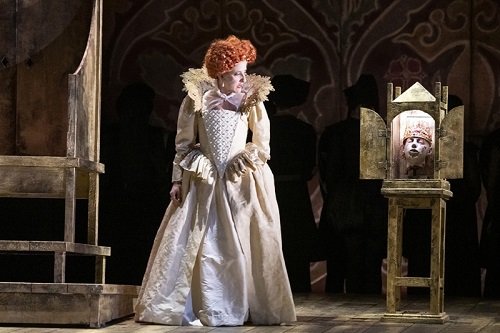 Mary Plazas (Elizabeth I). Photo credit: Richard Hubert Smith.
Mary Plazas (Elizabeth I). Photo credit: Richard Hubert Smith.
So, it was a brave decision by ETO’s General Director James Conway to select Rossini’s opera to open the company’s spring tour of works focusing on the ups and downs of kings and queens. Perhaps Conway should have been braver still? Elizabetta, regian d’Inghilterra seems to demand a period setting, and that’s what we got; but, taking a few more risks - perhaps even updating the action, as Amélie Niermeyer did at the Theater an der Wein in 2017 - might have rustled up a few more dramatic tensions than were evident during this first-night performance.
The libretto was drawn by Giovanni Schmidt from Carlo Federici’s play Il paggio di Leicester (Leicester's Page) - which in turn derived from Sophia Lee’s novel The Recess (1785). The ‘back-story’ is that during her imprisonment by Elizabeth, Mary Queen of Scots secretly married the Duke of Norfolk and had two children by him, Mathilde and Enrico. When fighting the Scots, the Earl of Leicester fell in love with Matilde, whom he at first assumed to be a simple peasant girl, and married her.
The opera begins with the Duke of Norfolk brooding jealously about the rising fortunes of his rival and Leicester’s glory-strewn return to court after his military victory. Leicester, shocked to find his wife - disguised in male dress - and her brother amongst the Scottish hostages, confides in Norfolk who promptly tells Elizabeth, herself enamoured of Leicester, of the secret marriage. Elizabeth makes a public proposal of marriage to Leicester whose inevitable refusal sees all three of the ‘traitors’ marched off to prison. The Queen tries to coerce Matilde into forswearing all claims on Leicester but is thwarted by the Earl’s integrity. Meanwhile, Norfolk tries to stir up rebellion among the populace who are angry at the imprisonment of their favourite, but his efforts to involve Leicester in his treachery are spurned. When Norfolk’s perfidy is exposed, he attacks the Queen but the monarch is saved by the swift intervention of Matilde and Enrico. Norfolk is condemned, everyone else is pardoned, and courtly life gets back to ‘normal’.
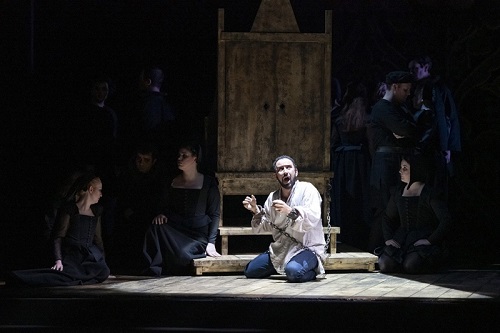 Luciano Botelho (Earl of Leicester). Photo credit: Richard Hubert Smith.
Luciano Botelho (Earl of Leicester). Photo credit: Richard Hubert Smith.
Frankie Bradshaw’s sets are necessarily minimal, given the expediencies of touring, but even so the throne room and royal apartments are bare and barren, with just an outsize wooden chair, elevated baldaquin and Tudor-rose embellished backdrop serving to gesture at the court’s renowned lavishness. Presumably the severed head of Mary Queen of Scots staring blindly from a tabernacle next to throne is intended to infer that murdering one’s rivals doesn’t solve one’s problems. When we move to the prison (in the ‘Tower of London’) in Act 2, the throne is simply moved to the other side of the stage, and Leicester shackled to it. A simple colour scheme suffices: black for the populace, white for the Virgin Queen. The opera does have several moments of considerable dramatic potential, but not all such opportunities were taken by Bradshaw and Conway.
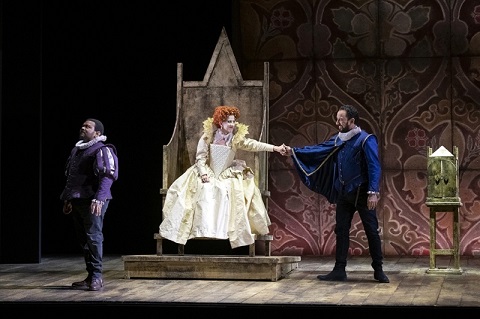 John-Colyn Gyeantey (Duke of Norfolk), Mary Plazas (Elizabeth I) and Luciano Botelho (Earl of Leicester). Photo credit: Richard Hubert Smith.
John-Colyn Gyeantey (Duke of Norfolk), Mary Plazas (Elizabeth I) and Luciano Botelho (Earl of Leicester). Photo credit: Richard Hubert Smith.
Mary Plazas sang confidently in the title role, and despatched the melodic embellishments cleanly, but she did not convincingly convey regality and authoritative hauteur - it didn’t help that she looked somewhat lost when seated in her huge throne - and her tone lent towards shrillness as the pitch rose. Luciano Bothelo was a suave Leicester and displayed a fine spinto voice. Unfortunately, John-Colyn Gyeantey couldn’t match Bothelo for focus and firmness: initially at least, his Norfolk was not as sharp of voice as he was of malevolence, although the tenor did acquire more precision in Act 2. Gyeantey is an ETO regular and at his best in moments of reflection and poise - as illustrated by his fine rendering of Tigrane’s ‘So ch’è vana la speranza’ during ETO’s Radamisto at Snape Maltings last November - but he struggled with the floridity of the Duke’s blustering rages. Lucy Hall was an excellent Matilde, singing with warmth and sincerity - in fact, she was alone in persuading me that she was a ‘real’ person, somewhat paradoxically given that Mathilde is an entirely fictitious addition to the historical plot. In the minor roles of Enrico and Guglielmo (the Queen’s Secretary), Emma Stannard and Josephy Doody acquitted themselves well.
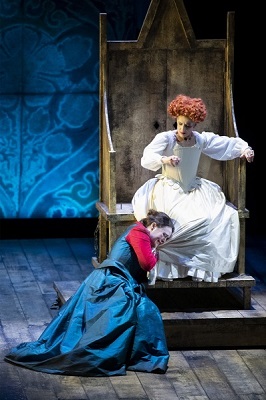 Lucy Hall (Matilde) and Mary Plazas (Elizabeth I). Photo credit: Richard Hubert Smith.
Lucy Hall (Matilde) and Mary Plazas (Elizabeth I). Photo credit: Richard Hubert Smith.
After a somewhat lacklustre overture, in which the horns sounded particularly nervous, the ETO Orchestra played well for conductor John Andrews who was alert to the details of period style. One should give Rossini credit for some vigorous ensemble writing, and the ETO Chorus, after some, understandable, hesitancy at the start were in fine voice. Their blocking was, however, not so admirable, and the stilted mass movement of the Chorus from one static position to another only added to the dramatic woodenness.
So, praise should go to Conway and ETO for their courage and commitment to Rossini’s opera: I’m pleased to have had the opportunity to see and hear it, even if I won’t be rushing back for a second helping. Macbeth and Idomeneo make up ETO’s spring menu of monarchs and machinations, and both should offer more meaty musical fare.
Claire Seymour
Elisabetta - Mary Plazas, Earl of Leicester - Luciano Botelho, Matilde - Lucy Hall, Enrico - Emma Stannard, Duke of Norfolk - John-Colyn Gyeantey, Guglielmo - Joseph Doody; Director - James Conway, Conductor - John Andrews, Associate Director - Rosie Purdie, Designer - Frankie Bradshaw, Lighting Designer - Rory Beaton, ETO Orchestra and Chorus.
Hackney Empire, London; Saturday 2nd March 2019.
image=http://www.operatoday.com/Rossini%20title%20image.jpg image_description= product=yes product_title=Elisabetta, regina d’Inghilterra, English Touring Opera product_by=A review by Claire Seymour product_id= Above: Mary Plazas and the ETO ChorusPhoto credit: Richard Hubert Smith
March 4, 2019
Chameleonic new opera featuring Caruso in Amsterdam
With 19th century Italian opera tunes flowing into Afro-Cuban percussion and chromatic free falls, there is never a dull moment in this fictionalized account of tenor Enrico Caruso’s 1920 visit to Cuba. It has meaty roles for the lead singers too. Regrettably, its world premiere at Amsterdam’s annual Opera Forward Festival was hobbled with a confusing staging that made it hard to keep track of plot, location and minor characters.
Hamel also wrote the Italian libretto, inspired by a novel by the Cuban-Puerto Rican writer Mayra Montero, available in English as The Messenger. When a bomb goes off at a theatre in Havana where Caruso is singing in Verdi’s Aida, an explosion that really happened, he runs outside, into the arms of a local woman, Aida. They fall in love, an event foreseen by her godfather Calazán, who is a priest of the Santería or, more correctly, Lucumí religion. Aida helps Caruso escape the mafia, who is trying to extort money from him, and becomes pregnant with his child. During this romantic, disorienting interlude, Caruso the famous tenor becomes Caruso the man. A ritual dunking in a lagoon fails to restore his peace of mind. Crumbling under stress, he leaves Aida, as he must, to return to his wife and to being a stage and gramophone star. Hamel has fun with 19th-century Italian operatic idiom, quoting from Aida and using Caruso’s own recorded voice, and composing a rousing cabaletta for the lovers. He evokes the tenor’s nostalgia for his youth with a mandolin, adapting the Neapolitan evergreen Torna a Surriento. A synthesizer adds atmospheric sounds, including stylized birdsong. As the story draws to a close, the score becomes progressively less tonal. The opera ends in the antithesis of music, a series of high-pitched tones imitating tinnitus, presaging the tenor’s death the following year.
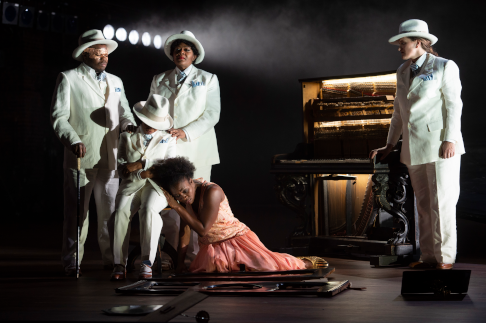
It is a shame that Johannes Erath’s staging did little to elucidate the plot, mostly played out on and around a giant gramophone record, although the cast also spilled into the aisles and side boxes. Whether it was the real Cuba or Caruso’s fevered brain, the set was a dark, dismal place. Video projections added rain and a theatre interior. Alienation techniques such as slow-motion movement and having characters converse with their backs to each other worked against the singers’ emotional engagement. Design visuals were also murky, drowning secondary characters into a sea of interchangeable suits. And it shouldn’t be necessary to consult the program booklet to discover that a giant scallop shell refers to a Lucumí fortune-telling method involving a seashell necklace. When not inflicting spectator fatigue, the staging was often downright silly. The audience tittered when the bomb, its shell printed with Caruso’s name, descended gingerly from the theatre ceiling before exploding. The banal, manic choreography reached its nadir with jazz hands during the lagoon ritual. Perplexingly, orchestral intermezzi were played to a closed curtain, even when the scenery didn’t change. Thank goodness for the performances.
Although not always dead on pitch, a zesty Netherlands Chamber Orchestra, led by Otto Tausk, delivered a vibrantly robust performance. The cast was equally fired up. Airam Hernández may not be the reincarnation of Caruso, but he’s a tenor and a half with a full-blooded Italianate sound. He sang like he believed he could be the greatest tenor of his time, and so we believed it too, relishing his burnished lyricism. Aida is a challenging role, requiring technical and stylistic virtuosity. Soprano Jeanine De Bique inhabited it with tenacious passion, vocal deftness and a beguiling stage presence. Just as striking was mezzo-soprano Tichina Vaughn as her mother, who created a potent scene when warning the lovers not to defy the gods. As Calazán, Simon Shibambu intoned his prophecies with a deep, steady legato.
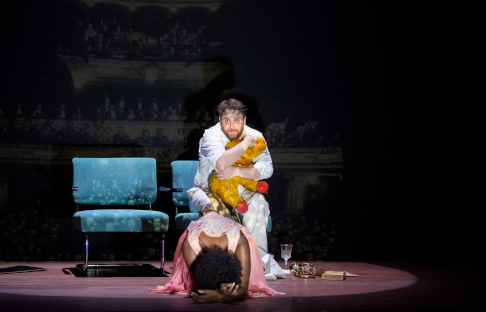
The supporting cast, taking on multiple roles, sparked with energy, but neither blocking nor costumes helped with sorting out which singer was playing which character at which point. Woolly bass Gabriel Rollinson portrayed an assortment of shady and upright characters. Bass-baritone Cody Quattlebaum and baritone Michael Wilmering sang with devilish gusto as, respectively, Caruso’s manager and the opera impresario. Eva Kroon’s mezzo was beautiful and buttery. We know she played a cook because the credits told us so, although she did mention "my kitchen". Perhaps the stage direction and design should not get all the blame for the blurriness. Could the two-hour one-acter have benefitted from having fewer characters? The libretto does get a bit tangled at the end, with various characters making various mystical pronouncements. On the other hand, its language also becomes more poetic, in keeping with the focus zooming inward into Aida and Caruso’s psyches. Hamel’s music certainly deserves a wider audience. Several excerpts called for a second hearing, even as standalone numbers. Besides the mother’s dramatic solo, there is an originally constructed love duet, with a stormy orchestral refrain interrupting the lovers’ exchanges. The impressive vocal ensemble accompanying the underwater ritual flared into a wild percussive climax. And Aida’s piercing monologue, delivered by De Bique with a glass-like fragility, was the best thing about the finale.
Jenny Camilleri
Cast and production information:
Enrico Caruso, Famous Singer: Airam Hernández; Aida, Girl: Jeanine De Bique; Calazán, Aida’s Godfather: Simon Shibambu; Bruno Zirato, Caruso’s Manager and Assistant: Cody Quattlebaum; Adolfo Bracale, Impresario/Reporter/Ritual Singer: Michael Wilmering; Aida’s Mother/Ritual Singer: Tichina Vaughn; Cook/Woman/Ritual Singer: Eva Kroon; Arturo Cidre/Intruder/Tata/Ritual Singer: Gabriel Rollinson. Director: Johannes Erath; Set Design: Katrin Connan; Costume Design: Noëlle Blancpain; Lighting Design: Bernd Purkrabek; Video: Bibi Abel. Conductor: Otto Tausk. Netherlands Chamber Orchestra. Seen at Internationaal Theater Amsterdam, Amsterdam, on Sunday, the 3rd of March, 2019.
image=http://www.operatoday.com/De%20Nationale%20Opera%20Caruso%20a%20Cuba%20-%20credits%20Monika%20Rittershaus%20217.png image_description=Scene from Caruso a Cuba [Photo © Monika Rittershaus] product=yes product_title=Chameleonic new opera featuring Caruso in Amsterdam product_by=A review by Jenny Camilleri product_id=Above: Scene from Caruso a CubaPhotos © Monika Rittershaus
March 3, 2019
Ernst Krenek: Karl V, Bayerisches Staatsoper
This opera and, indeed, most of Krenek’s work before he left his roots, confronts the anguish of a world in chaos : the certainties of the Old Order replaced by unprecedented and often dangerous change. After the end of the First World War, Austria was no longer part of an Empire, and Austrians, like Krenek, had to reconsider their place in the world. Please also see my piece on Krenek’s song cycle Reisebuch aus den österreichischen Alpen, where the composer assesses Lieder at a time when the Nazis were just coming to power…Krenek’s opera isn’t an examination of the past but a commentary on his own times, and is still prescient in our own.
Krenek’s Karl V is based on the last hours of the life of Charles V, Hapsburg King of Spain and the Americas, Holy Roman Emperor and conqueror of the Turks: the first multi-national world empire, which easily surpassed in scale the original Roman Empire. It prospered through war and political intrigue, fuelled by the brutal exploitation of other empires across the world. Yet, after a long and eventful reign, Charles V abdicates, of his own will, and retreated to the monastery San Jerónimo de Yuste. Yet he can find no peace. Instead, he faces the greatest challenge of his life: how will he face his conscience before God?
Krenek’s Karl V isn’t realistic narrative, but an ethical and philosophical exploration, with words and music. Structurally the opera operates on multiple levels and multiple dimensions, constantly moving back and forwards in time. Since Karl V predates Berg’s Lulu , Krenek could have invented opera as cinema. Certainly he, like Berg, was interested in modern art, modern ideas and the movies. Just as in film, orchestral music occurs mainly at critical junctures where voices are stilled, such as the beginning of the final act. Though Krenek uses dodecaphonic form, Karl V connects to devotional practice which would have been familiar to the devout. Krenek also employs Sprechstimme throughout to emphasize the philosophic ideas in the text. Singing, in the normal sense, would distract, and normal speech would be too mundane. Eventually your ears adjust and the Sprechstimme becomes effortlessly natural.
In his sanctuary, Charles hears the voice of God himself, calling him to account. Thus Skovhus is costumed, in this Fura dels Baus productioned directed by Carlus Padrissa, costumes by Lita Cabellut, Skovhus is dressed not as a monarch but as a juggler whose cap has pointed horns on his head, like a crown seen askew. Before God, no mortal is mighty. In Krenek’s libretto (which he wrote himself), images of Time and Destiny recur : thus the images of clocks, globes, glass (strong but breakable) that inform the staging. The opening sequence is astonishing - the acrobats and dancers that are La Fura dels Baus’s forte, emerge from the darkness, moving, twisting and re-forming. There is purpose behind this, almost impossible to achieve with quite the panache we saw here. This represents Titian’s painting The Last Judgement, which Charles V treasured. What could be more appropriate for Charles’s own Judgement ? If some modern audiences don’t like cultural or intellectual references, maybe Art is beyond them. Or God, for that matter. Significantly, Krenek mentions the painting in the libretto : it is the cohesive image that pulls everything together.
With his confessor Juan de Rega (Janus Torp) beside him, he examines his conscience through a series of vignettes, symbolized by key figures in his past. His mother Juana (Okka von Dammerau) appears. Though Juana was Queen of Castile and Aragon, she became insane: so much for wealth and power. Charles relives an event where he’s given an apple, within which there is a worm: an allegory if ever there was one. Charles re-encounters Martin Luther (Michael Krauss) who defied the Pope. The Reformation that followed was the beginning of the end for the Holy Roman Empire, and indeed of Hapsburg hegemony in the Netherlands and German-speaking countries. Yet Charles did not condemn. In the opera, he refuses to desecrate Luther’s tomb. Will this act of decency balance the damage? Charles is surrounded by enemies: from within the Church, from France and from the Turks. His sister Elenore (Gun Brit-Barkmin) appears. He arranged a dynastic marriage for her with Francis I (Wolfgang Ablinger-Sperrhacke) of France, but it brought her sorrow, not happiness. It didn’t bring peace, either. Francis made an alliance with Suleiman and the Turks against Austria. That, too, is on Charles’s conscience, though Elenore later hints at another more secretive trauma: while in France, Charles had some kind of sexual encounter. Since Charles had been devoted to his wife Isabella (Anne Schwanewilms) and esteemed chastity, that sin might have weighed more heavily on Charles than on other men, like the less moral Francis. Charles responds tenderly to his vision of Isabella, but she’s long dead, caged in a frame that suggests a skeleton. Pizarro (Kevin Connors, in multiple parts) returns with plunder from the Americas. Charles knows this gold was won by bloodshed. Could he have changed anything? Another dilemma: wealth or guilt. Finally, Charles cracks and has a seizure and the First Part is brought to an abrupt end.
In the Second Part, Charles lies in “The Vale of Tears”, i.e. a coma, drifting ever further from reality. Now Krenek’s orchestration proves its value, commenting without words. Mysteriously beautiful, searching sounds suggest that, while Charles V’s body is in a comatose state, his soul is traversing the universe: the spirit of religious music in modern abstraction. All his life, Charles dedicated himself to the service of the Church but even that’s imploding around him. What hope has Charles of beating the Turks when he can’t count on fellow Catholics? Treachery and intrigue everywhere, Moritz of Saxony, Charles’s protégé, betrays him by leading Protestant insurrection. Even on his deathbed, Charles is taunted by his supposed friend Francesco Borgia (Scott MacAllister). Only Elenore and Ferdinand, Charles’s brother (Dean Power) offer mercy. Charles was vilified because few understood his motivations, which were ultimately altruistic. “I did not want to make the State a new tin God”, he says, “True unity lies in a belief in the Eternal. Everything earthly is an elusive bond”. Does Charles, with his ideas of unity and fairness, live in a bygone age? But Krenek also adds the phrase “or maybe he lives 400 years in the future”. The German choruses chant “We don’t want to be citizens of the world!” A Turkish astrologer sees a star disintegrate. “A good omen” chuckles the Sultan (Peter Lobert). “The people of Europe are free, and they will use this freedom to fight among themselves even more brutally.” The Three Ghosts (and the Three Clocks) appear as Charles’s mind starts to disintegrate. Has he faced his conscience? Would he have been in any position to change what happened? Things might not have worked out but at least his intentions were good, and to that, he was true.
Though this new production might seem controversial, it is a lot closer to the meaning and form of Krenek’s work than the Bregenz production conducted by Lothar Koenigs and directed by Uwe Eric Laufenberg production with Dietrich Henschel, available on DVD. Bo Skovhus is superb in the title role, expressing both the anguish and dignity in the role, carrying off the Sprechstimme with aplomb. The other roles are supportive, though critical. Anne Schawnenwilms will draw international audiences. But Okka Van Dammerung and Gun-Brit Barkmin are rising stars of their generation, well worth listening out for, both very impressive here. Wolfgang Albinger-Sperrhacke shows why he’s one of the great character tenors of our time, creating a Francis at one neurotic and majestic. In these times a more apocalyptic approach to this opera is not only valid, but reflects the background in which Krenek conceived it. Thank goodness Krenek isn’t still alive to see the world fall apart all over again! And la Fura dels Baus make Titian come alive in all his swirling baroque glory, laced with menace.
Anne Ozorio
image=http://www.operatoday.com/csm_20190208_Bayerische_Staatsoper__Karl_V.__B._Skovhus_c_W._Hoesl___13__f23ade8760.jpg image_description=Bo Skovhus as Karl V [Photo © W. Hoesl] product=yes product_title=Ernst Krenek : Karl V. Erik Nielsen conductor, Bo Skovhus, Okka von Dammerung, Gun-Brit Barkmin, Anne Schwaneilms, Wolfgang Ablinger-Sperrhacke, Livestreamed from Bayerisches Staasoper, 23rd February, 2019. product_by=A review by Anne Ozorio product_id=Above: Bo Skovhus as Karl V [Photo © W. Hoesl]A Sparkling Merry Widow at ENO
In an age of Brexit, Trump and #MeToo, one doesn’t have to work too hard to see how Franz Lehár’s 1905 operetta The Merry Widow - so often seen as a metaphor for the escapist glamour of the Belle Époque - might seem relevant to modern times, as we waltz towards the cliff-edge. And, the new English book and lyrics by April De Angelis and Richard Thomas respectively, which this new ENO production employs, do indeed offer a smattering of topical and pseudo-subversive gestures, at least in the opening Act. The Counsellor to Baron Mirko Zeta, the Pontevidrin Ambassador in Paris, drily notes that their country’s government is one that no other nation will do business with, raising sniggers and sighs among the Brexit-weary Brits in the audience. Our prototype feminist heroine is a Cockney lass (her drawl slightly at odds with the Americanisms in the lyrics), and it’s certainly the women who hold the purse and the power: even the grisettes who perform at Maxim’s grumble as they gyrate, and sport silver boots with attitude.
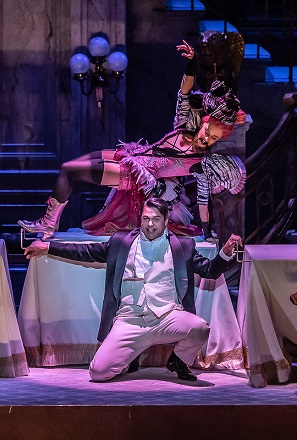 Nathan Gunn (Danilo). Photo credit: Clive Barda.
Nathan Gunn (Danilo). Photo credit: Clive Barda.
However, as Edmond Taylor observed in The Fall of The Dynasties: The Collapse Of The Old Order, 1905-1922 , ‘In retrospect we tend to see the carefree social life of pre-war Europe as a kind of death waltz on the brink of doom, but to those who took part in it, it was not that at all. People did not throw themselves into a rout of pleasures to forget their worries; they simply joined in the dance to express their sense of well-being and to manifest their solidarity.’ And, it’s not really the ‘topicality’ of Max Webster’s production that strikes one, but its ‘theatricality’: this is a stagey and sumptuous broad comedy that will please the crowd rather than challenge the old order.
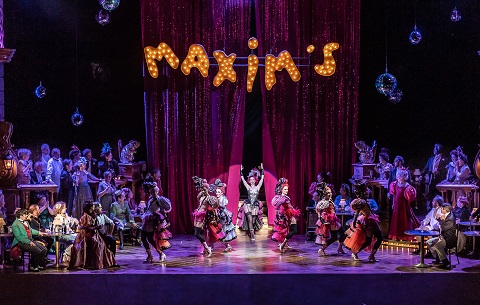 At Maxim’s, Act 3. Photo credit: Clive Barda.
At Maxim’s, Act 3. Photo credit: Clive Barda.
The show is certainly colourful, glitzy and pacy, lavishly rendered by designers Ben Stones (sets), Bruno Poet (lighting) and Esther Bialas (costumes). The décor at Maxim’s is more Toulouse Lautrec than Art Nouveau and riotous razzamatazz is provided by an ensemble of eleven dancers who can-can with panache (choreography by Lizzi Gee). Moreover, if Maxim’s has morphed into the Moulin Rouge then Hanna has had a ‘Howard Hawks make-over’ and borrows Marilyn Monroe’s iconic pink gown for her staircase entrance, flanked by tuxedoed suitors.
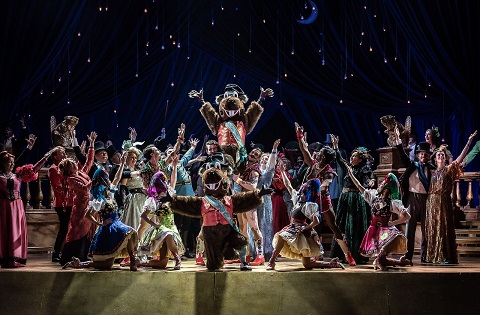 Photo credit: Clive Barda.
Photo credit: Clive Barda.
The flashy ostentation is complemented by slick farce, which commences in the overture as the clerk Njegus (Gerard Corey) ‘oversees’ preparations for the Embassy banquet with masterly timed slapstick buffoonery worthy of The Play That Goes Wrong. With an outsize beaver gazing down from a wall-mounted pictorial homage to the Pontevdrin national animal, the tone is set for the Act 2 party at Hanna’s, where the celebrations of the country’s historic cultural traditions are supplemented by two dancing, grinning beavers who would do Walt Disney proud. After an assignation in a broom cupboard - we’re in the realm of 1970s sit-com here - the Baron’s wife, Valencienne, carries on her liaison with the French attaché to the Embassy, Count Camille de Rosillon, not in the garden pavilion as expected, but under the banquet table, their not-so-covert amorous activities accompanied by quivering jellies and rattling cutlery. The double entendres fly as thick and fast as the toilet humour: we all know what happens when the proverbial hits the fan. Indeed, the men gather to lament and denounce ‘Women! Women! Women!’ in the urinals, literally ‘spraying’ their insults in all directions.
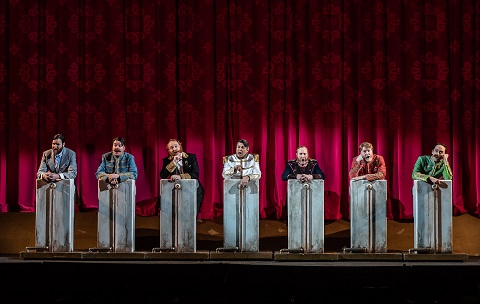 Men’s septet. Photo credit: Clive Barda.
Men’s septet. Photo credit: Clive Barda.
It’s all jolly fun, if at times rather too flippant. However, the Coliseum is a big barn in which to ensure that the minutiae of the mayhem make their mark, and despite the amplification of the spoken text (which didn’t always fade successfully into the sung numbers) there were times when the voices and the verbal keenness didn’t quite carry. Ironically, the initial froth of the orchestral overture and the flashiness of the cerise front-curtain fade to a cool grey-green when we enter the Embassy, for ‘austerity cutbacks’ mean that the central-heating is off and there’s no food for the feast. Later this summer ENO will reprise last year’s Paul Bunyan at the Alexander Palace Theatre, and it struck me that either this, or Wilton’s Music Hall where that production was first seen, would more readily provide the necessary shabby chic ambience, in a setting of more appropriate dimensions.
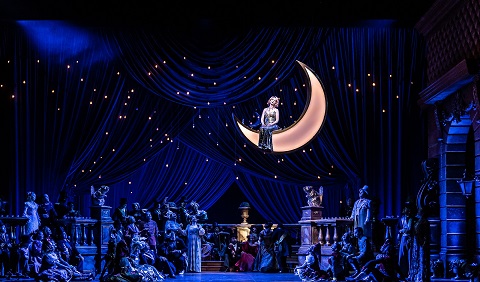 Sarah Tynan (Hanna). Photo credit: Clive Barda.
Sarah Tynan (Hanna). Photo credit: Clive Barda.
That said, the first and principal prerequisite for a successful Merry Widow is glamour and allure in the title role, and Sarah Tynan provided the necessary flirtatious fascination demanded of her, alongside comic nous and some impressive dance skills. She also provided a much-needed moment of respite from the frantic antics, bravely perching upon a floating crescent moon to sing her ‘Vilja’ and out-gleaming its beams with silvery threads which ebbed and waned with exquisite care and control, and with bitter-sweet beauty. As her somewhat jaded paramour, Count Danilo Danilowitsch, Nathan Gunn mixed a dash of debonair with a dose of dorkiness, but while he projected well in the Coliseum, I lacked a sense of true chemistry between this Danilo and Hanna. The same was true for Rhian Lois’s Valencienne and Robert Murray’s Camille: their duets were well-sung, but it felt as if they were acting rather than feeling the professed emotions. Andrew Shore, as always, judged the Baron’s myopic folly to a tee, never mocking him too cruelly. The Chorus were in fine voice.
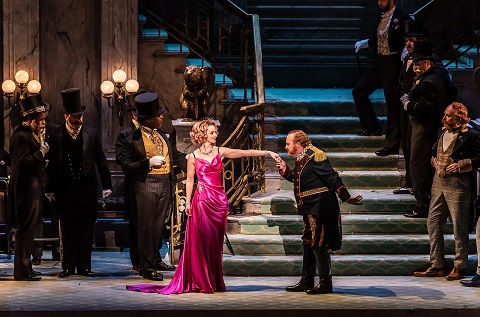 Sarah Tynan (Hanna) and Andrew Shore (Baron Mirko Zeta). Photo credit: Clive Barda.
Sarah Tynan (Hanna) and Andrew Shore (Baron Mirko Zeta). Photo credit: Clive Barda.
This production may have the girls, the glamour and the grandeur but if The Merry Widow is to truly touch our hearts, then it’s the symbolism of the waltz - an intimate interaction between two interdependent individuals, wordless and private - which must make an impact. After all, it is only through music and dance that Danilo finds a way to ‘speak’ to Hanna of his love. I’m not convinced that Webster communicates this intimacy, though conductor Kristiina Poska certainly drew stylish, sumptuous and lithe playing from the ENO Orchestra.
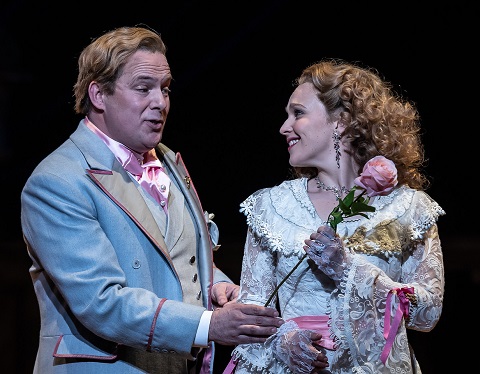 Robert Murray (Camille) and Rhian Lois (Valencienne). Photo credit: Clive Barda.
Robert Murray (Camille) and Rhian Lois (Valencienne). Photo credit: Clive Barda.
Franz Lehár had already achieved some success and popularity, with waltzes and operettas, before Die lustige Witwe became the most widely performed operetta ever, acclaimed across Europe and in the US. This ENO production might not be quite such a triumph: the first 1906 London production ran for 778 performance, and followed by extensive tours, in places as distant as Calcutta and Rangoon. But, it will bring much enjoyment to audiences at the Coliseum. Moreover, stage and sheet-music royalties quickly made Lehár a multi-millionaire; let’s hope it has the same effect on ENO’s coffers.
Claire Seymour
Franz Lehár: The Merry Widow
Hanna Glawari - Sarah Tynan, Count Danilo Danilowitsch - Nathan Gunn, Baron Mirko Zeta - Andrew Shore, Camille de Rosillon - Robert Murray, Valencienne - Rhian Lois, Vicomte Cascada - Nicholas Lester, Raoul de St Brioche - Jamie MacDougall, Njegus - Gerard Carey, Bogdanowitsch - Paul Sheehan, Sylviane - Lydia Marchione, Kromow - Adam Sullivan, Olga - Deborah Davison, Pritschitsch - Trevor Eliot Bowes, Praskowia - Natalie Herman’; Director - Max Webster, Conductor - Kristiina Poska, Set designer - Ben Stones, Costume designer - Esther Bialas, Lighting designer - Bruno Poet, Choreographer - Lizzi Gee, Orchestra and Chorus of English National Opera.
English National Opera, Coliseum, London; Friday 1st March 2019.
image=http://www.operatoday.com/Hanna%20entrance%20Clive%20Barda.jpg image_description= product=yes product_title=The Merry Widow, English National Opera product_by=A review by Claire Seymour product_id= Above: Sarah Tynan (Hanna) and ENO castPhoto credit: Clive Barda